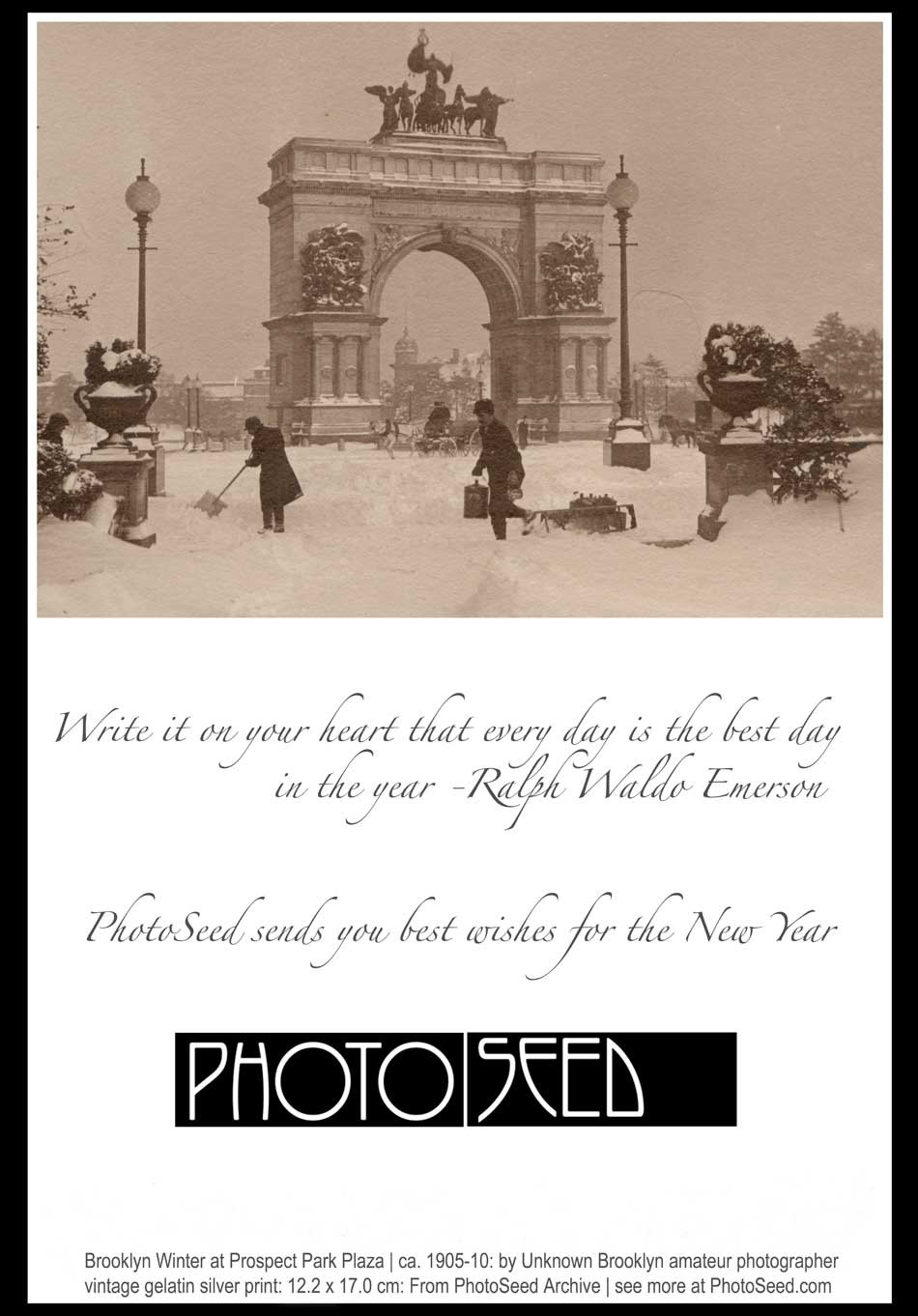Category
New Additions
50 entries in this category | view all categories
Goodbye, Sagamore Farm
Posted October 2018 in Alternate Processes, Childhood Photography, New Additions, Painters|Photographers, Scientific Photography
I recently trekked to the New Hampshire seacoast to investigate the origins of two cyanotype photogram albums recently posted to this site. There, botanical specimens gathered by Helen Chase Gage when she was a child on her family’s country estate known as “Sagamore Farm” in Rye, New Hampshire were compiled during the summer months of 1929 and 1930.
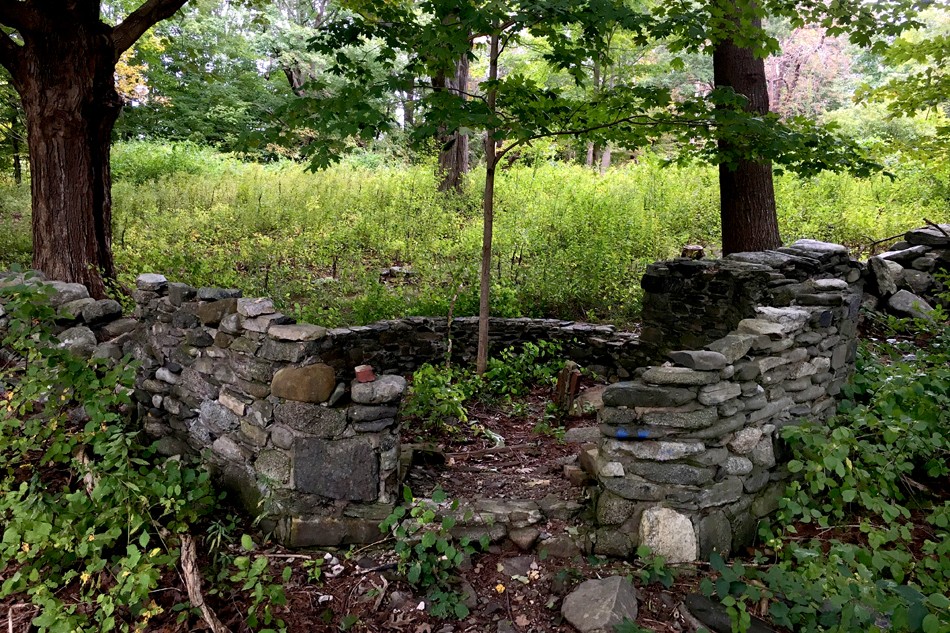 At Odiorne Point State Park in Rye, New Hampshire, remnants of foundation walls belonging to "Sagamore Farm" can be seen in this view looking west towards the seacoast photographed October 1, 2018. Helen Chase Gage (Miller) 1917-1982 was a schoolgirl when she roamed near here during the summers of 1929 & 1930 collecting botanical specimens used to make two albums of cyanotype photographs. The estate, a grand sixteen-room summer home built in 1892 by Dr. William Duncan McKim, (1855-1935) was purchased by Helen's parents in 1918 and eventually condemned and demolished by the US Federal Government in 1942 with other homes in order to build Fort Dearborn, which provided a coastal defense for the United States on the Atlantic seaboard during and after the World War II era. Photo by David Spencer for PhotoSeed Archive.
At Odiorne Point State Park in Rye, New Hampshire, remnants of foundation walls belonging to "Sagamore Farm" can be seen in this view looking west towards the seacoast photographed October 1, 2018. Helen Chase Gage (Miller) 1917-1982 was a schoolgirl when she roamed near here during the summers of 1929 & 1930 collecting botanical specimens used to make two albums of cyanotype photographs. The estate, a grand sixteen-room summer home built in 1892 by Dr. William Duncan McKim, (1855-1935) was purchased by Helen's parents in 1918 and eventually condemned and demolished by the US Federal Government in 1942 with other homes in order to build Fort Dearborn, which provided a coastal defense for the United States on the Atlantic seaboard during and after the World War II era. Photo by David Spencer for PhotoSeed Archive.
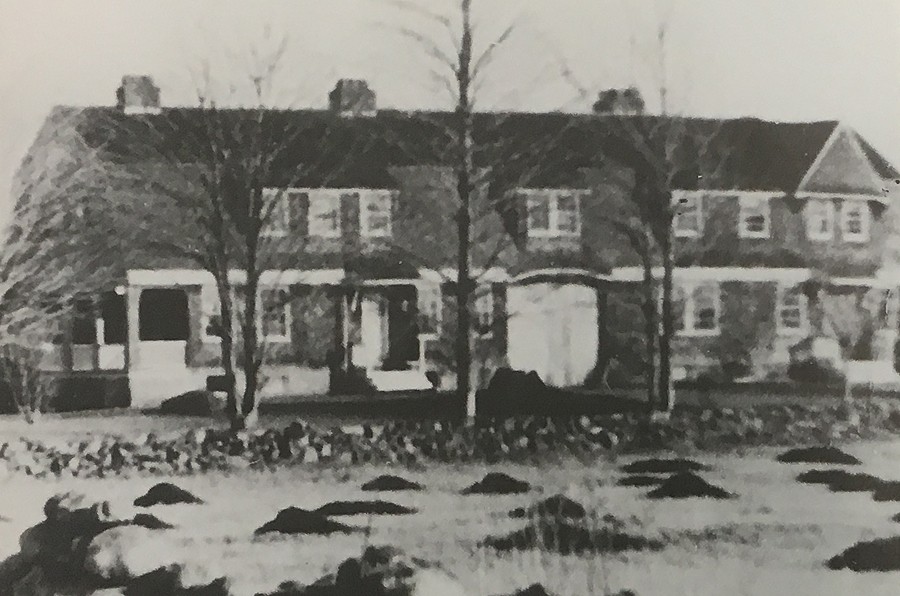 A surviving photograph of "Sagamore Farm" located in Rye New Hampshire, the summer country home where schoolgirl photographer Helen Chase Gage made her cyanotype albums during the summers of 1929-30. A sixteen-room home originally built in 1892 by Dr. William Duncan McKim, (1855-1935) it's described in the 1994 volume Footprints in Time: A Walk where New Hampshire Began as: "This was a large house with two matching sides separated by a porte cochere (a carriage drive-through) which went through the house to the large barn behind." Notice the stone wall in front of the home, indicating the presence of farm fields that criss-crossed the future Odiorne Point State Park property. Photo courtesy Seacoast Science Center.
A surviving photograph of "Sagamore Farm" located in Rye New Hampshire, the summer country home where schoolgirl photographer Helen Chase Gage made her cyanotype albums during the summers of 1929-30. A sixteen-room home originally built in 1892 by Dr. William Duncan McKim, (1855-1935) it's described in the 1994 volume Footprints in Time: A Walk where New Hampshire Began as: "This was a large house with two matching sides separated by a porte cochere (a carriage drive-through) which went through the house to the large barn behind." Notice the stone wall in front of the home, indicating the presence of farm fields that criss-crossed the future Odiorne Point State Park property. Photo courtesy Seacoast Science Center.
 "Sweet Alyssum" (Lobularia maritima) Helen Chase Gage- American: 1917-1982; Cyanotype: 1930: (18.0 x 12.9 | 21.6 x 14.6 cm) Inscribed on opposite album page: Sweet Alyssum Blue Print made August 17, 1930 At Sagamore Farm, N.H. By Helen C. Gage. From: PhotoSeed Archive
"Sweet Alyssum" (Lobularia maritima) Helen Chase Gage- American: 1917-1982; Cyanotype: 1930: (18.0 x 12.9 | 21.6 x 14.6 cm) Inscribed on opposite album page: Sweet Alyssum Blue Print made August 17, 1930 At Sagamore Farm, N.H. By Helen C. Gage. From: PhotoSeed Archive
Known today as Odiorne Point State Park, Helen’s family summer home was located on land at Frost Point at the mouth of the Piscataqua River and Gulf of Maine. In 1942 during World War II, the US federal government appropriated nearly 265 acres making up the future park boundaries through eminent domain, including the Sagamore Farm estate and other properties owned by 24 families. (11 homes are said to have been demolished) This was done in order to build Fort Dearborn, a coastal outpost manned by large gun emplacements designed to protect the nearby Portsmouth Naval Ship Yard on the Piscataqua.
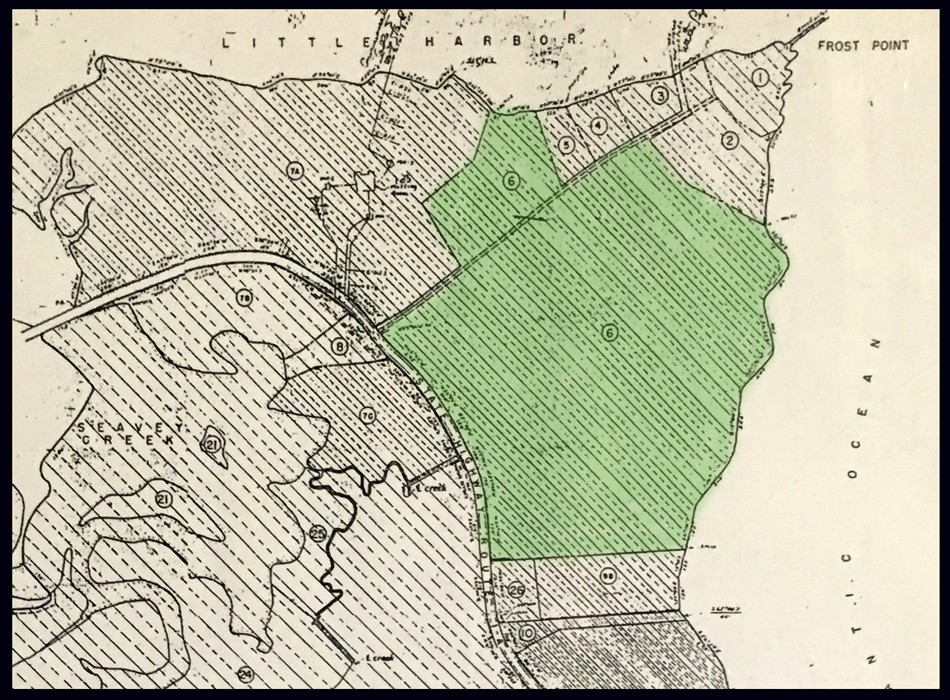 This ca. 1942 US War Department map shows the future area of Odiorne Point State Park in Rye, New Hampshire. Using the color green, this website has shaded the parcel belonging to photographer Helen Chase Gage's family- 43.6 acres. The US Government appropriated nearly 265 acres owned by 24 families through eminent domain in order to build Fort Dearborn, which took three years to complete. Graphic courtesy Seacoast Science Center.
This ca. 1942 US War Department map shows the future area of Odiorne Point State Park in Rye, New Hampshire. Using the color green, this website has shaded the parcel belonging to photographer Helen Chase Gage's family- 43.6 acres. The US Government appropriated nearly 265 acres owned by 24 families through eminent domain in order to build Fort Dearborn, which took three years to complete. Graphic courtesy Seacoast Science Center.
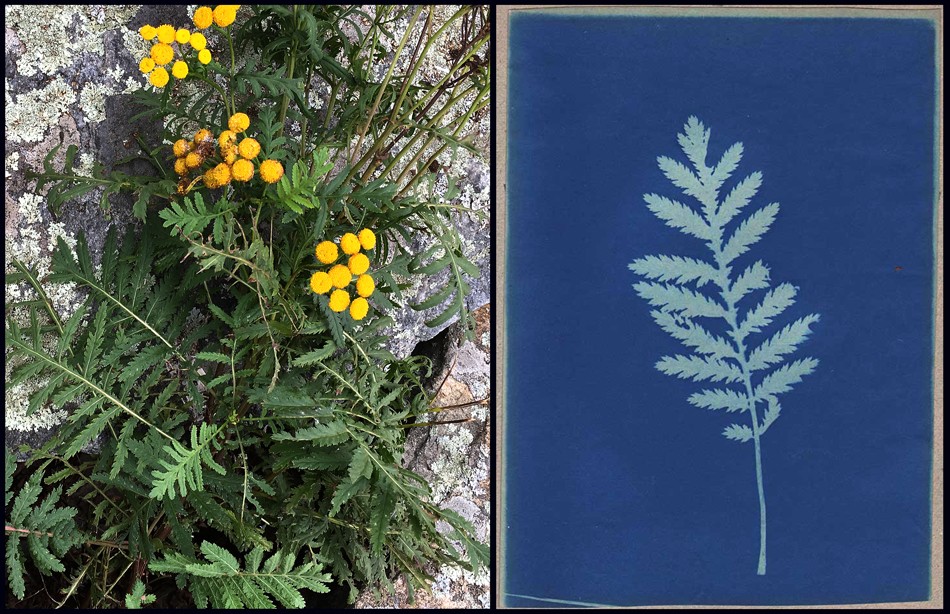 Left: Tansy flowers in bloom at Odiorne Point State Park in Rye, New Hampshire photographed October 1, 2018. Photo by David Spencer for PhotoSeed Archive. Right: "Tansy" (Tanacetum vulgare) Helen Chase Gage- American: 1917-1982; Cyanotype: 1929: (17.6 x 12.5 | 30.0 x 22.8 cm) Inscribed on same album page: Tansy: Blue Print made on July 17, 1929 at Sagamore Farm By Helen C. Gage. From: PhotoSeed Archive
Left: Tansy flowers in bloom at Odiorne Point State Park in Rye, New Hampshire photographed October 1, 2018. Photo by David Spencer for PhotoSeed Archive. Right: "Tansy" (Tanacetum vulgare) Helen Chase Gage- American: 1917-1982; Cyanotype: 1929: (17.6 x 12.5 | 30.0 x 22.8 cm) Inscribed on same album page: Tansy: Blue Print made on July 17, 1929 at Sagamore Farm By Helen C. Gage. From: PhotoSeed Archive
 This granite marker on the coastline at Odiorne Point State Park marks the location in the Spring of 1623 where English immigrant David Thomson (1593-1628) of Plymouth, England established the first European settlement on land that would become the future American state of New Hampshire. Originally installed in 1899, the marker was eventually moved but re-installed and re-dedicated in its' original spot in 2007: "Here Landed In the Spring of 1623 The First Band of Englishmen. Pioneers in The Planting of New Hampshire. Consecrating This Soil to The Service of God and Liberty. Photographed on October 1, 2018 by David Spencer for PhotoSeed Archive.
This granite marker on the coastline at Odiorne Point State Park marks the location in the Spring of 1623 where English immigrant David Thomson (1593-1628) of Plymouth, England established the first European settlement on land that would become the future American state of New Hampshire. Originally installed in 1899, the marker was eventually moved but re-installed and re-dedicated in its' original spot in 2007: "Here Landed In the Spring of 1623 The First Band of Englishmen. Pioneers in The Planting of New Hampshire. Consecrating This Soil to The Service of God and Liberty. Photographed on October 1, 2018 by David Spencer for PhotoSeed Archive.The area is rich in American history: at Odiorne Point within the present-day state park, a large granite marker (installed 1899 |rededicated 2007) marks the location in the Spring of 1623 where English immigrant David Thomson (1593-1628) of Plymouth, England established the first European settlement on land that would become the future American state of New Hampshire.
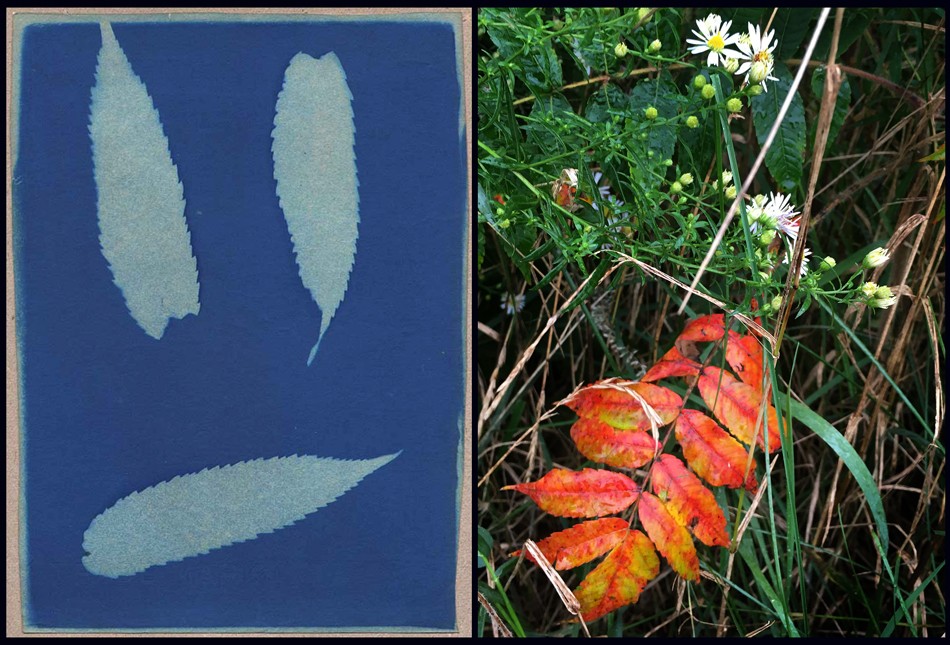 Left: "Sumack" (Rhus coriaria?) Helen Chase Gage- American: 1917-1982; Cyanotype: 1929: (18.0 x 13.0 cm | 21.6 x 14.6 cm) Inscribed on album page: Sumack: Blue Print made on July 23, 1929 at Sagamore Farm By Helen C. Gage. From: PhotoSeed Archive. Right: Sumac leaves from a shrub showing off their fall colors at Odiorne Point State Park in Rye, New Hampshire photographed October 1, 2018. Photo by David Spencer for PhotoSeed Archive.
Left: "Sumack" (Rhus coriaria?) Helen Chase Gage- American: 1917-1982; Cyanotype: 1929: (18.0 x 13.0 cm | 21.6 x 14.6 cm) Inscribed on album page: Sumack: Blue Print made on July 23, 1929 at Sagamore Farm By Helen C. Gage. From: PhotoSeed Archive. Right: Sumac leaves from a shrub showing off their fall colors at Odiorne Point State Park in Rye, New Hampshire photographed October 1, 2018. Photo by David Spencer for PhotoSeed Archive.
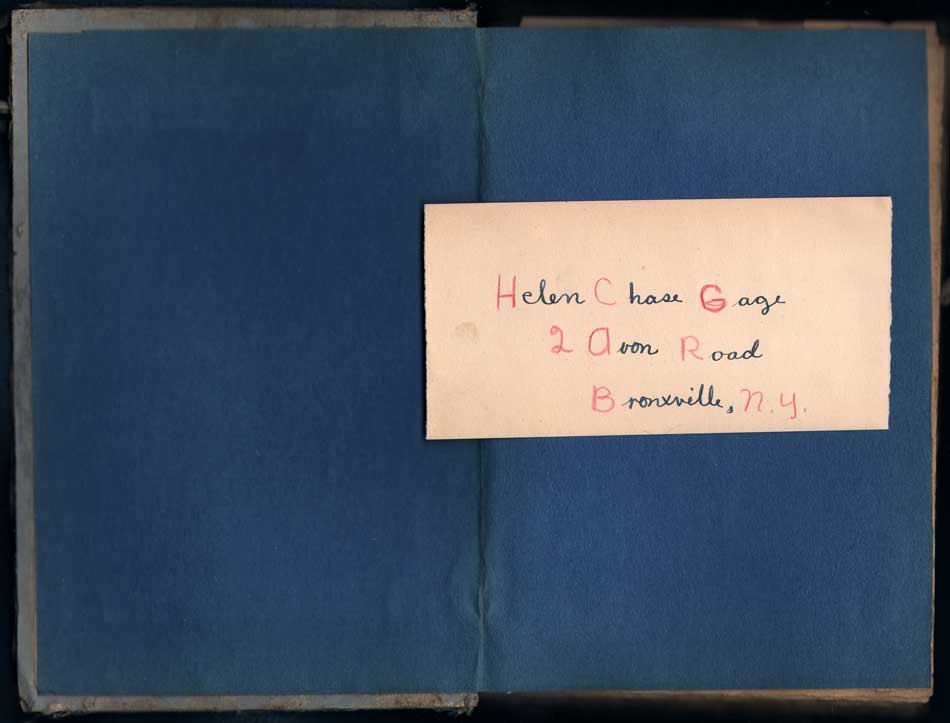 Helen Chase Gage hand-drawn calling card inserted within 1930 Blue Print album of botanical specimen photograms: Helen Chase Gage- American: 1917-1982: This hand-made album is shown opened with the front pastedown made from blue art paper extending full width of opened volume. Overall dimensions: 23.0 x 30.0 cm : Calling card: 7.6 x 15.1 cm. Helen Chase Gage spent her early childhood at 2 Avon Road in Bronxville, New York but assembled this album and another in 1929 at Sagamore Farm in Rye, New Hampshire. From: PhotoSeed Archive
Helen Chase Gage hand-drawn calling card inserted within 1930 Blue Print album of botanical specimen photograms: Helen Chase Gage- American: 1917-1982: This hand-made album is shown opened with the front pastedown made from blue art paper extending full width of opened volume. Overall dimensions: 23.0 x 30.0 cm : Calling card: 7.6 x 15.1 cm. Helen Chase Gage spent her early childhood at 2 Avon Road in Bronxville, New York but assembled this album and another in 1929 at Sagamore Farm in Rye, New Hampshire. From: PhotoSeed Archive
 "Larkspur" (Scientific name: Delphinium; Family: Ranunculaceae) Helen Chase Gage- American: 1917-1982; Cyanotype: 1930: (17.7 x 12.6 cm | 21.6 x 14.6 cm x2) Inscribed on opposite album page: Larkspur: Blue Print made August 10, 1930 At Sagamore Farm By Helen C. Gage. This representative album spread from Helen's 1930 collected cyanotypes is unusual because the original collected botanical specimens are featured as part of the volume. Thirty-one individual prints are included within the album closed by means of cloth ties, seen at far right of frame. From: PhotoSeed Archive
"Larkspur" (Scientific name: Delphinium; Family: Ranunculaceae) Helen Chase Gage- American: 1917-1982; Cyanotype: 1930: (17.7 x 12.6 cm | 21.6 x 14.6 cm x2) Inscribed on opposite album page: Larkspur: Blue Print made August 10, 1930 At Sagamore Farm By Helen C. Gage. This representative album spread from Helen's 1930 collected cyanotypes is unusual because the original collected botanical specimens are featured as part of the volume. Thirty-one individual prints are included within the album closed by means of cloth ties, seen at far right of frame. From: PhotoSeed Archive
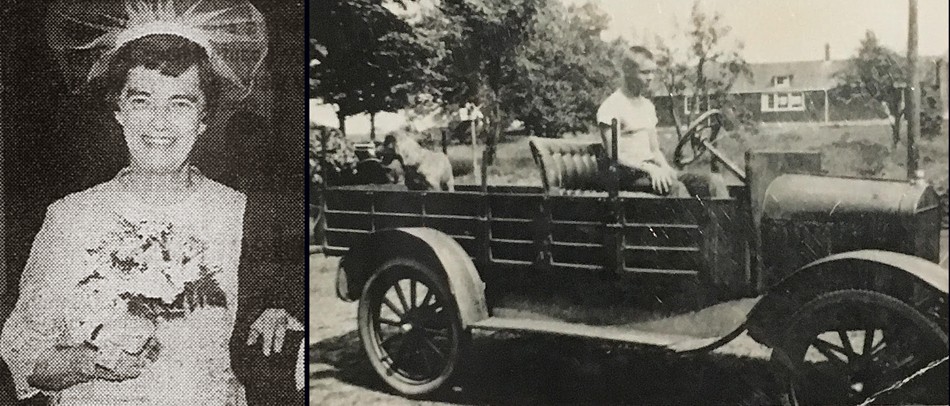 "Big Sister, Little Brother" Left: This cropped photograph of Helen Chase Gage Miller accompanied her 1970 wedding announcement in the Bronxville (New York) Review Press and Reporter newspaper. A graduate of Bronxville High School and Pratt Institute in Brooklyn earlier in life, she also attended Ursinus College. Later, the young photographer is known to have worked at Lord and Taylor, a department store in New York City, and was a member of the Reformed Church in Bronxville, the Anne Hutchinson Chapter of the Daughters of the American Revolution and the League for Service. Right: In 1935, Helen's younger brother Edward Augustus Gage (1919-2007) is shown behind the wheel of a 1918 Model T Ford depot wagon, along with his dog Ski at rear, in a photograph believed to have been taken near the family's summer property in Rye. The caption for this photograph which appeared in the volume "Footprints in Time" states: "Edward Gage later played an important role in trying to get the government to sell Odiorne land back to its pre-war owners." His 2007 obituary mentions he was a pilot and flight instructor in World War II and finished in the Naval Reserves at the rank of lieutenant commander. Trained as a lawyer, in 1970 he was appointed to serve as judge of the Exeter District Court in New Hampshire until his retirement in 2003. Photo courtesy Seacoast Science Center.
"Big Sister, Little Brother" Left: This cropped photograph of Helen Chase Gage Miller accompanied her 1970 wedding announcement in the Bronxville (New York) Review Press and Reporter newspaper. A graduate of Bronxville High School and Pratt Institute in Brooklyn earlier in life, she also attended Ursinus College. Later, the young photographer is known to have worked at Lord and Taylor, a department store in New York City, and was a member of the Reformed Church in Bronxville, the Anne Hutchinson Chapter of the Daughters of the American Revolution and the League for Service. Right: In 1935, Helen's younger brother Edward Augustus Gage (1919-2007) is shown behind the wheel of a 1918 Model T Ford depot wagon, along with his dog Ski at rear, in a photograph believed to have been taken near the family's summer property in Rye. The caption for this photograph which appeared in the volume "Footprints in Time" states: "Edward Gage later played an important role in trying to get the government to sell Odiorne land back to its pre-war owners." His 2007 obituary mentions he was a pilot and flight instructor in World War II and finished in the Naval Reserves at the rank of lieutenant commander. Trained as a lawyer, in 1970 he was appointed to serve as judge of the Exeter District Court in New Hampshire until his retirement in 2003. Photo courtesy Seacoast Science Center.
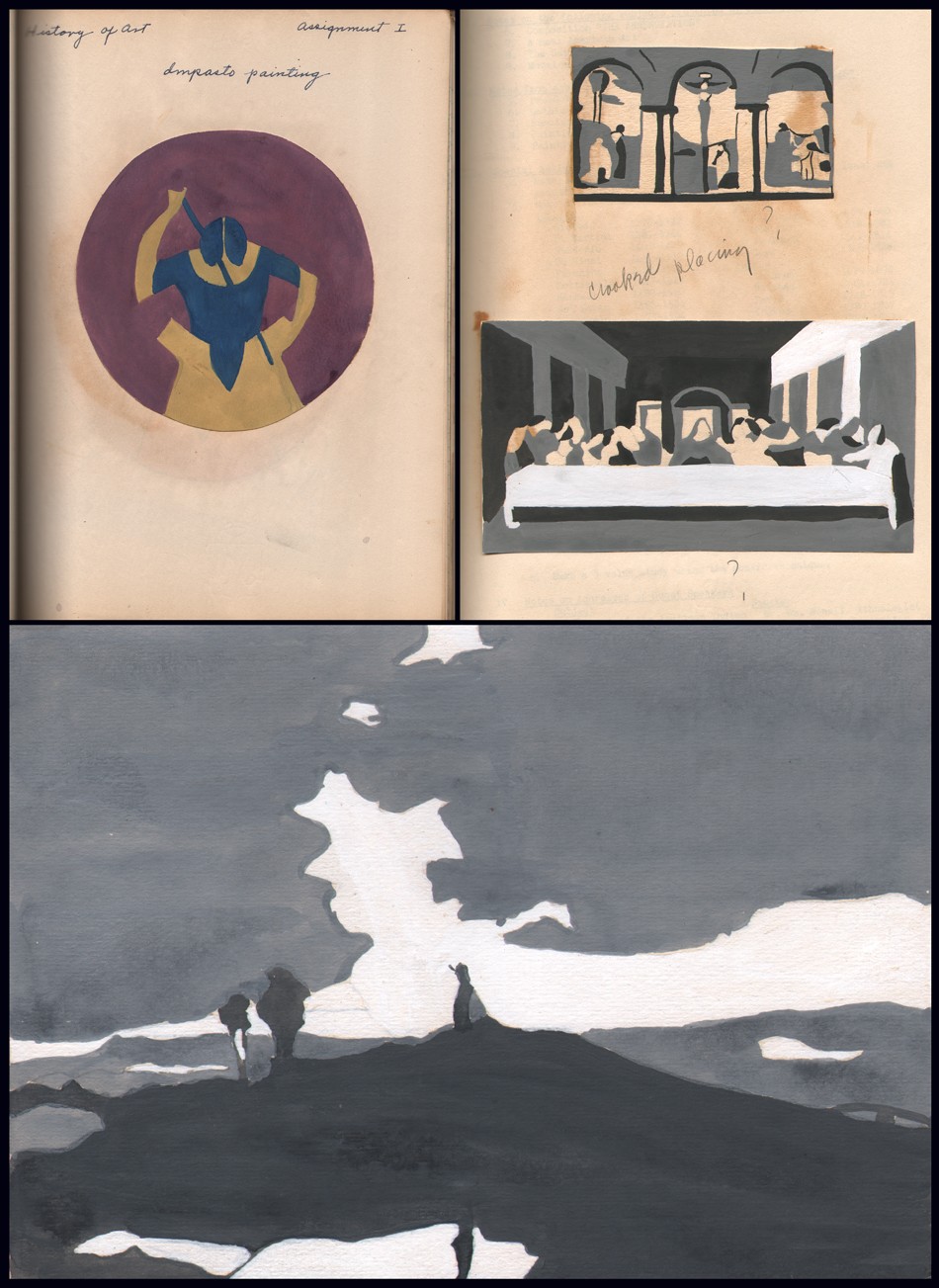 The pursuit of art was evident for Helen Chase Gage after early childhood. Although it's not known if she pursued it in any professional capacity later in life, Helen did attend Pratt Institute-School of Fine and Applied Arts in Brooklyn, New York from 1939-40, graduating in June, 1940. Above are several examples of original artwork by Gage used in her Art History course she was enrolled in as part of a series of lessons on painting presented by school Director James C. Boudreau kept in a notebook held by the PhotoSeed Archive. Top left: a tondo (13.8 cm) female form frontal view by Helen Chase Gage as an example of Impasto painting done using tempera paint. Top right: tempera study (5.5 x 9.5 cm) by Helen Chase Gage of the fresco "Pazzi Crucifixion" by Pietro Perugino; bottom: tempera study (8.4 x 15.9 cm) by Helen Chase Gage of Leonardo Da Vinci's "Last Supper". Bottom: tempera study (12.9 x 18.1 cm) by Helen Chase Gage of a painting by English artist Joseph Mallord William Turner titled "A Heath Scene" in the Gage notebook. From: PhotoSeed Archive
The pursuit of art was evident for Helen Chase Gage after early childhood. Although it's not known if she pursued it in any professional capacity later in life, Helen did attend Pratt Institute-School of Fine and Applied Arts in Brooklyn, New York from 1939-40, graduating in June, 1940. Above are several examples of original artwork by Gage used in her Art History course she was enrolled in as part of a series of lessons on painting presented by school Director James C. Boudreau kept in a notebook held by the PhotoSeed Archive. Top left: a tondo (13.8 cm) female form frontal view by Helen Chase Gage as an example of Impasto painting done using tempera paint. Top right: tempera study (5.5 x 9.5 cm) by Helen Chase Gage of the fresco "Pazzi Crucifixion" by Pietro Perugino; bottom: tempera study (8.4 x 15.9 cm) by Helen Chase Gage of Leonardo Da Vinci's "Last Supper". Bottom: tempera study (12.9 x 18.1 cm) by Helen Chase Gage of a painting by English artist Joseph Mallord William Turner titled "A Heath Scene" in the Gage notebook. From: PhotoSeed Archive
Jumping to the present day, the focal point of the park is the Seacoast Science Center, a non-profit marine science education organization. When I visited on October 1st recently, I had the pleasure of speaking with the center’s president Jim Chase, who gave me a brief history of the property and was helpful with directions to the area where Sagamore Farm was once located. He told me of the park’s efforts in clearing out some of the invasive plants on the property and about one of Seacoast’s more popular activities- BioBlitz, described as a “daylong species scavenger hunt…..where families explore alongside scientists and field experts to find and record data on as many different species in the Park as possible in one day.”
 "Lily of The Valley" (Convallaria majalis) Helen Chase Gage- American: 1917-1982; Cyanotype: 1930: (18.1 x 13.0 cm | 21.6 x 14.6 cm x2) Inscribed on opposite album page: Lily of The Valley: Blue Print made August 17, 1930 At Sagamore Farm By Helen C. Gage. This representative album spread from Helen's 1930 collected cyanotypes is unusual because the original collected botanical specimens are featured as part of the volume. Thirty-one individual prints are included within the album. From: PhotoSeed Archive
"Lily of The Valley" (Convallaria majalis) Helen Chase Gage- American: 1917-1982; Cyanotype: 1930: (18.1 x 13.0 cm | 21.6 x 14.6 cm x2) Inscribed on opposite album page: Lily of The Valley: Blue Print made August 17, 1930 At Sagamore Farm By Helen C. Gage. This representative album spread from Helen's 1930 collected cyanotypes is unusual because the original collected botanical specimens are featured as part of the volume. Thirty-one individual prints are included within the album. From: PhotoSeed Archive
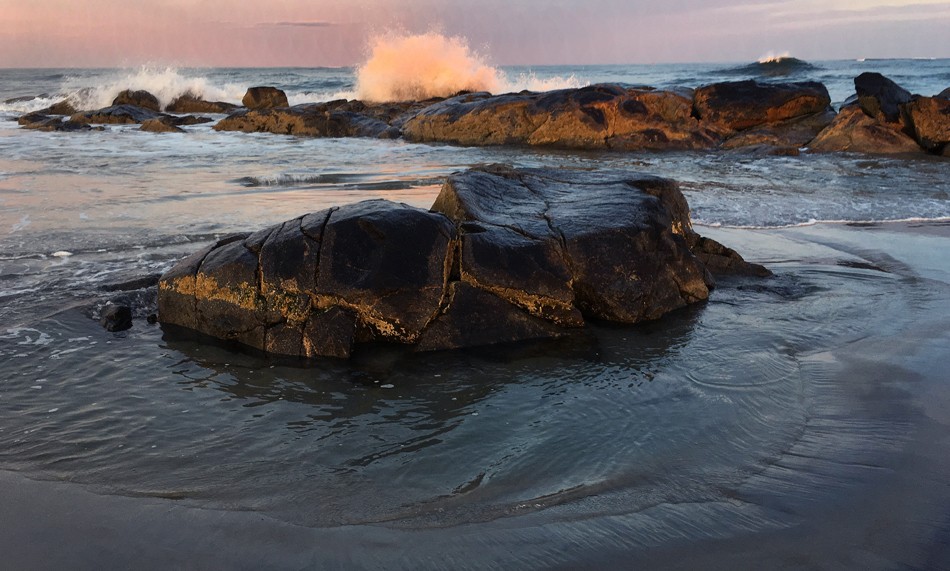 At dusk, waves crash on a rock outcropping at Hampton Beach, New Hampshire on September 30, 2018. Located twelve miles south of the present day Odiorne Point State Park along New Hampshire Route 1A, the popular summer destination spot for tourists is known for its' scenic beauty on the New Hampshire coastline, which measures in at 18.57 miles, the shortest ocean coastline of any US state. (or 235 miles of “estuarine shoreline!) Attractions and geographical proximity such as this give ample reason for visitors to visit both locales. Photo by David Spencer for PhotoSeed Archive
At dusk, waves crash on a rock outcropping at Hampton Beach, New Hampshire on September 30, 2018. Located twelve miles south of the present day Odiorne Point State Park along New Hampshire Route 1A, the popular summer destination spot for tourists is known for its' scenic beauty on the New Hampshire coastline, which measures in at 18.57 miles, the shortest ocean coastline of any US state. (or 235 miles of “estuarine shoreline!) Attractions and geographical proximity such as this give ample reason for visitors to visit both locales. Photo by David Spencer for PhotoSeed Archive
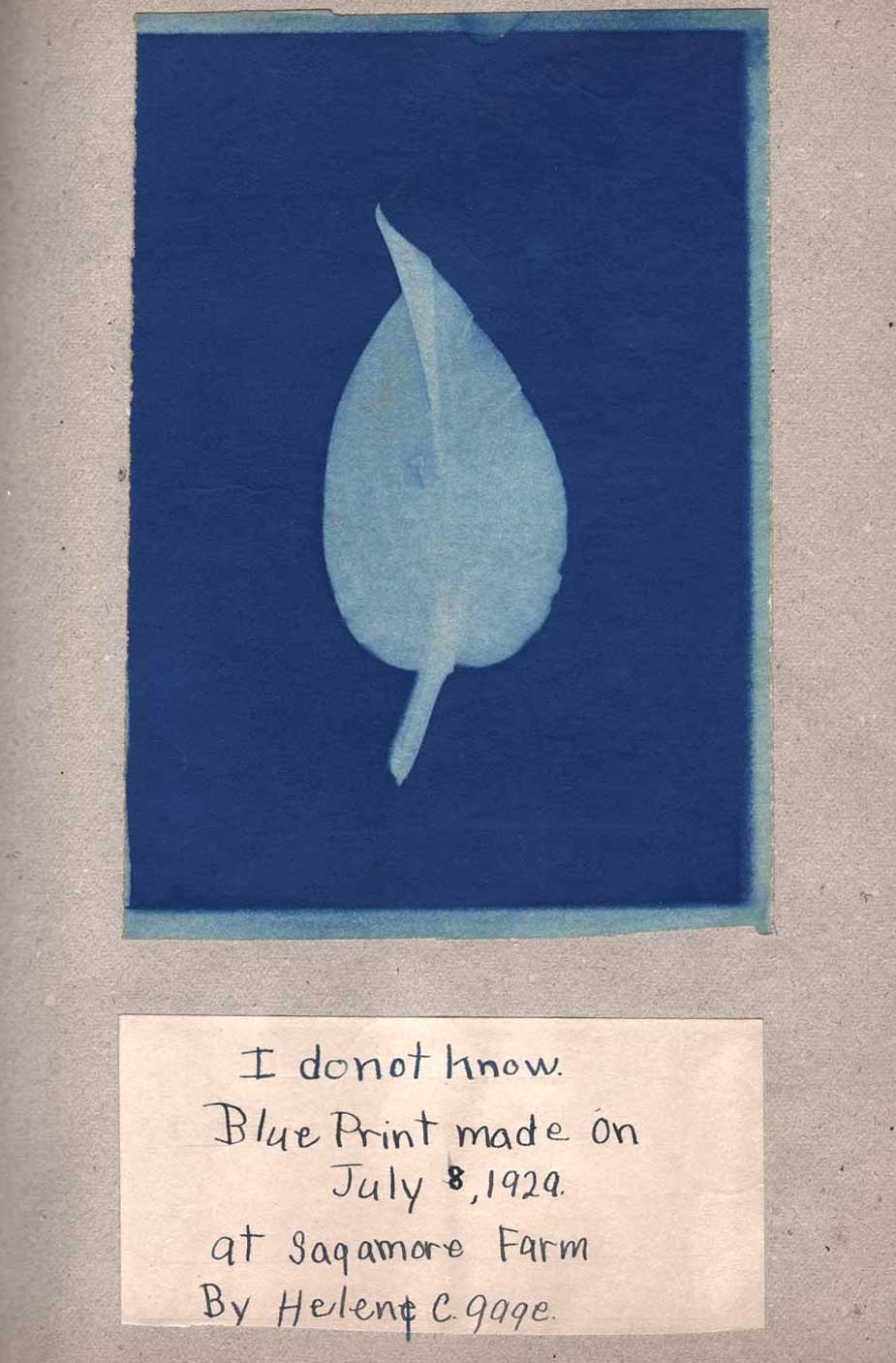 "I Do Not Know" Helen Chase Gage- American: 1917-1982; Cyanotype: 1929: (18.0 x 12.5 cm | 30.0 x 22.8 cm) Inscribed on same album page: I do not know.: Blue Print made July 8, 1929 At Sagamore Farm By Helen C. Gage. Perhaps one of the most interesting cyanotypes in both albums is this unidentified leaf specimen-endearing because the young artist who collected it was just being honest with her knowledge and told us so. As I've mentioned previously with these overall works, a few of the specimens may not be “right” botanically and possibly misidentified in some cases. Your expertise is welcomed! From: PhotoSeed Archive
"I Do Not Know" Helen Chase Gage- American: 1917-1982; Cyanotype: 1929: (18.0 x 12.5 cm | 30.0 x 22.8 cm) Inscribed on same album page: I do not know.: Blue Print made July 8, 1929 At Sagamore Farm By Helen C. Gage. Perhaps one of the most interesting cyanotypes in both albums is this unidentified leaf specimen-endearing because the young artist who collected it was just being honest with her knowledge and told us so. As I've mentioned previously with these overall works, a few of the specimens may not be “right” botanically and possibly misidentified in some cases. Your expertise is welcomed! From: PhotoSeed Archive
Feeling like a kid myself, I used my phone to show Jim one of the many fine botanical specimens Helen had made into a cyanotype from the 1930 album and realized she could have been rightly called one of the first BioBlitz scavenger hunters. As I left and walked outside the Seacoast Center, I found confirmation for Helen’s love of place on the New Hampshire seaboard all those years ago: a large group of school children getting ready to set out on their own happy discoveries.
David Spencer- October, 2018
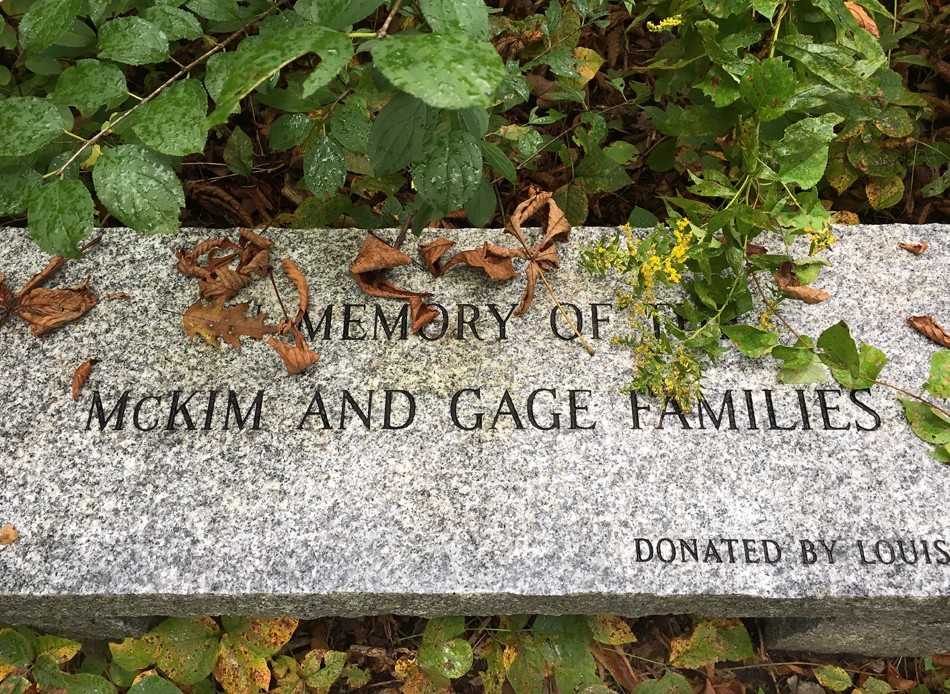 A Special Place Indeed: a poignant reminder of the property where Helen Chase Gage collected her plant specimens in order to make precious blue prints so many summers ago yields some new opportunities in the form of fall leaves and Goldenrod resting on this granite bench dedicated to the memory of the McKim and Gage families inside Rye's Odiorne Point State Park where "Sagamore Farm" once stood. Photographed October 1, 2018 by David Spencer for PhotoSeed Archive
A Special Place Indeed: a poignant reminder of the property where Helen Chase Gage collected her plant specimens in order to make precious blue prints so many summers ago yields some new opportunities in the form of fall leaves and Goldenrod resting on this granite bench dedicated to the memory of the McKim and Gage families inside Rye's Odiorne Point State Park where "Sagamore Farm" once stood. Photographed October 1, 2018 by David Spencer for PhotoSeed Archive
Afterword
An interesting segment from New Hampshire Public Radio from 2016 reports on how Odiorne Point State Park in New Hampshire was developed in the aftermath of World War II. The voice of Helen’s younger brother Edward Gage, (1919-2007) who went on to become a lawyer and spent decades trying to reclaim his family’s property is included in the report. To the credit of the park in not glossing over the loss to the Gage family and others-specifically the namesake Odiorne family who had owned property here since the 1660’s, signage outlining this history can be seen inside the Seacoast Science Center:
“In 1942,when the U.S. government took over Odiorne Point, homeowners were given short notice to vacate their beloved vacation homes and, in the case of the Odiornes, a farm that had been in their family almost three hundred years.
After the war, a debated legislative technicality at the federal level prevented Odiorne Point landowners from regaining their property. In ensuing years, discussion over what would become of the land covered the full range of development and preservation schemes.
In the end, thanks to preservation activist Annette Cottrell and the interest of New Hampshire Park Director Russell B. Tobey, the state-owned land became a park. The park is now the site of the Seacoast Science Center.
The story of Odiorne Point continues. Visitors and students from around the world are making new use of the park through the Seacoast Science Center and its educational programs. This little point of land seems destined to make more history.”
Additional Reading
-Footprints in Time: A Walk where New Hampshire Began. Compiled by Howard S. Crosby, Wendy W. Lull, and Richard T. MacIntyre: Arcardia Publishing, 1994
-Writer Anna Soper contributes additional scholarship on these albums in her article These Stunning Botanical Images Are Blueprints of the Past found on the Atlas Obscura website published October 8, 2019.
Blue Boo
Posted October 2017 in Alternate Processes, New Additions
Happy Halloween!
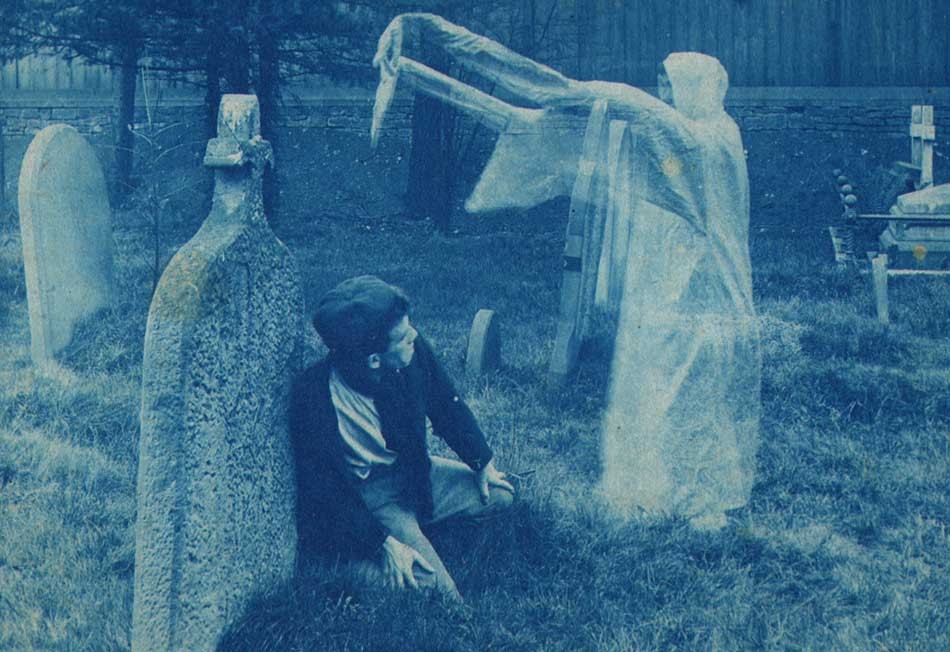 Detail: "Paddy and the Ghost — Dec. 9 1899": Henry Byett, (ca.1870-1949) English: 1899: vintage cyanotype mounted on card album leaf: (6.9 x 9.5 | 8.3 x 10.8 | 12.1 x 15.0 cm) This rare cyanotype "spirit" photograph is the lone blueprint in a small album of carefully composed, mounted and captioned gelatin silver photographs attributed to the English amateur photographer, who was for many years a railway clerk for the Swindon works of the Great Western Railway in England. Byett is best known today as having been a close friend of the celebrated English poet Alfred Williams, (1877-1930) Swindon’s “Hammerman Poet ” whom he met there in 1905. From: PhotoSeed Archive
Detail: "Paddy and the Ghost — Dec. 9 1899": Henry Byett, (ca.1870-1949) English: 1899: vintage cyanotype mounted on card album leaf: (6.9 x 9.5 | 8.3 x 10.8 | 12.1 x 15.0 cm) This rare cyanotype "spirit" photograph is the lone blueprint in a small album of carefully composed, mounted and captioned gelatin silver photographs attributed to the English amateur photographer, who was for many years a railway clerk for the Swindon works of the Great Western Railway in England. Byett is best known today as having been a close friend of the celebrated English poet Alfred Williams, (1877-1930) Swindon’s “Hammerman Poet ” whom he met there in 1905. From: PhotoSeed ArchiveMaking a Pitch
Posted April 2017 in History of Photography, New Additions, Sports Photography
Like hot dogs, apple pie and a certain car company, the time-honored pastime of American baseball is once again upon us this spring in big league parks and dusty diamonds scattered throughout the land.
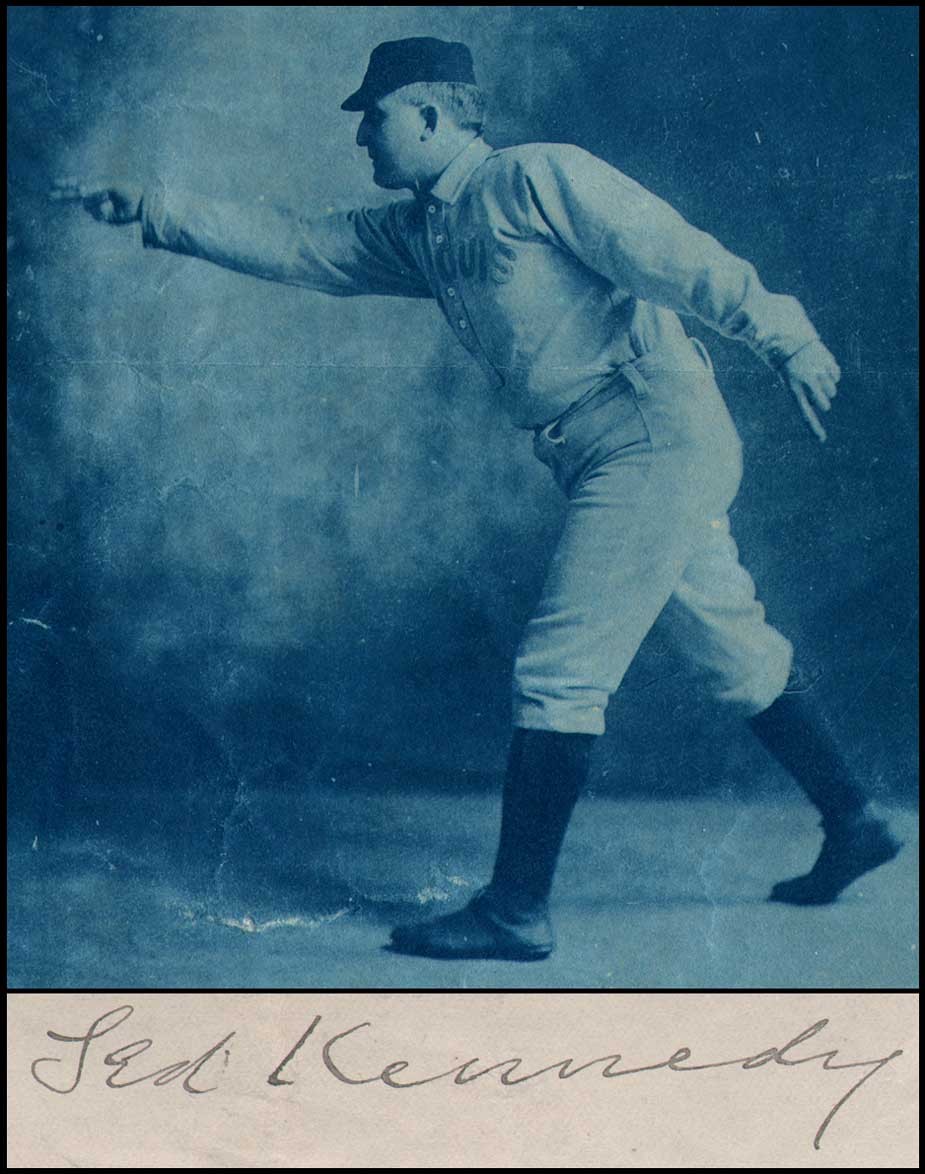 Detail: Top: "Ted Kennedy Throws a Curveball": ca. 1905: vintage cyanotype, unmounted: 17.6 x 12.5 cm: American Major League Baseball Pitcher Ted Kennedy, 1865-1907, demonstrates following through while throwing an overhand curve ball. Shown wearing his St. Louis Browns baseball uniform, Kennedy excelled in the American spirit of being an entrepreneur, inventor and promoter long after his playing days, and was the first ever hitting coach in the Majors. Bottom: Detail: verso autograph from "Ted Kennedy" cyanotype in graphite believed to be genuine: app: 1.0 x 8.5 cm. From: PhotoSeed Archive
Detail: Top: "Ted Kennedy Throws a Curveball": ca. 1905: vintage cyanotype, unmounted: 17.6 x 12.5 cm: American Major League Baseball Pitcher Ted Kennedy, 1865-1907, demonstrates following through while throwing an overhand curve ball. Shown wearing his St. Louis Browns baseball uniform, Kennedy excelled in the American spirit of being an entrepreneur, inventor and promoter long after his playing days, and was the first ever hitting coach in the Majors. Bottom: Detail: verso autograph from "Ted Kennedy" cyanotype in graphite believed to be genuine: app: 1.0 x 8.5 cm. From: PhotoSeed Archive
Seen here making his pitch is Ted Kennedy, (1865-1907) one of the game’s early promoters whose playing days lasted a mere two years from 1885-86, pitching for teams including the Chicago White Stockings, Philadelphia Athletics and Louisville Colonels. Play Ball!
Old Nasty Women
Posted January 2017 in Documentary Photography, History of Photography, New Additions, Significant Photographers, Significant Photographs
The historical photographic record doesn’t flinch when it comes to the importance of women, and I present herewith a short gallery as evidence, many of these photographs taken by women themselves. Mother Earth was surely proud of those millions who turned out in rallies all over the United States and across the World in support of the fairer sex on Saturday. And in Washington, D.C., it was a pointed, diverse, and joyous message presenting the true story of America heard loud and clear countering the utterances of the keynote speaker the day before.
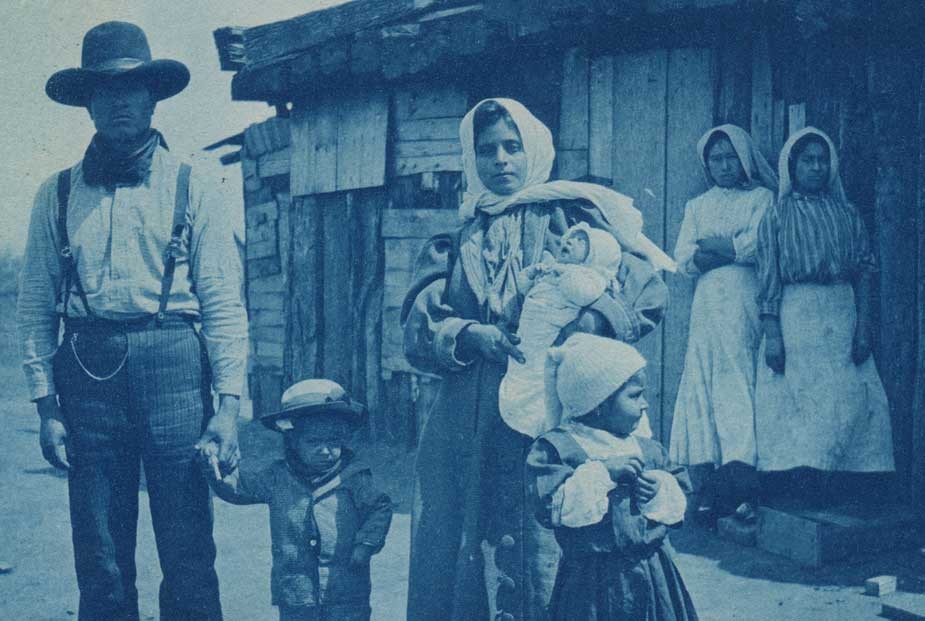 A Message to Washington: "Sweet-faced Little Mother" : Detail: Anonymous American Photographer: 1911: Cyanotype postcard mailed to Washington D.C. from Sweetwater Texas showing a proud Mexican family in front of their Texas & Pacific Railroad section house. 7.4 x 9.9 cm | 8.7 x 13.9 cm: Besides being built with the hard labor of Mexican and other nationalities in the later 19th Century, continued maintenance of American railroads like the "T & P" in places like Texas in the early 20th was often performed by them, with the rail line providing section houses along the track for temporary quarters to live in. Writing to a Mrs. Burnside on the card's verso, the following appears in neat script: "This man came up and asked me to come and take a picture of his baby, "just borned"-When I got there, the whole family wanted to be taken-so here they are the sweet-faced little mother and the baby, not quite 2 weeks old. They are such a happy-hearted class of people." From: PhotoSeed Archive
A Message to Washington: "Sweet-faced Little Mother" : Detail: Anonymous American Photographer: 1911: Cyanotype postcard mailed to Washington D.C. from Sweetwater Texas showing a proud Mexican family in front of their Texas & Pacific Railroad section house. 7.4 x 9.9 cm | 8.7 x 13.9 cm: Besides being built with the hard labor of Mexican and other nationalities in the later 19th Century, continued maintenance of American railroads like the "T & P" in places like Texas in the early 20th was often performed by them, with the rail line providing section houses along the track for temporary quarters to live in. Writing to a Mrs. Burnside on the card's verso, the following appears in neat script: "This man came up and asked me to come and take a picture of his baby, "just borned"-When I got there, the whole family wanted to be taken-so here they are the sweet-faced little mother and the baby, not quite 2 weeks old. They are such a happy-hearted class of people." From: PhotoSeed Archive
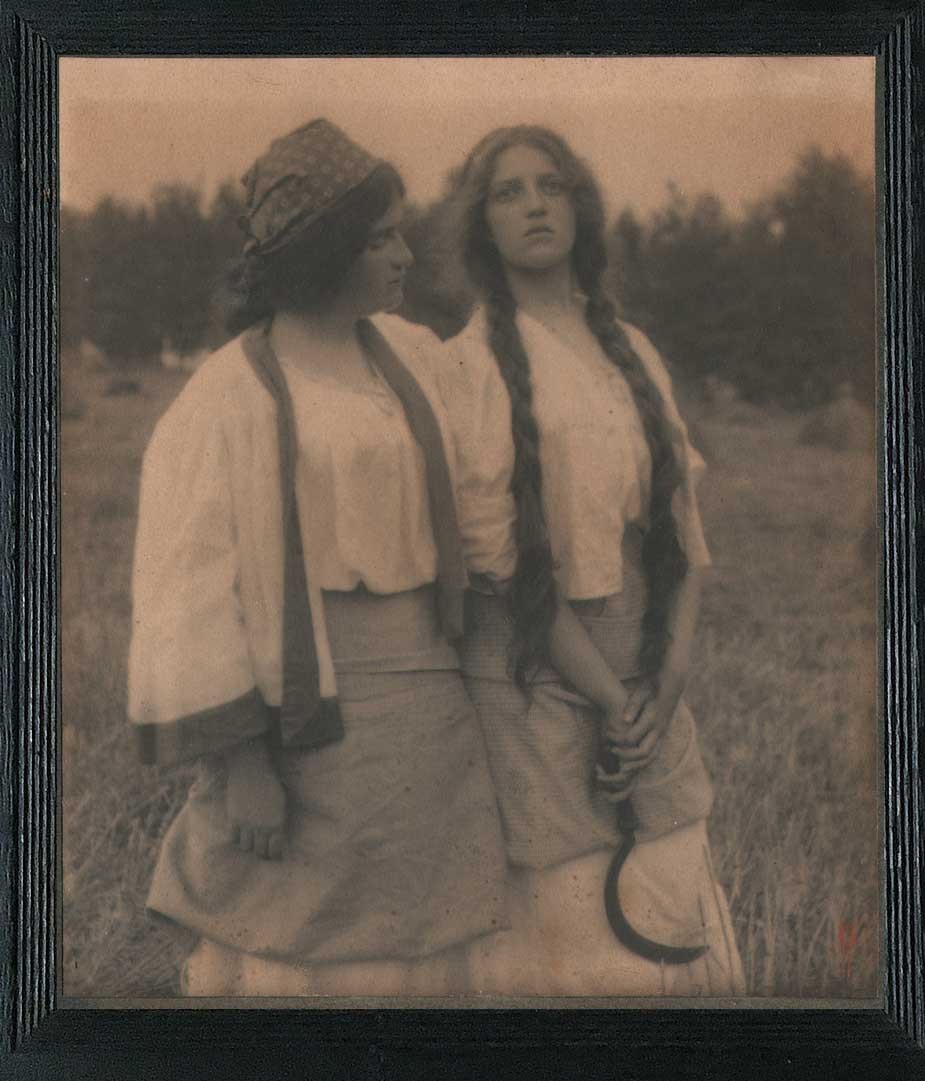 "The Song of the Meadow Lark": Mathilde Weil: American: (1872-1942) ca. 1900: Platinum print mounted on board signed in red with Weil cipher at lower right: 18.4 x 16.0 cm | 19.1 x 16.5 cm: black-painted wood frame: 28.4 x 25.7 cm: In December, 1899, critic Francis J. Ziegler, writing in Brush and Pencil for a review of the Philadelphia Photographic Salon, said of this photograph: "Among Philadelphia's artist photographers one of the most prominent is Miss Mathilde Weil, and her contributions to this exhibition are full of artistic excellence. Her "Song of the Meadow-Lark" has a suggestion of the Orient about it, notwithstanding the fact that the landscape is an American field and the two girls who have stopped in their reaping have American faces. This effect, I think, is due to the long braids of hair which hang down the front of one damsel's bodice, and the white jacket worn by her companion, the trimming of which repeats the same lines in artistic harmony." (p. 113) From: PhotoSeed Archive
"The Song of the Meadow Lark": Mathilde Weil: American: (1872-1942) ca. 1900: Platinum print mounted on board signed in red with Weil cipher at lower right: 18.4 x 16.0 cm | 19.1 x 16.5 cm: black-painted wood frame: 28.4 x 25.7 cm: In December, 1899, critic Francis J. Ziegler, writing in Brush and Pencil for a review of the Philadelphia Photographic Salon, said of this photograph: "Among Philadelphia's artist photographers one of the most prominent is Miss Mathilde Weil, and her contributions to this exhibition are full of artistic excellence. Her "Song of the Meadow-Lark" has a suggestion of the Orient about it, notwithstanding the fact that the landscape is an American field and the two girls who have stopped in their reaping have American faces. This effect, I think, is due to the long braids of hair which hang down the front of one damsel's bodice, and the white jacket worn by her companion, the trimming of which repeats the same lines in artistic harmony." (p. 113) From: PhotoSeed Archive
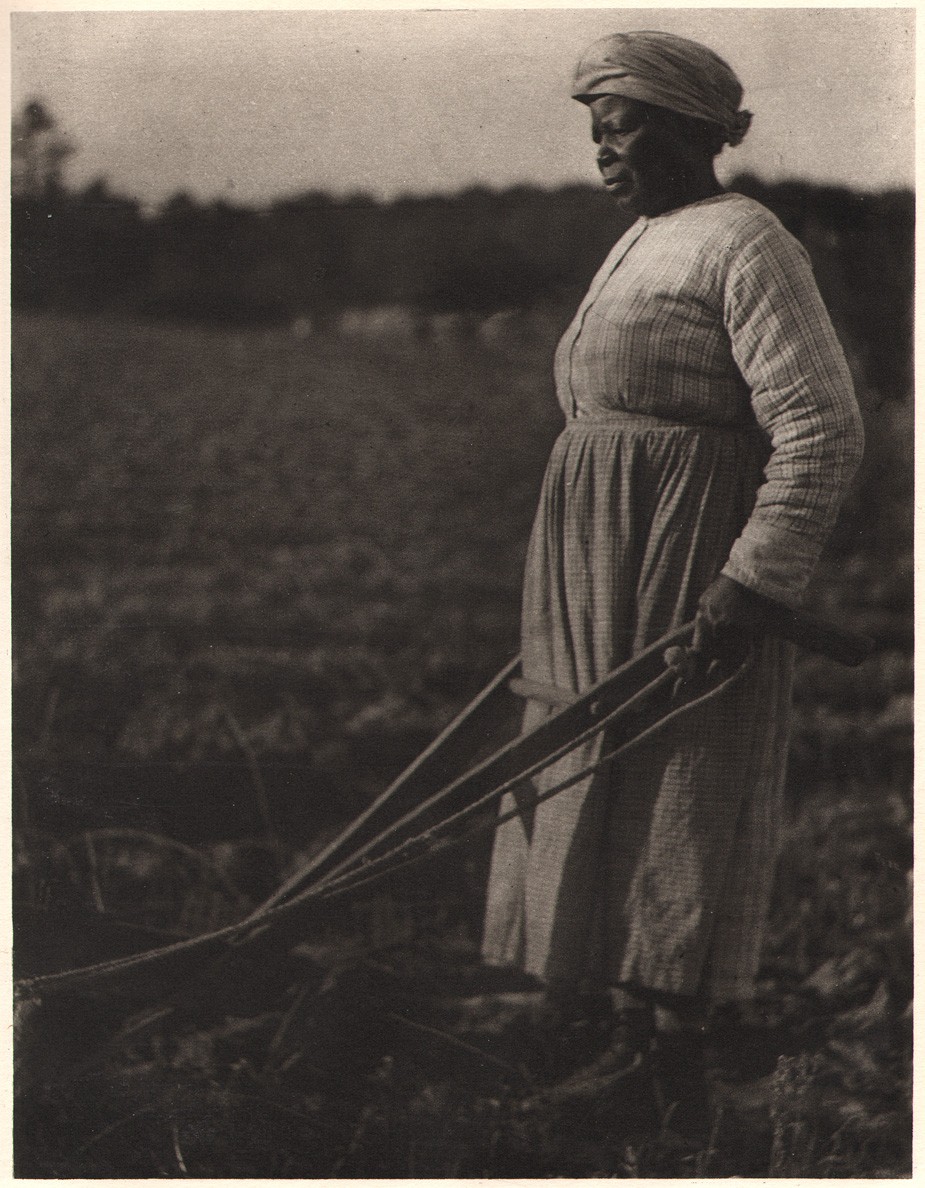 "Woman Behind Plow": Doris Ulmann, American: (1882-1934): 1933: hand-pulled photogravure: Plate 39 from the deluxe volume Roll Jordan Roll: New York: Robert O. Ballou: (text by Julia Peterkin) 21.2 x 16.3 | 28.4 x 20.5 cm: A landmark photographic volume of the 20th Century featuring ethnographic studies and portraits, this volume features 90 full-page copperplate gravures done in the Pictorial manner. Writing for the Amon Carter Museum of American Art in Texas, author Steve Watson describes the volume in part: "The book focuses on the lives of former slaves and their descendants on a plantation in the Gullah coastal region of South Carolina. Peterkin, who won the Pulitzer Prize for her novel Scarlet Sister Mary (Indianapolis: Bobbs-Merrill, 1928), was born in South Carolina and raised by a black nursemaid who taught her the Gullah dialect. She married the heir to Lang Syne, a 2,000-acre cotton plantation, which became the setting for Roll, Jordan, Roll. Ulmann began photographing there in 1929." From: PhotoSeed Archive
"Woman Behind Plow": Doris Ulmann, American: (1882-1934): 1933: hand-pulled photogravure: Plate 39 from the deluxe volume Roll Jordan Roll: New York: Robert O. Ballou: (text by Julia Peterkin) 21.2 x 16.3 | 28.4 x 20.5 cm: A landmark photographic volume of the 20th Century featuring ethnographic studies and portraits, this volume features 90 full-page copperplate gravures done in the Pictorial manner. Writing for the Amon Carter Museum of American Art in Texas, author Steve Watson describes the volume in part: "The book focuses on the lives of former slaves and their descendants on a plantation in the Gullah coastal region of South Carolina. Peterkin, who won the Pulitzer Prize for her novel Scarlet Sister Mary (Indianapolis: Bobbs-Merrill, 1928), was born in South Carolina and raised by a black nursemaid who taught her the Gullah dialect. She married the heir to Lang Syne, a 2,000-acre cotton plantation, which became the setting for Roll, Jordan, Roll. Ulmann began photographing there in 1929." From: PhotoSeed Archive
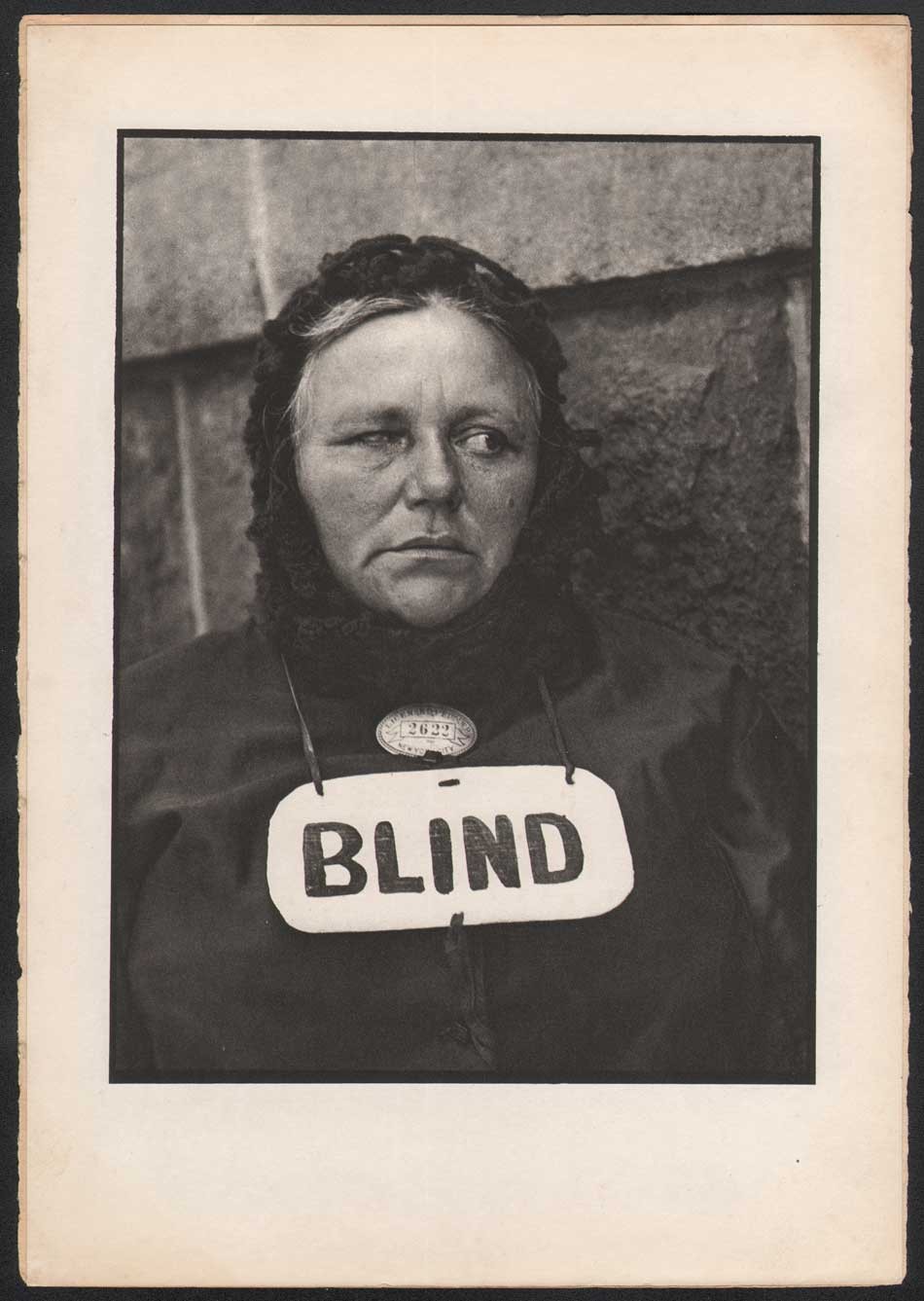 "Photograph-New York": Paul Strand, American: (1890-1976): 1917: hand-pulled photogravure from Camera Work XLIX/L: 22.4 x 16.6 | 29.7 x 20.6 cm: This iconic portrait of a blind woman, who has been issued a peddler's license by the city seen above her sign, was taken by Strand with the aid of either a false or prism lens as part of a series of ground-breaking modernist photographs done on the streets of New York City in the Fall of 1916. Writing the same year this portrait appeared in Camera Work, in August, 1917, an essay on Photography for the journal The Seven Arts concludes with the following observations by Strand-observations that could also certainly apply to the joyful diversity of human beings themselves, as in this case- womankind herself: "The existence of a medium, after all, is its absolute justification, if as so many seem to think, it needs one, and all comparison of potentialities is useless and irrelevant. Whether a water-color is inferior to an oil, or whether a drawing, an etching, or a photograph is not as important as either, is inconsequent. To have to despise something else is a sign of impotence. Let us rather accept joyously and with gratitude everything through which the spirit of man seeks to an ever fuller and more intense self-realization." (pp. 525-26) From: PhotoSeed Archive
"Photograph-New York": Paul Strand, American: (1890-1976): 1917: hand-pulled photogravure from Camera Work XLIX/L: 22.4 x 16.6 | 29.7 x 20.6 cm: This iconic portrait of a blind woman, who has been issued a peddler's license by the city seen above her sign, was taken by Strand with the aid of either a false or prism lens as part of a series of ground-breaking modernist photographs done on the streets of New York City in the Fall of 1916. Writing the same year this portrait appeared in Camera Work, in August, 1917, an essay on Photography for the journal The Seven Arts concludes with the following observations by Strand-observations that could also certainly apply to the joyful diversity of human beings themselves, as in this case- womankind herself: "The existence of a medium, after all, is its absolute justification, if as so many seem to think, it needs one, and all comparison of potentialities is useless and irrelevant. Whether a water-color is inferior to an oil, or whether a drawing, an etching, or a photograph is not as important as either, is inconsequent. To have to despise something else is a sign of impotence. Let us rather accept joyously and with gratitude everything through which the spirit of man seeks to an ever fuller and more intense self-realization." (pp. 525-26) From: PhotoSeed Archive
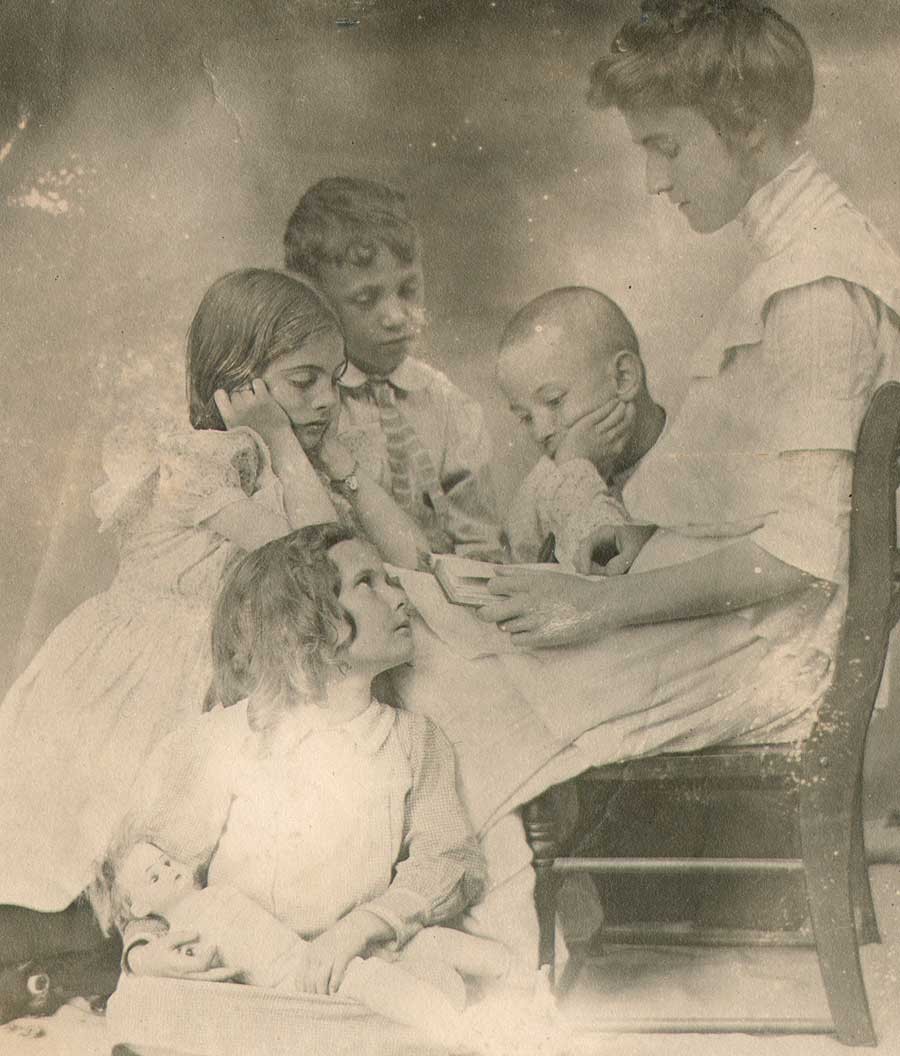 Detail: "Untitled Study of Woman Reading to Children: Juliana Royster, American: ( 1876-1962) ca. 1905-10: Gelatino-Choloride (POP) print: 11.8 x 10.0 cm: An artist who excelled in multiple mediums, Juliana Royster, from Raleigh, North Carolina, learned photography while attending Saint Mary’s School there, and is best known in the modern era for her founding in 1917, along with husband Jacques (born James) Busbee, (1870-1947) the Jugtown Pottery in Seagrove, North Carolina. From: PhotoSeed Archive
Detail: "Untitled Study of Woman Reading to Children: Juliana Royster, American: ( 1876-1962) ca. 1905-10: Gelatino-Choloride (POP) print: 11.8 x 10.0 cm: An artist who excelled in multiple mediums, Juliana Royster, from Raleigh, North Carolina, learned photography while attending Saint Mary’s School there, and is best known in the modern era for her founding in 1917, along with husband Jacques (born James) Busbee, (1870-1947) the Jugtown Pottery in Seagrove, North Carolina. From: PhotoSeed Archive
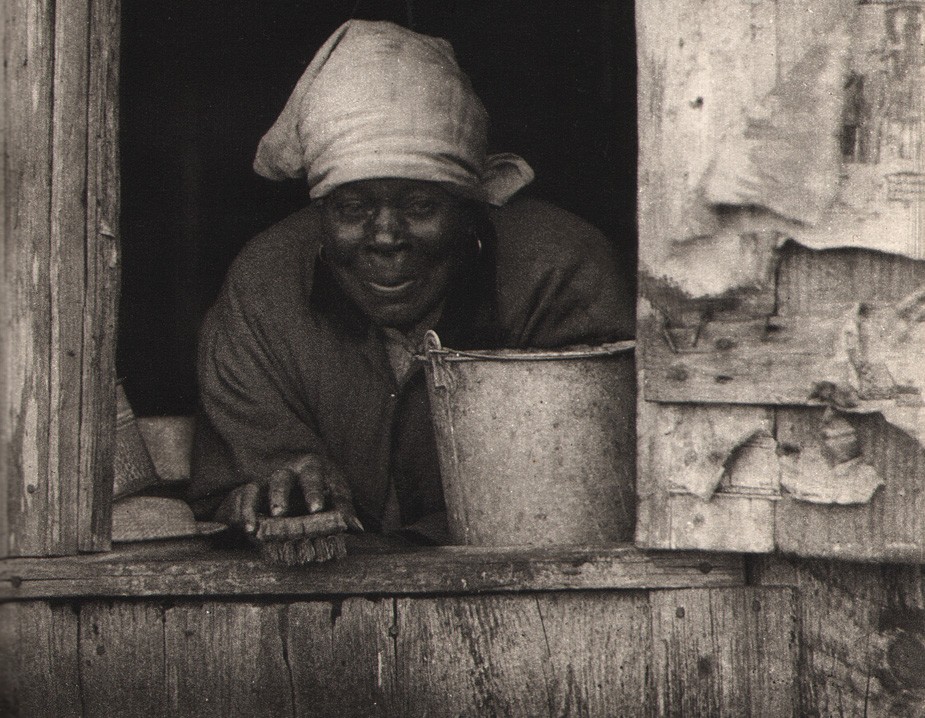 Detail: "Woman with Scrub brush Looking out Window": Doris Ulmann, American: (1882-1934): 1933: hand-pulled photogravure: Plate 66 from the deluxe volume Roll Jordan Roll: New York: Robert O. Ballou: (text by Julia Peterkin) 21.0 x 16.3 | 28.4 x 20.5 cm: A landmark photographic volume of the 20th Century featuring ethnographic studies and portraits, this volume features 90 full-page copperplate gravures done in the Pictorial manner. Writing for the Amon Carter Museum of American Art in Texas, author Steve Watson describes the volume in part: "The book focuses on the lives of former slaves and their descendants on a plantation in the Gullah coastal region of South Carolina. Peterkin, who won the Pulitzer Prize for her novel Scarlet Sister Mary (Indianapolis: Bobbs-Merrill, 1928), was born in South Carolina and raised by a black nursemaid who taught her the Gullah dialect. She married the heir to Lang Syne, a 2,000-acre cotton plantation, which became the setting for Roll, Jordan, Roll. Ulmann began photographing there in 1929." From: PhotoSeed Archive
Detail: "Woman with Scrub brush Looking out Window": Doris Ulmann, American: (1882-1934): 1933: hand-pulled photogravure: Plate 66 from the deluxe volume Roll Jordan Roll: New York: Robert O. Ballou: (text by Julia Peterkin) 21.0 x 16.3 | 28.4 x 20.5 cm: A landmark photographic volume of the 20th Century featuring ethnographic studies and portraits, this volume features 90 full-page copperplate gravures done in the Pictorial manner. Writing for the Amon Carter Museum of American Art in Texas, author Steve Watson describes the volume in part: "The book focuses on the lives of former slaves and their descendants on a plantation in the Gullah coastal region of South Carolina. Peterkin, who won the Pulitzer Prize for her novel Scarlet Sister Mary (Indianapolis: Bobbs-Merrill, 1928), was born in South Carolina and raised by a black nursemaid who taught her the Gullah dialect. She married the heir to Lang Syne, a 2,000-acre cotton plantation, which became the setting for Roll, Jordan, Roll. Ulmann began photographing there in 1929." From: PhotoSeed Archive
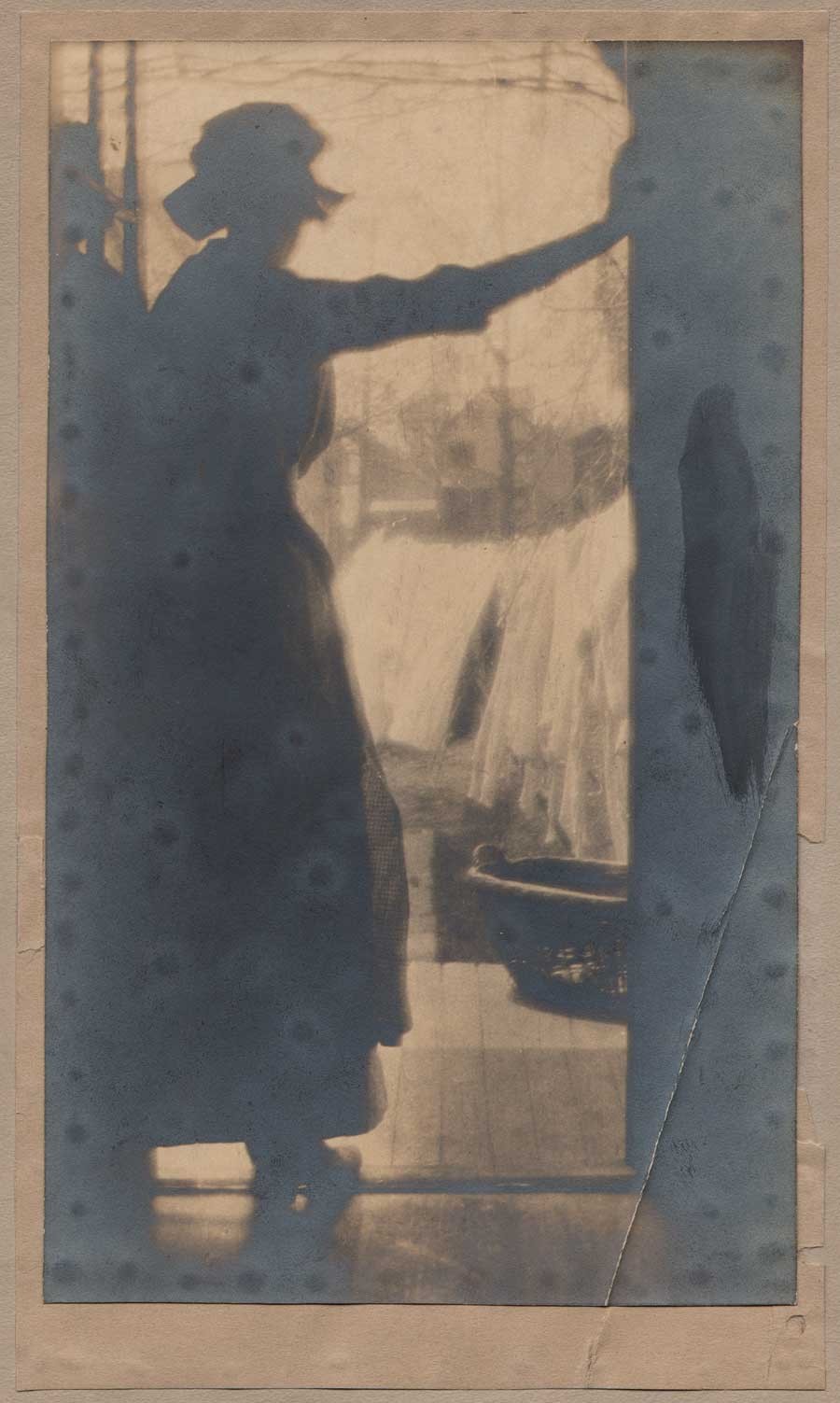 "A Moments Leisure": Ben J. Boyd: American, ( 1881-1958): ca. 1915-20: Gelatin Silver print, mounted: 24.0 x 14.4 | 26.3 x 15.4 | 34.2 x 26.6 cm: Silhouetted in a doorway, a woman takes a break from hanging laundry seen at center in this unusual home-life study depicting the everyday struggle of women done here by long-time Wilkes-Barre, PA resident and Camera Club member Benjamin Joslin Boyd. From: PhotoSeed Archive
"A Moments Leisure": Ben J. Boyd: American, ( 1881-1958): ca. 1915-20: Gelatin Silver print, mounted: 24.0 x 14.4 | 26.3 x 15.4 | 34.2 x 26.6 cm: Silhouetted in a doorway, a woman takes a break from hanging laundry seen at center in this unusual home-life study depicting the everyday struggle of women done here by long-time Wilkes-Barre, PA resident and Camera Club member Benjamin Joslin Boyd. From: PhotoSeed Archive
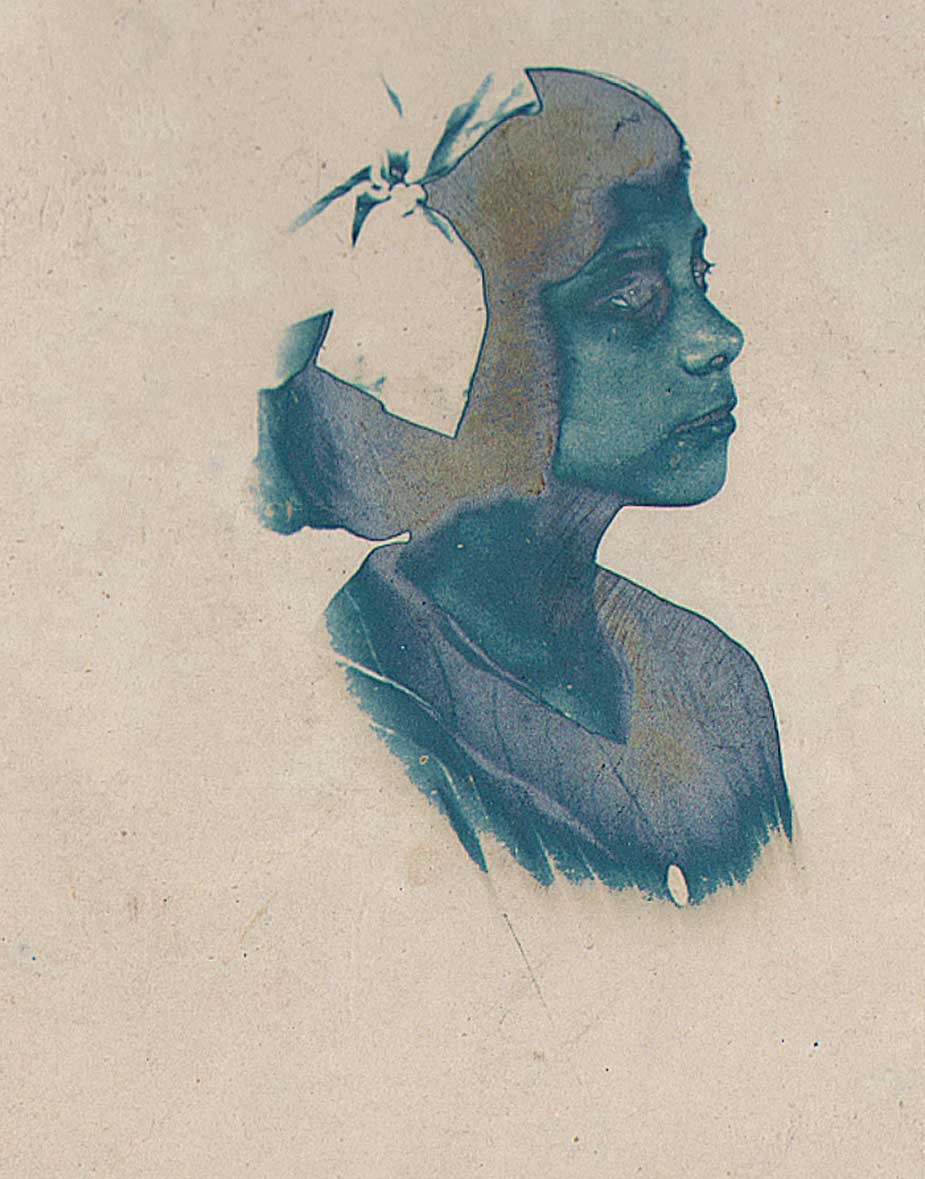 "Female Head Study": unknown, probably American photographer: ca. 1900-20: Reverse negative, Gelatin-silver over Cyanotype photograph, unmounted: 8.7 x 6.2 cm: Whether intentional or not, and for the purposes of this post, this alternative, multi-process study of a young woman is symbolic for a joyous, multi-ethnic celebration of women's diversity everywhere. From: PhotoSeed Archive
"Female Head Study": unknown, probably American photographer: ca. 1900-20: Reverse negative, Gelatin-silver over Cyanotype photograph, unmounted: 8.7 x 6.2 cm: Whether intentional or not, and for the purposes of this post, this alternative, multi-process study of a young woman is symbolic for a joyous, multi-ethnic celebration of women's diversity everywhere. From: PhotoSeed ArchiveNew Year Liftoff
Posted January 2017 in Aerial Photography, History of Photography, New Additions, Significant Photographers
“Liberty cannot be preserved without a general knowledge among the people.”
– John Adams
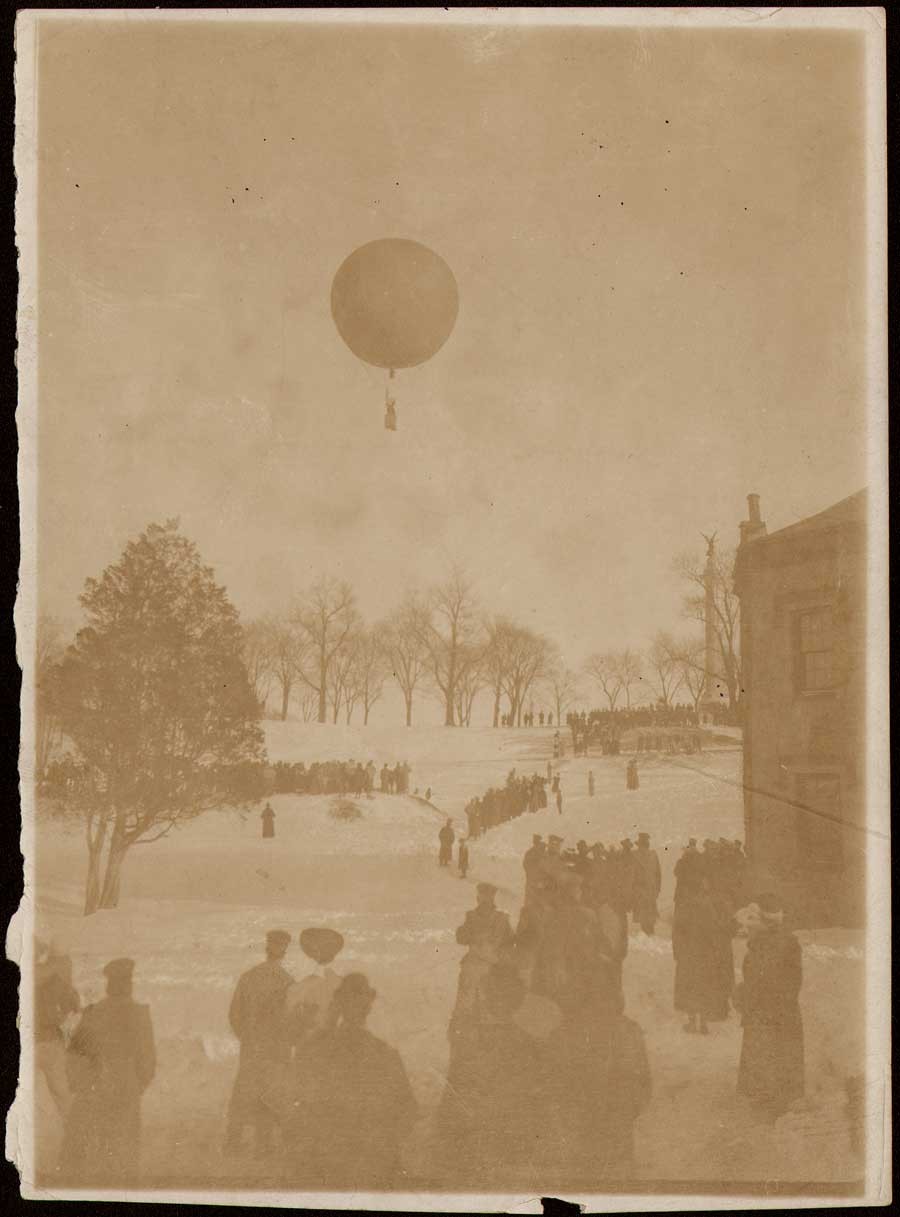 "First Balloon Flight Under the American Aero Club": 1906: James H. Hare: British: 1856-1946: Chloride print (POP) 17.05 x 12.05 | 17.6 x 12.8 cm: With a crowd looking on including officers, cadets and scientists, French aeronaut Charles Levee is seen ascending in the balloon "L'Allouette" from the siege battery at West Point Military Academy in New York State on Sunday, 11th February, 1906. This is the original photograph taken by pioneering British photojournalist Jimmy Hare of the ascent, which was published for his employer Collier's Magazine on 24th February of that year. The fledgling American Aero Club, based in New York City, hired Charles Levee to pilot their 28' diameter yellow balloon, which took 12,500 cubic feet of coal gas to inflate according to a New York Times dispatch. "Wearing an ordinary Winter overcoat and a close-fitting cap" Levee ascended at 3:55 p.m. in the basket of the balloon made of cotton-fabric (the first time a balloon launched from West Point) and traveled nearly 60 kilometers before finally descending at Hurley, New York at 8:10 p.m. with the aid of a rip cord. from: PhotoSeed Archive
"First Balloon Flight Under the American Aero Club": 1906: James H. Hare: British: 1856-1946: Chloride print (POP) 17.05 x 12.05 | 17.6 x 12.8 cm: With a crowd looking on including officers, cadets and scientists, French aeronaut Charles Levee is seen ascending in the balloon "L'Allouette" from the siege battery at West Point Military Academy in New York State on Sunday, 11th February, 1906. This is the original photograph taken by pioneering British photojournalist Jimmy Hare of the ascent, which was published for his employer Collier's Magazine on 24th February of that year. The fledgling American Aero Club, based in New York City, hired Charles Levee to pilot their 28' diameter yellow balloon, which took 12,500 cubic feet of coal gas to inflate according to a New York Times dispatch. "Wearing an ordinary Winter overcoat and a close-fitting cap" Levee ascended at 3:55 p.m. in the basket of the balloon made of cotton-fabric (the first time a balloon launched from West Point) and traveled nearly 60 kilometers before finally descending at Hurley, New York at 8:10 p.m. with the aid of a rip cord. from: PhotoSeed Archive
Lately, I’ve become worried about that general knowledge thing. But this is not a lecture, and a new year is upon us, so bear with me here. Late this summer, I came full-circle back to my native New England after retiring from a 30-year run wearing the hat of photojournalist for newspapers across the country. Photographing and sharing the stories of people from literally all walks of life has been my best teacher and given me the most valuable education and perspective I could ever hope for in my career: the nuance of which I often find lacking in the public discourse of late rising from these so-called divided States of America.
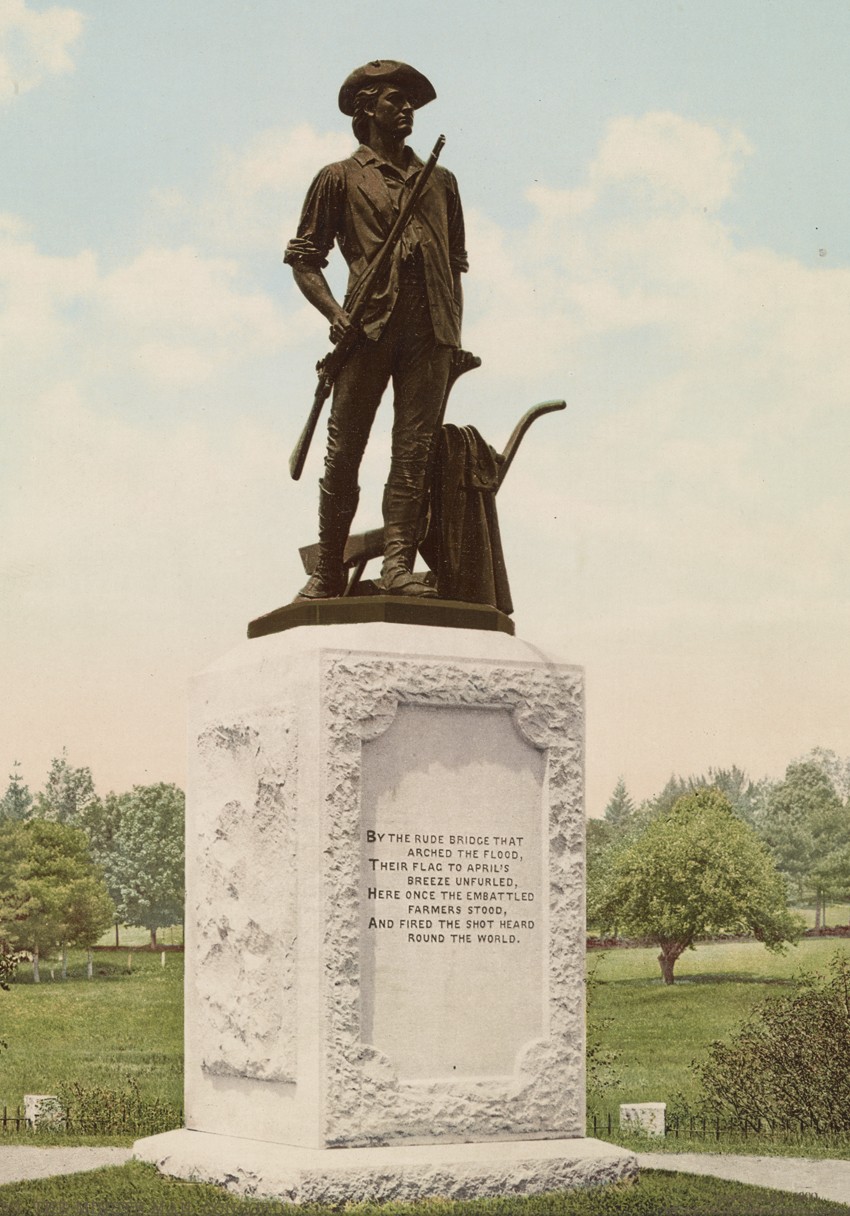 The Minute Man Statue: ca. 1900: by unknown photographer working for Detroit Photographic Company: Photochrom: from album (29.0 x 40.0 cm) of 48 Photochroms depicting mostly New England historical places and views prepared by the Detroit Photographic Co. for use as a catalog in their offices. Statue in bronze by American sculptor Daniel Chester French (1850-1931) dedicated on the centenary of the Battle of Concord on 19th April, 1875: During the first battle of the American Revolutionary War, which took place here at The Old North Bridge on the 19th of April, 1775 in the town of Concord, MA, (then located in the British Crown colony of the Province of Massachusetts Bay) a group of 37 Acton, MA Minutemen led by Captain Isaac Davis (b. 1745) faced off (with other militia companies made up of about 500 men) against 100 British "Regular" troops. Davis was the first casualty at the bridge during the American War of independence, with Acton Minuteman Abner Hosmer, (1754-1775) a private who played his drum into battle as company musician, the second mortally wounded after being shot through the head. (Acton Minuteman James Hayward also died later that day) On the base of this statue are inscribed the first stanza of American poet Ralph Waldo Emersons Concord Hymn from 1836:"By the rude bridge that arched the flood, Their flag to Aprils breeze unfurled, Here once the embattled farmers stood And fired the shot heard round the world." Said to be modeled after Captain Davis but also known to have been done from live models posing in the studio of sculptor Daniel Chester French, the Minute Man statue proudly shows the enduring American spirit during the nations struggle for freedom and independence. from: Library of Congress: Call Number LOT 12003, p. 30.
The Minute Man Statue: ca. 1900: by unknown photographer working for Detroit Photographic Company: Photochrom: from album (29.0 x 40.0 cm) of 48 Photochroms depicting mostly New England historical places and views prepared by the Detroit Photographic Co. for use as a catalog in their offices. Statue in bronze by American sculptor Daniel Chester French (1850-1931) dedicated on the centenary of the Battle of Concord on 19th April, 1875: During the first battle of the American Revolutionary War, which took place here at The Old North Bridge on the 19th of April, 1775 in the town of Concord, MA, (then located in the British Crown colony of the Province of Massachusetts Bay) a group of 37 Acton, MA Minutemen led by Captain Isaac Davis (b. 1745) faced off (with other militia companies made up of about 500 men) against 100 British "Regular" troops. Davis was the first casualty at the bridge during the American War of independence, with Acton Minuteman Abner Hosmer, (1754-1775) a private who played his drum into battle as company musician, the second mortally wounded after being shot through the head. (Acton Minuteman James Hayward also died later that day) On the base of this statue are inscribed the first stanza of American poet Ralph Waldo Emersons Concord Hymn from 1836:"By the rude bridge that arched the flood, Their flag to Aprils breeze unfurled, Here once the embattled farmers stood And fired the shot heard round the world." Said to be modeled after Captain Davis but also known to have been done from live models posing in the studio of sculptor Daniel Chester French, the Minute Man statue proudly shows the enduring American spirit during the nations struggle for freedom and independence. from: Library of Congress: Call Number LOT 12003, p. 30.
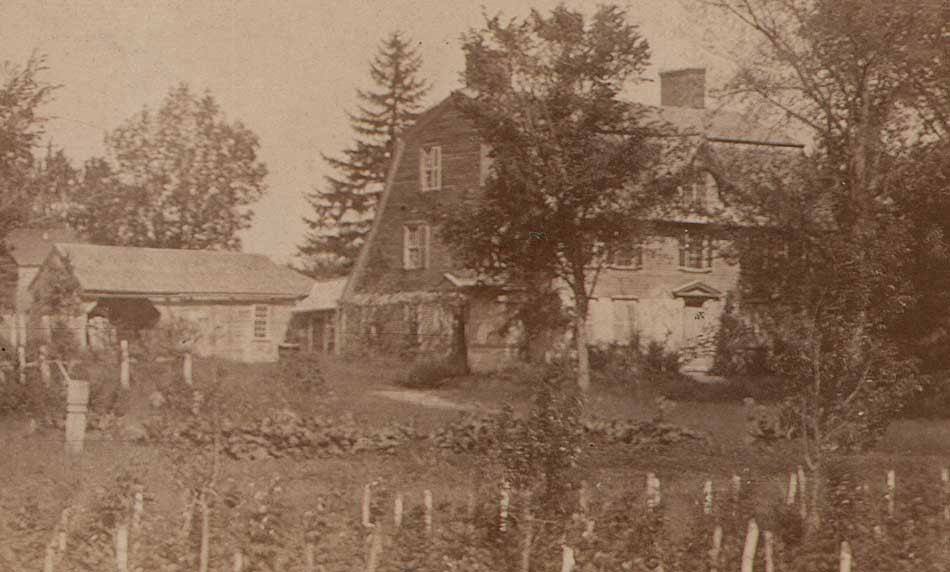 Detail: "Old Manse, No. 3" from: Views in Concord, Mass.: ca. 1885: Alfred Winslow Hosmer, American (1851-1903) Pasted Albumen print on oversized cabinet card with gilt edging: 11.2 x 19.8 | 18.1 x 21.4 cm: Approximately 110 years later, another Hosmer descendent to Private Abner Hosmer, the photographer Alfred Hosmer, photographed scenes in and around Concord like this one for sale as souvenir keepsake cabinet cards of battleground scenes and places, including the Minute Man statue. This view, showing the stately pile The Old Manse, was built in 1770 for the Rev. William Emerson, (1743-1776) whose family witnessed the battle at the Old North Bridge of 19th April 1775 from the upstairs windows of the home. Later, Emerson's grandson, the acclaimed Transcendentalist writer Ralph Waldo Emerson (1803-1882) lived in the home and later wrote his Concord Hymn of 1836 as referenced previously in this post. The photographer Alfred Hosmer, whose surviving archive of over 800 glass plate negatives is housed at the Concord (MA) Free Library, is also significant, according to the library, for "his role in establishing Henry David Thoreau’s reputation as a major American author. He was one of the earliest admirers and promoters of Thoreau’s life and writings. He expressed his sympathy with and interest in Thoreau through his own first-hand observations of the flora and fauna of Concord, his Thoreau-related photography, his correspondence with other Thoreau enthusiasts, and his active collecting of Thoreauviana." From: PhotoSeed Archive
Detail: "Old Manse, No. 3" from: Views in Concord, Mass.: ca. 1885: Alfred Winslow Hosmer, American (1851-1903) Pasted Albumen print on oversized cabinet card with gilt edging: 11.2 x 19.8 | 18.1 x 21.4 cm: Approximately 110 years later, another Hosmer descendent to Private Abner Hosmer, the photographer Alfred Hosmer, photographed scenes in and around Concord like this one for sale as souvenir keepsake cabinet cards of battleground scenes and places, including the Minute Man statue. This view, showing the stately pile The Old Manse, was built in 1770 for the Rev. William Emerson, (1743-1776) whose family witnessed the battle at the Old North Bridge of 19th April 1775 from the upstairs windows of the home. Later, Emerson's grandson, the acclaimed Transcendentalist writer Ralph Waldo Emerson (1803-1882) lived in the home and later wrote his Concord Hymn of 1836 as referenced previously in this post. The photographer Alfred Hosmer, whose surviving archive of over 800 glass plate negatives is housed at the Concord (MA) Free Library, is also significant, according to the library, for "his role in establishing Henry David Thoreau’s reputation as a major American author. He was one of the earliest admirers and promoters of Thoreau’s life and writings. He expressed his sympathy with and interest in Thoreau through his own first-hand observations of the flora and fauna of Concord, his Thoreau-related photography, his correspondence with other Thoreau enthusiasts, and his active collecting of Thoreauviana." From: PhotoSeed Archive
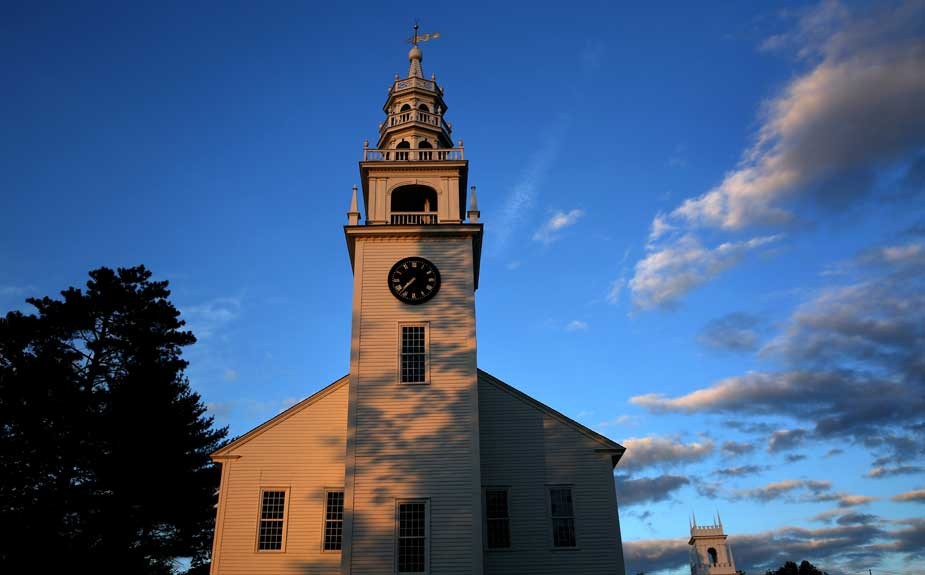 "Witness to a Revolution" (American): 2015: David Spencer for PhotoSeed Archive. With Mount Monadnock just off to the west, the waning light of day washes over the white clapboard siding of the Original Meeting House for the Town of Jaffrey, New Hampshire. Erected in 1775 only two years after the town's incorporation and after American Minutemen first began their armed fight with the British at Concord and Lexington, tradition states the frame of the structure was raised on Saturday, June 17th of that year, with workers recounting they heard booming cannon fire 70 miles east in Boston which they learned the next day was the Battle of Bunker Hill. Originally used by Congregationalists for church services and town business, worship took place here until 1844. The town website gives a few more details: "In 1822, the bell tower and spire were added, paid for by donations on the condition that the Town would buy the bell, which it did the following year. It was cast by the Paul Revere Foundry."
"Witness to a Revolution" (American): 2015: David Spencer for PhotoSeed Archive. With Mount Monadnock just off to the west, the waning light of day washes over the white clapboard siding of the Original Meeting House for the Town of Jaffrey, New Hampshire. Erected in 1775 only two years after the town's incorporation and after American Minutemen first began their armed fight with the British at Concord and Lexington, tradition states the frame of the structure was raised on Saturday, June 17th of that year, with workers recounting they heard booming cannon fire 70 miles east in Boston which they learned the next day was the Battle of Bunker Hill. Originally used by Congregationalists for church services and town business, worship took place here until 1844. The town website gives a few more details: "In 1822, the bell tower and spire were added, paid for by donations on the condition that the Town would buy the bell, which it did the following year. It was cast by the Paul Revere Foundry."
But I’m only one person, what can I do about it but spout a bunch of words? Photography of course. The so-called Universal language. Like everyone’s favorite sports team. Surely one can have opinions concerning old photographs? I’m betting yes and I hope you will.
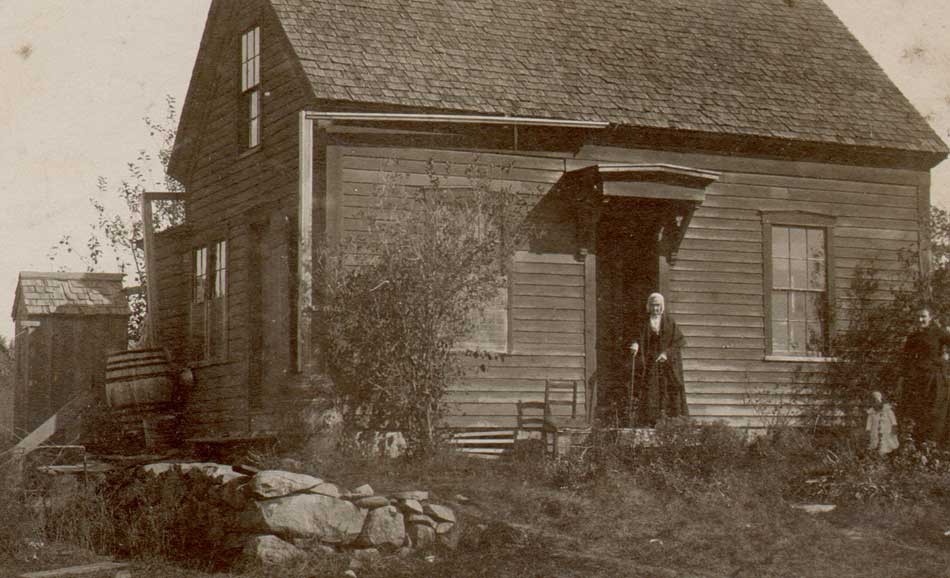 Detail: "Aunt Ward": ca. 1890-1900 : Attributed photographer: Charles Rollins Tucker, American (b. 1868): mounted brown-toned gelatin silver or albumen print on oversized card: 11.1 x 18.4 cm | 20.4 x 25.5 cm. Believed to have been taken in Massachusetts, and with cane firmly held in elderly hand, this unknown "Aunt Ward", who was a blood relation to the photographer, can be seen standing in threshold at center, could rightly epitomize the hardscrabble resourcefulness of a typical New England Yankee before all the modern benefits of the late 20th Century Industrial Revolution kicked into high gear. At the front of her weather-beaten Cape Cod style dwelling can be seen a trusty ladderback garden chair parked to the left of the doorway as well as wooden gutters overhead leading to large rain barrels front and back and anchored from behind at far left by a shingled outhouse. From: PhotoSeed Archive
Detail: "Aunt Ward": ca. 1890-1900 : Attributed photographer: Charles Rollins Tucker, American (b. 1868): mounted brown-toned gelatin silver or albumen print on oversized card: 11.1 x 18.4 cm | 20.4 x 25.5 cm. Believed to have been taken in Massachusetts, and with cane firmly held in elderly hand, this unknown "Aunt Ward", who was a blood relation to the photographer, can be seen standing in threshold at center, could rightly epitomize the hardscrabble resourcefulness of a typical New England Yankee before all the modern benefits of the late 20th Century Industrial Revolution kicked into high gear. At the front of her weather-beaten Cape Cod style dwelling can be seen a trusty ladderback garden chair parked to the left of the doorway as well as wooden gutters overhead leading to large rain barrels front and back and anchored from behind at far left by a shingled outhouse. From: PhotoSeed Archive
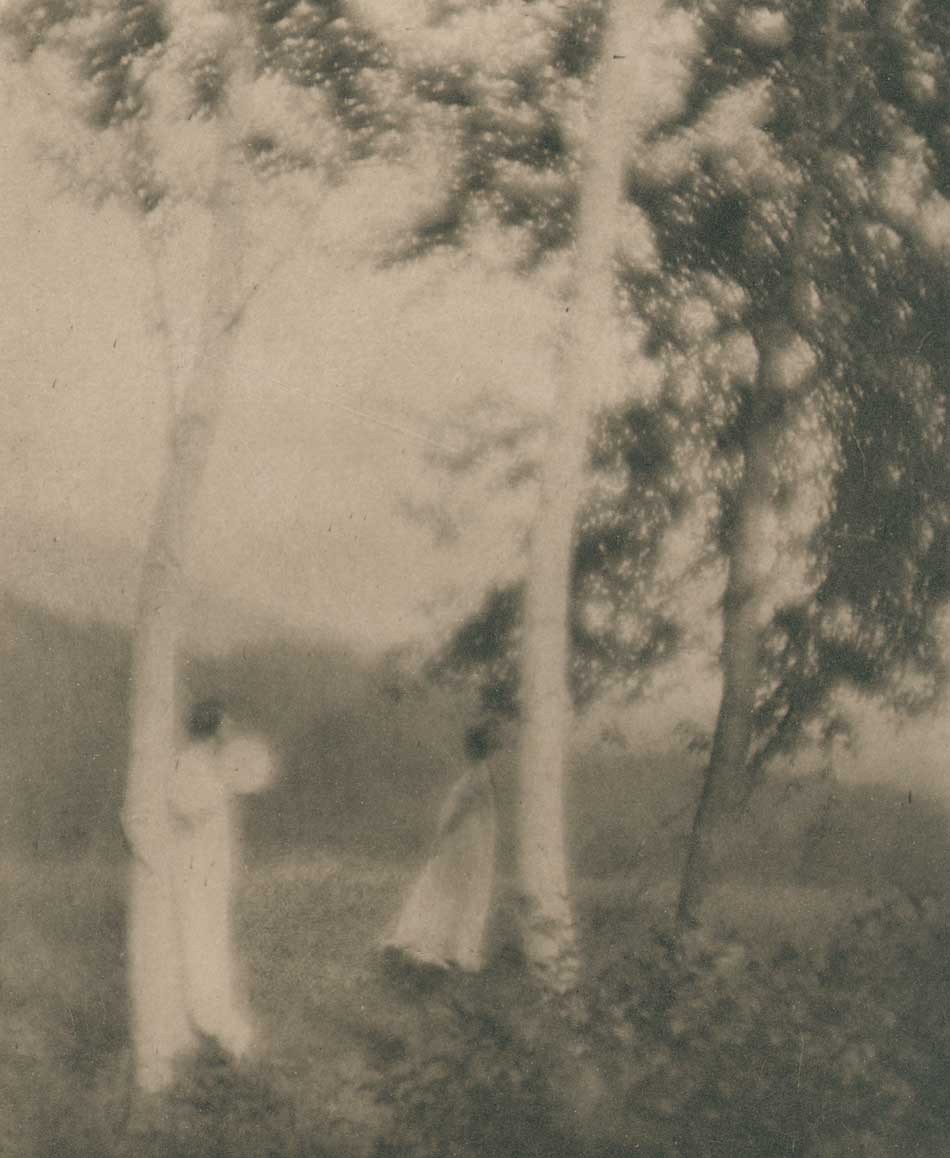 Detail: "VII. White Trees": 1910: George H. Seeley, American (1880-1955) : hand-pulled Japan-paper tissue photogravure by the Manhattan Photogravure Co. included with Camera Work issue XXIX:full image: 19.9 x 15.7 cm: Amateur photographer and painter George Henry Seeley, a native of Stockbridge, Massachusetts, made his living as supervisor of art for his local school district. In order to take full advantage of the showy beauty of the Berkshire region with a hint of the Taconic mountain range seen in the distance, he positioned his sisters in this plein air allegorical composition, with the trunk and back of a white birch tree (Betula papyrifera) anchoring this triangulated landscape at left. From: PhotoSeed Archive
Detail: "VII. White Trees": 1910: George H. Seeley, American (1880-1955) : hand-pulled Japan-paper tissue photogravure by the Manhattan Photogravure Co. included with Camera Work issue XXIX:full image: 19.9 x 15.7 cm: Amateur photographer and painter George Henry Seeley, a native of Stockbridge, Massachusetts, made his living as supervisor of art for his local school district. In order to take full advantage of the showy beauty of the Berkshire region with a hint of the Taconic mountain range seen in the distance, he positioned his sisters in this plein air allegorical composition, with the trunk and back of a white birch tree (Betula papyrifera) anchoring this triangulated landscape at left. From: PhotoSeed Archive
And photographic puns besides the point, I’ve learned there is no such thing as black and white-especially concerning peoples lives and how those lives are lived. Speaking of that aforementioned questionable public discourse, I’m more of the belief life is all about colorful nuance, and unless you have walked a mile in someone’s shoes, as my mother would say, what do you really know to be their reality and truths?
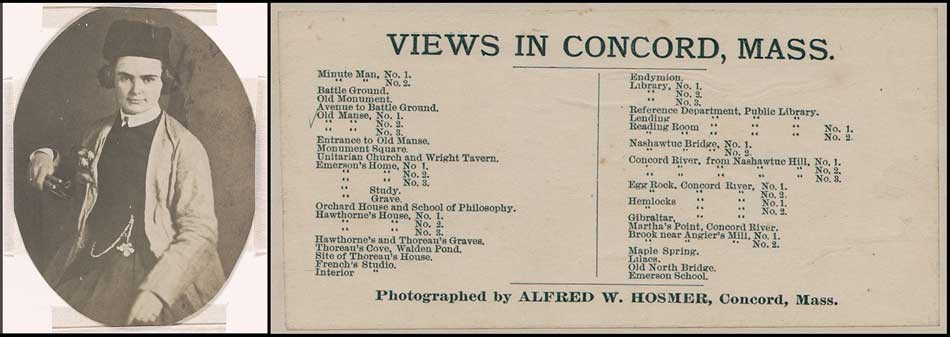 Hosmer & Sculpture: Left: Portrait of sculptor Harriet Goodhue Hosmer (1830-1908): by Frederick DeBourg Richards, American (1822-1903): ca. 1850-60: salted paper print on card mount ; photo (oval) 15.7 x 12.1 cm, on mount 35.5 x 27.9 cm: Considered the most distinguished female sculptor in America during the 19th century, and working in the neoclassical style, Harriet Hosmer clutches her sculpting tools seen at far left while wearing her artist's smock in this portrait probably taken in Rome, Italy. Born 50 years earlier than photographer and painter George Seeley, Hosmer finished her early education just north of Seeley's Stockbridge in the town of Lenox, completing a course of study at Elizabeth Sedgwick’s School for Young Ladies before learning disciplines including rowing, skating and riding. With an interest in anatomy at a young age spurred by her father Hiram's occupation as a physician, her artistic skills began to take form after she took private lessons when only 20. {Women were not allowed to attend medical schools during that time.} She decided to to travel to Rome to further hone her skills and quickly made a name for herself there, receiving her first commission in 1856. Many of her works survive, including a marble sculpture of Puck (Wadsworth Atheneum in Hartford, CT) and a towering 10' likeness in bronze of Missouri Senator Thomas Hart Benton dedicated in 1868 (recently refurbished) and located in Lafayette Park in St. Louis. Of this gender-breaking artist, Hosmer's friend Elizabeth Barrett Browning described Harriet as “a perfectly emancipated female.” from: LOC Call Number: LOT 14120, no. 20. Right: pasted paper label: "Views in Concord, Mass." ca. 1885: on verso of oversized cabinet card "Old Manse, No. 3": Photographed by Alfred W. Hosmer, Concord, Mass. label: 7.0 x 14.4 cm; card: 18.1 x 21.4 cm. Born 20 years after his cousin Harriet Hosmer, Alfred Winslow Hosmer (1851-1903) also had a connection with sculpture via his friendship with fellow Concord, Mass. resident and sculptor Daniel Chester French. French, whose first major commission was the Minute Man statue outlined in this post, also had his Concord art studio photographed by Hosmer, with several cabinet card views including French's life-size nude sculpture of the Greek mythical male shepherd Endymion listed here for sale. From: PhotoSeed Archive
Hosmer & Sculpture: Left: Portrait of sculptor Harriet Goodhue Hosmer (1830-1908): by Frederick DeBourg Richards, American (1822-1903): ca. 1850-60: salted paper print on card mount ; photo (oval) 15.7 x 12.1 cm, on mount 35.5 x 27.9 cm: Considered the most distinguished female sculptor in America during the 19th century, and working in the neoclassical style, Harriet Hosmer clutches her sculpting tools seen at far left while wearing her artist's smock in this portrait probably taken in Rome, Italy. Born 50 years earlier than photographer and painter George Seeley, Hosmer finished her early education just north of Seeley's Stockbridge in the town of Lenox, completing a course of study at Elizabeth Sedgwick’s School for Young Ladies before learning disciplines including rowing, skating and riding. With an interest in anatomy at a young age spurred by her father Hiram's occupation as a physician, her artistic skills began to take form after she took private lessons when only 20. {Women were not allowed to attend medical schools during that time.} She decided to to travel to Rome to further hone her skills and quickly made a name for herself there, receiving her first commission in 1856. Many of her works survive, including a marble sculpture of Puck (Wadsworth Atheneum in Hartford, CT) and a towering 10' likeness in bronze of Missouri Senator Thomas Hart Benton dedicated in 1868 (recently refurbished) and located in Lafayette Park in St. Louis. Of this gender-breaking artist, Hosmer's friend Elizabeth Barrett Browning described Harriet as “a perfectly emancipated female.” from: LOC Call Number: LOT 14120, no. 20. Right: pasted paper label: "Views in Concord, Mass." ca. 1885: on verso of oversized cabinet card "Old Manse, No. 3": Photographed by Alfred W. Hosmer, Concord, Mass. label: 7.0 x 14.4 cm; card: 18.1 x 21.4 cm. Born 20 years after his cousin Harriet Hosmer, Alfred Winslow Hosmer (1851-1903) also had a connection with sculpture via his friendship with fellow Concord, Mass. resident and sculptor Daniel Chester French. French, whose first major commission was the Minute Man statue outlined in this post, also had his Concord art studio photographed by Hosmer, with several cabinet card views including French's life-size nude sculpture of the Greek mythical male shepherd Endymion listed here for sale. From: PhotoSeed Archive
Through the platform of this website, I hope truth and reality of our shared photographic artistic past are presented with enough facts and context to make a difference. I’m hoping conversations will develop because it exists, and they will be shared in some fashion. Facebook likes, page views, and the latest and greatest apps don’t really concern me here. Instead, just about everything you see will be estate fresh, so dig in and have fun.
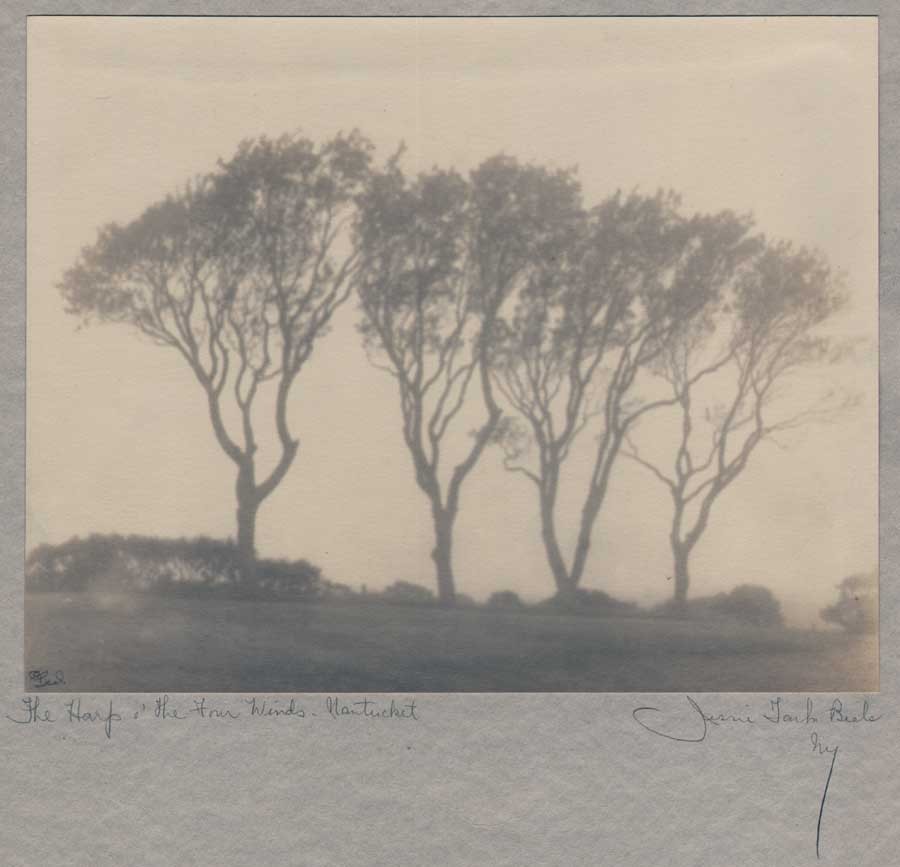 The Harp o' The Four Winds-Nantucket: Jessie Tarbox Beals, American, born Canada: (1870-1942) Gelatin silver print ca. 1905-15 (this example 1920-26 when she rented a salon-studio at 333 Fourth Ave. in N.Y.C.): 19.0 x 23.9 | 43.1 x 28.2 cm : Although not a New England native like Harriet Hosmer, Jessie Tarbox Beals was also groundbreaking for her gender, and is credited as being the first female photojournalist. New England and Massachusetts however played formative roles in her life. According to a short biography provided by the New-York Historical Society, which holds an extensive archive of Beal's work, Jessie was only 17 when she moved to Williamsburg, Mass from Hamilton, Ontario to join an older brother. There, her first job was teaching "seven pupils in a one-room schoolhouse for $7 a week"… later, she became interested in photography the following year in 1888 after acquiring her first camera in a magazine contest. Shortly, she became a professional after investing "$12 and bought a Kodak camera, with which she established a photo studio on the front lawn of her home. Local residents came to have their portraits taken, or to ask for pictures of their houses and other possessions. Beals was aided in her commercial endeavors by groups of Smith College students, (from nearby Northampton-ed) who wanted pictures to be made of their parties and picnics. By the end of two summers she was making more money taking photographs than teaching school." This example of Beal's landscape work was taken in the Bay State in Nantucket, a 1920 caption in the New York Tribune for it stating: "An early morning camera symphony—the Harp o' the Four Winds, Nantucket, Mass., at 5 a. m." From: PhotoSeed Archive
The Harp o' The Four Winds-Nantucket: Jessie Tarbox Beals, American, born Canada: (1870-1942) Gelatin silver print ca. 1905-15 (this example 1920-26 when she rented a salon-studio at 333 Fourth Ave. in N.Y.C.): 19.0 x 23.9 | 43.1 x 28.2 cm : Although not a New England native like Harriet Hosmer, Jessie Tarbox Beals was also groundbreaking for her gender, and is credited as being the first female photojournalist. New England and Massachusetts however played formative roles in her life. According to a short biography provided by the New-York Historical Society, which holds an extensive archive of Beal's work, Jessie was only 17 when she moved to Williamsburg, Mass from Hamilton, Ontario to join an older brother. There, her first job was teaching "seven pupils in a one-room schoolhouse for $7 a week"… later, she became interested in photography the following year in 1888 after acquiring her first camera in a magazine contest. Shortly, she became a professional after investing "$12 and bought a Kodak camera, with which she established a photo studio on the front lawn of her home. Local residents came to have their portraits taken, or to ask for pictures of their houses and other possessions. Beals was aided in her commercial endeavors by groups of Smith College students, (from nearby Northampton-ed) who wanted pictures to be made of their parties and picnics. By the end of two summers she was making more money taking photographs than teaching school." This example of Beal's landscape work was taken in the Bay State in Nantucket, a 1920 caption in the New York Tribune for it stating: "An early morning camera symphony—the Harp o' the Four Winds, Nantucket, Mass., at 5 a. m." From: PhotoSeed Archive
With mountains now in my backyard instead of the view of corn as high as an elephant’s eye from my last Midwest home, I’ve been thinking of late of the early ancestors and the roles they took-small but significant- in shaping from these parts an America I’m proud to call home.
Let me state off the top that my forebears did not come from money. Instead, other than the constant role of being soldiers in America’s early fight for Independence, they were hardscrabble Yankees: industrious farmers, deacons, bricklayers and later in the 19th century, stonemasons.
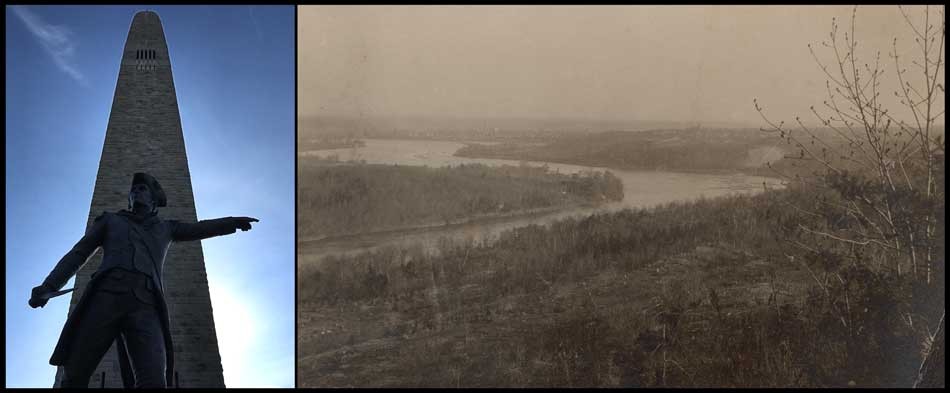 Left: American Revolutionary War Brigadier General John Stark (1728-1822) points the way at the base of the Bennington Battle Monument in Vermont. 2016: David Spencer for PhotoSeed Archive. On August 16, 1777, approximately 2,000 militia members led by John Stark soundly defeated British General John Burgoyne's army made up primarily of Hessians during the Battle of Bennington at Walloomsac, New York. Although the battle lead to Burgoyne's eventual surrender at Saratoga and "galvanized colonial support for the independence movement" (Wikipedia) the battle was not without 30 militia causalities, including 17-year-old Jonathan Hosmer, Jr., (1760-77) the second Hosmer to die in the American Revolution after his uncle Abner nearly two years earlier at Concord. Right: "The Connecticut": 1897: Charles Rollins Tucker, American (b. 1868): albumen print : 12.4 x 17.6 cm | 16.6 x 21.4 cm: Besides being a primary inland navigational route used extensively by Native American tribes hundreds of years before European colonization, the Connecticut River and its watershed encompassing the fertile Connecticut River Valley remains largely responsible for the regions continued development. This longest of New England rivers not only continues to fuel agriculture on a large scale but beginning in the late 20th Century, with its' large number of waterfalls, provided plenty of factories situated along its' banks the energy needed to power the Industrial Revolution, with the cities of Hartford, Conn. and Springfield, Mass being two of its most prominent to gain population and prominence. From: PhotoSeed Archive
Left: American Revolutionary War Brigadier General John Stark (1728-1822) points the way at the base of the Bennington Battle Monument in Vermont. 2016: David Spencer for PhotoSeed Archive. On August 16, 1777, approximately 2,000 militia members led by John Stark soundly defeated British General John Burgoyne's army made up primarily of Hessians during the Battle of Bennington at Walloomsac, New York. Although the battle lead to Burgoyne's eventual surrender at Saratoga and "galvanized colonial support for the independence movement" (Wikipedia) the battle was not without 30 militia causalities, including 17-year-old Jonathan Hosmer, Jr., (1760-77) the second Hosmer to die in the American Revolution after his uncle Abner nearly two years earlier at Concord. Right: "The Connecticut": 1897: Charles Rollins Tucker, American (b. 1868): albumen print : 12.4 x 17.6 cm | 16.6 x 21.4 cm: Besides being a primary inland navigational route used extensively by Native American tribes hundreds of years before European colonization, the Connecticut River and its watershed encompassing the fertile Connecticut River Valley remains largely responsible for the regions continued development. This longest of New England rivers not only continues to fuel agriculture on a large scale but beginning in the late 20th Century, with its' large number of waterfalls, provided plenty of factories situated along its' banks the energy needed to power the Industrial Revolution, with the cities of Hartford, Conn. and Springfield, Mass being two of its most prominent to gain population and prominence. From: PhotoSeed Archive
But like all families that have been here a while, I also have several relatives I’m quite certain are famous, and am most proud to say even significant. For details, please consult the small print under the respective photographs in this post for Private Abner Hosmer, an 18th Century Concord, Mass. Minute Man and Harriet Goodhue Hosmer, 19th Century groundbreaking American female sculptor.
The Hosmer’s & the Great Migration
The ancestors on my mother’s side, the Hosmer’s of Hawkhurst, Kent in England, were part of the so-called Great Migration. I’m now counted as a 12th generation Hosmer descendant, the first landing on these shores being James Hosmer, (b. 1605) a clothier who made the ocean voyage to the new world with his family aboard the good ship Elizabeth of London in April of 1635. They called themselves Puritans and were seeking religious independence from the Crown. (Charles I) It might have stopped there, and I for one am ever grateful it didn’t, because James’ wife Ann and two young daughters died during the trip or shortly after they arrived and settled in Cambridge in the Massachusetts Bay Colony. He remarried however, twice again due to death from disease in this new world, and went on to become one of the founders of Concord, Mass. two years later in 1637, where he made his living laying out grants of farmland and later serving as town selectman in 1660.
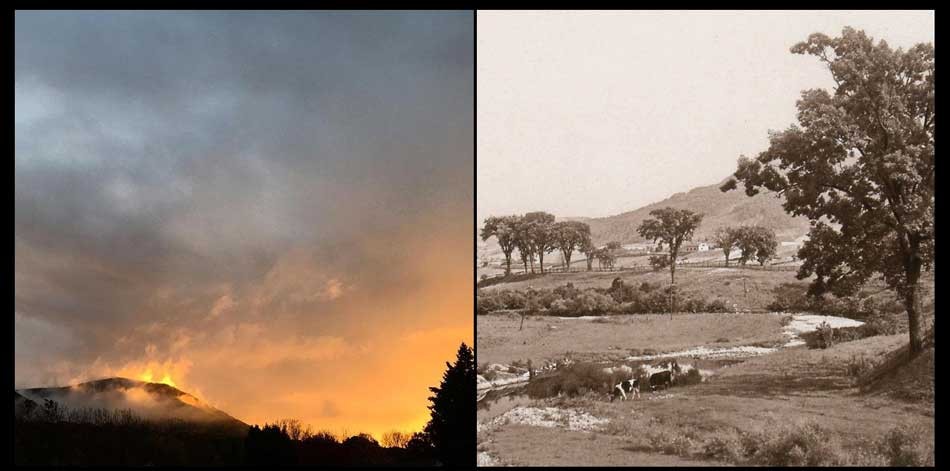 The Berkshires: Modern & Vintage: Left: "Sunset Glow over Mount Greylock State Reservation": by Shannon O'Brien: North Adams, Mass: Fall, 2016 (iPhone): Right: Detail: "Williamstown Hills, Williamstown" (Looking toward North Adams) "The encircling hills of Berkshire." : Arthur (Wentworth) Scott, American: 1899: hand-pulled photogravure plate included in volume: Nature Studies in Berkshire by John Coleman Adams published by G.P. Putnam's Sons: In the volume's introduction, "Our Berkshire" Coleman Adams sets the stage for the reader: "To know Berkshire is to love it. To love it is to feel a sort of proprietorship in it, a pride in its glories, a joy in its beauties, such as owners have in their estates and patriots in their native land. He who was born here clings to the soil if he stays, or reverts to it if he moves from it, with a New England steadfastness as intense and deep as a moral principle." (p. 3) From: Archive.org
The Berkshires: Modern & Vintage: Left: "Sunset Glow over Mount Greylock State Reservation": by Shannon O'Brien: North Adams, Mass: Fall, 2016 (iPhone): Right: Detail: "Williamstown Hills, Williamstown" (Looking toward North Adams) "The encircling hills of Berkshire." : Arthur (Wentworth) Scott, American: 1899: hand-pulled photogravure plate included in volume: Nature Studies in Berkshire by John Coleman Adams published by G.P. Putnam's Sons: In the volume's introduction, "Our Berkshire" Coleman Adams sets the stage for the reader: "To know Berkshire is to love it. To love it is to feel a sort of proprietorship in it, a pride in its glories, a joy in its beauties, such as owners have in their estates and patriots in their native land. He who was born here clings to the soil if he stays, or reverts to it if he moves from it, with a New England steadfastness as intense and deep as a moral principle." (p. 3) From: Archive.org
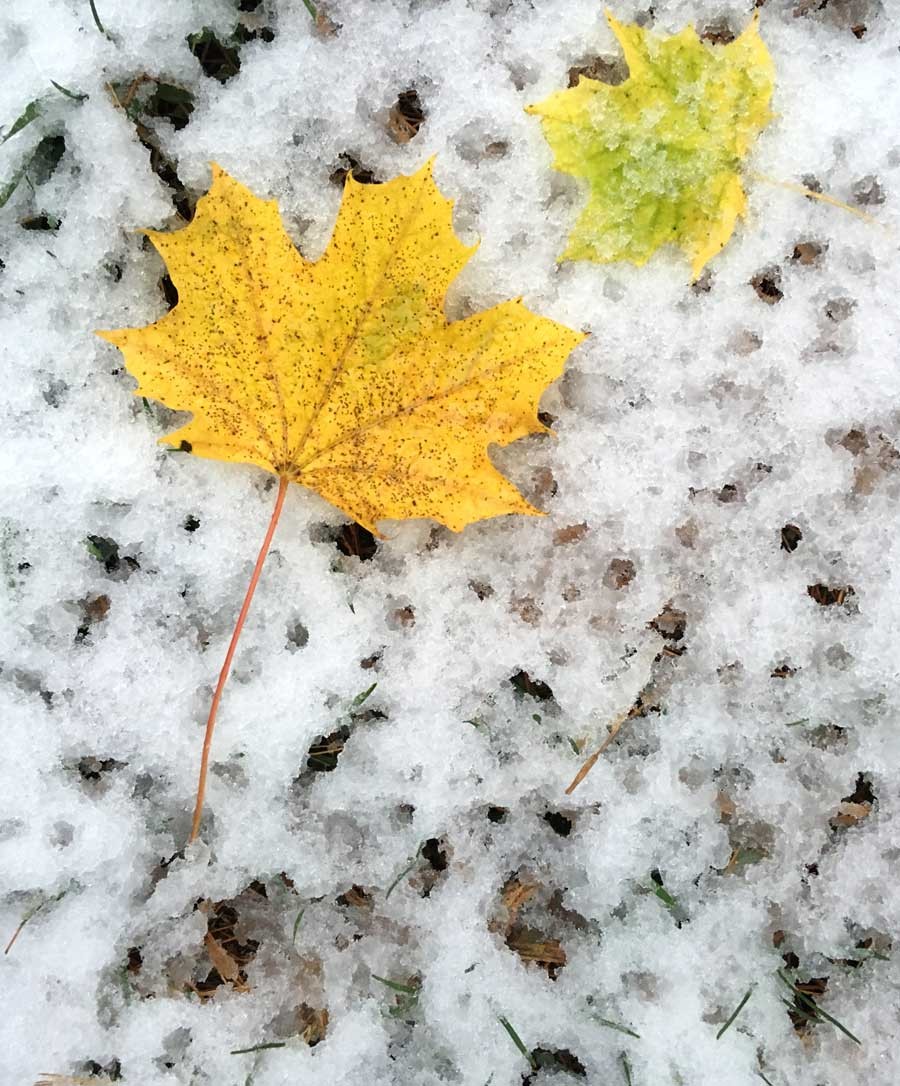 "Fall & First Snow: Williamstown": 2016: David Spencer for PhotoSeed Archive (iPhone)
"Fall & First Snow: Williamstown": 2016: David Spencer for PhotoSeed Archive (iPhone)
As a native of the Nutmeg state, I’m now proud to hail from the Bay state in the Berkshire Hills. Time and inclination willing, there will be many more photographic treasures from the past displayed for public consumption on PhotoSeed, as well as the planned rollout in the coming year-finally-of PhotoSeed Gallery, an e-commerce platform through Shopify selling vintage work. As your intrepid explorer and guide, I hope to present you with something worth thinking and conversing about in the new year and beyond.
-David Spencer-
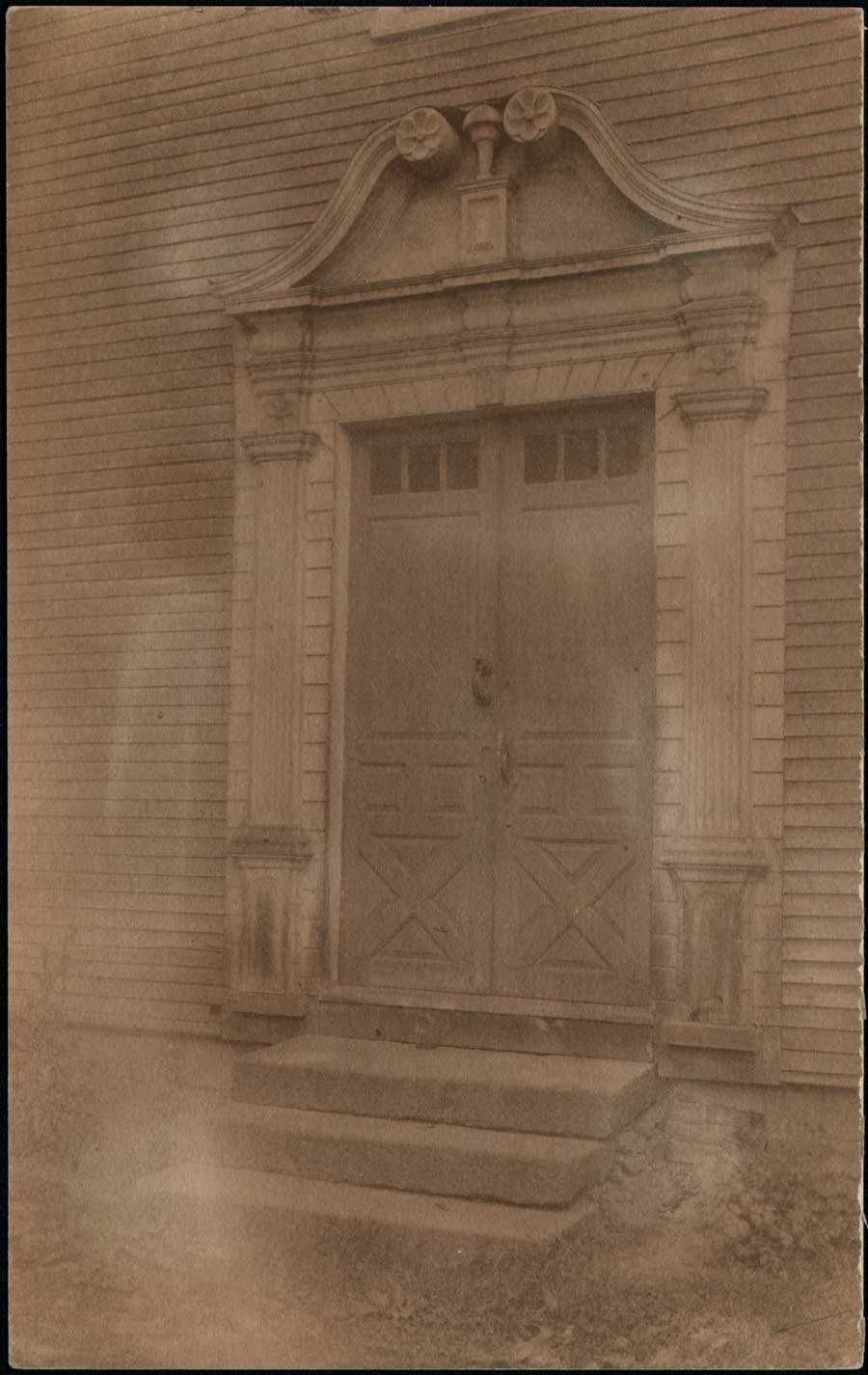 "Williams Door": Frances and Mary Allen, American: ca. 1895-1905: Platinum print: 20.2 x 12.7 cm: Made from native old-growth, eastern white pine, this view shows the Connecticut River Valley Doorway built by joiner Samuel Partridge which graces the front of the John Williams house in Old Deerfield Village, Mass. The home, and doorway, (since removed in 2001, placed on display and replaced by a reproduction) is named for the Rev. John Williams (1664-1729) in the village, and is now owned by Deerfield Academy. (the door is featured in the private school's seal) Rev. Williams was "a New England Puritan minister who became famous for The Redeemed Captive, his account of his captivity by the Mohawk after the Deerfield Massacre during Queen Anne's War." (Wikipedia) Working in the pictorial photographic style at the end and beginning of the 20th Century, the Allen Sisters of Deerfield did a brisk trade for tourists through their staged genre scenes and colonial views of Old Deerfield, including the Williams door seen here which carries a price tag on the verso of .50 cents. The home was originally built in 1760 by the Rev. Williams' son Elijah Williams, a shopkeeper and tavern-owner. From: PhotoSeed Archive
"Williams Door": Frances and Mary Allen, American: ca. 1895-1905: Platinum print: 20.2 x 12.7 cm: Made from native old-growth, eastern white pine, this view shows the Connecticut River Valley Doorway built by joiner Samuel Partridge which graces the front of the John Williams house in Old Deerfield Village, Mass. The home, and doorway, (since removed in 2001, placed on display and replaced by a reproduction) is named for the Rev. John Williams (1664-1729) in the village, and is now owned by Deerfield Academy. (the door is featured in the private school's seal) Rev. Williams was "a New England Puritan minister who became famous for The Redeemed Captive, his account of his captivity by the Mohawk after the Deerfield Massacre during Queen Anne's War." (Wikipedia) Working in the pictorial photographic style at the end and beginning of the 20th Century, the Allen Sisters of Deerfield did a brisk trade for tourists through their staged genre scenes and colonial views of Old Deerfield, including the Williams door seen here which carries a price tag on the verso of .50 cents. The home was originally built in 1760 by the Rev. Williams' son Elijah Williams, a shopkeeper and tavern-owner. From: PhotoSeed Archive
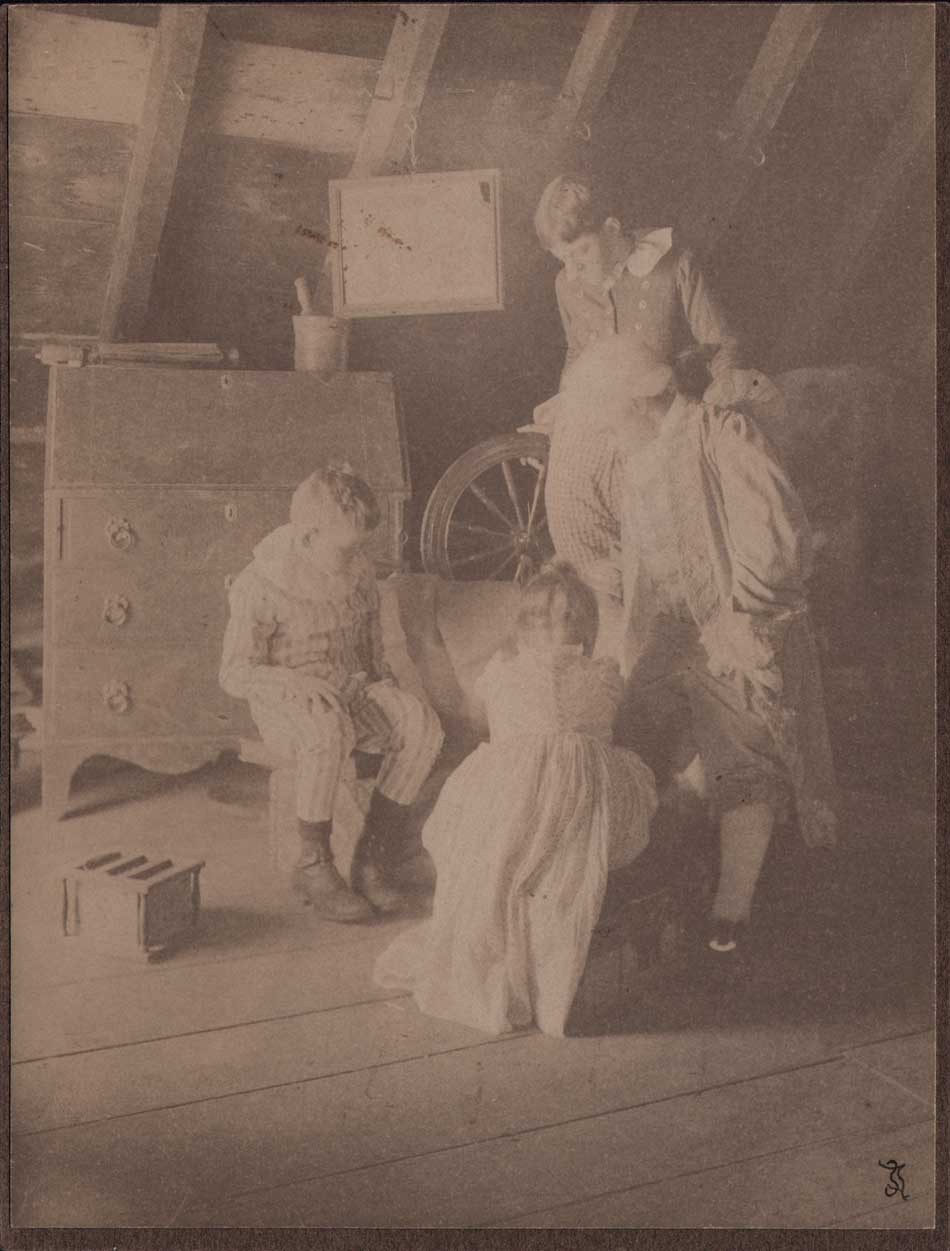 "Tom and Betty Put the Things on Ammi": 1910: Sarah Jane Dudley, American: (1859-1940) frontis plate to the volume: A Daughter of the Revolution by Jessie Anderson Chase: Boston: Richard G. Badger: The Gorham Press 1910: Platinum print, mounted, with Dudley's cipher at lower right corner: 20.2 x 15.3 | 20.5 x 15.7 cm: Besides her interest in amateur photography, Whitensville, Massachusetts native Jane Dudley, a graduate of Wheaton Female Seminary, was the organizer of the Samaritan Association of Whitinsville. This vintage example of a genre study showing children dressed in 18th century clothing while dressing their doll in an attic was done in the very popular style at the beginning of the 20th Century known as "Colonial Revival", which took advantage of America's love of its' colonial past. From: PhotoSeed Archive
"Tom and Betty Put the Things on Ammi": 1910: Sarah Jane Dudley, American: (1859-1940) frontis plate to the volume: A Daughter of the Revolution by Jessie Anderson Chase: Boston: Richard G. Badger: The Gorham Press 1910: Platinum print, mounted, with Dudley's cipher at lower right corner: 20.2 x 15.3 | 20.5 x 15.7 cm: Besides her interest in amateur photography, Whitensville, Massachusetts native Jane Dudley, a graduate of Wheaton Female Seminary, was the organizer of the Samaritan Association of Whitinsville. This vintage example of a genre study showing children dressed in 18th century clothing while dressing their doll in an attic was done in the very popular style at the beginning of the 20th Century known as "Colonial Revival", which took advantage of America's love of its' colonial past. From: PhotoSeed Archive
From: A Dissertation on the Canon and Feudal Law-1765
Liberty cannot be preserved without a general knowledge among the people, who have a right, from the frame of their nature, to knowledge, as their great Creator, who does nothing in vain, has given them understandings, and a desire to know; but besides this, they have a right, an indisputable, unalienable, indefeasible, divine right to that most dreaded and envied kind of knowledge, I mean, of the characters and conduct of their rulers.
–John Adams
Stages for Ages
Posted April 2016 in Exhibitions, History of Photography, New Additions, Publishing, Significant Photographers
All the world’s a stage, And all the men and women merely players: They have their exits and their entrances; And one man in his time plays many parts, His acts being seven ages.
-From As You Like It, Act II. Scene VII, Jaques’s speech
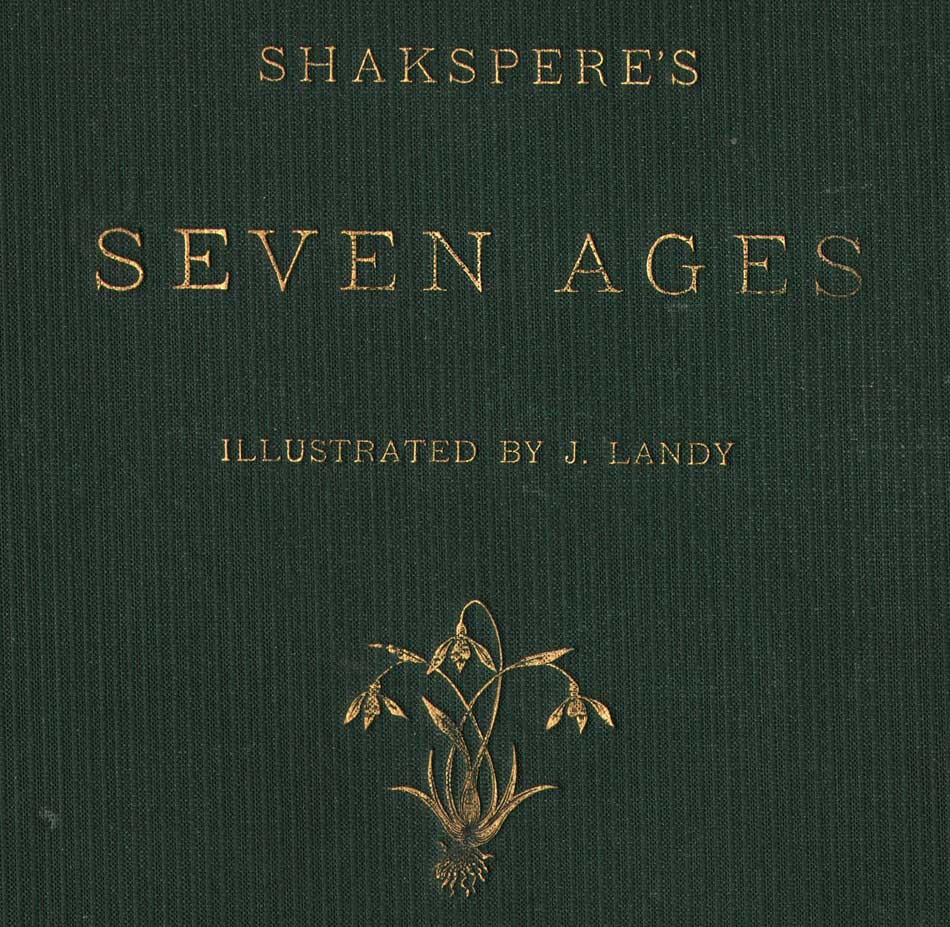 Detail: book cover: "Shakspere’s Seven Ages" Illustrated by J. Landy: Octavo with letterpress and seven individual pasted albumen portrait photographs by Landy: Cincinnati: Robert Clarke & Co., 1876: from: PhotoSeed Archive
Detail: book cover: "Shakspere’s Seven Ages" Illustrated by J. Landy: Octavo with letterpress and seven individual pasted albumen portrait photographs by Landy: Cincinnati: Robert Clarke & Co., 1876: from: PhotoSeed Archive
In life, Birthdays typically get all the attention. At least while your friends are around. Not so much death. But for certain souls long departed this mortal coil, it’s just as important. This is especially true for English playwright and poet William Shakespeare, whose passing on April 23, 1616 at 52 years of age- or 400 years ago today- seems like a perfectly good excuse to throw a party as well. Cincinnati portrait photographer James M. Landy (1838-1897) would have readily agreed, and he used the excuse of another anniversary-America’s first Centennial held in 1876 in Philadelphia- to showcase his new series of “character photographs” illustrating the Bard’s Seven Ages of Man from his play As You Like It . (1.)
Come along on a short photographic journey exploring these ages of the male species, according to Shakespeare. Have they changed with the passage of time?
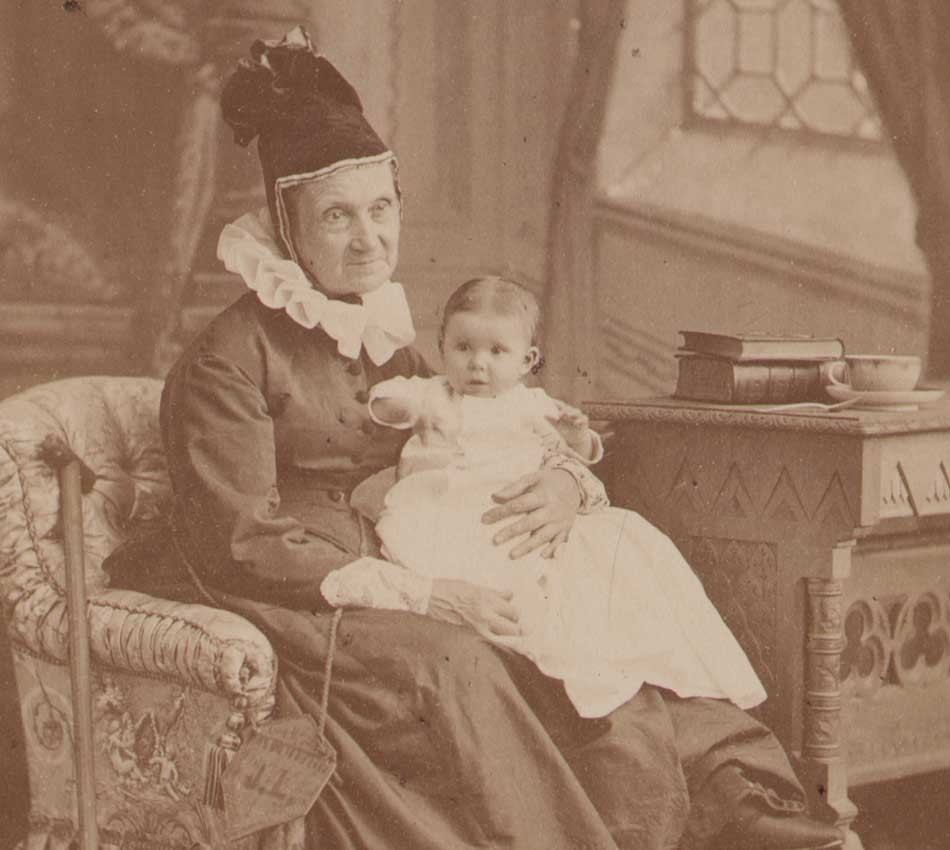 The First Age: Detail: "The Infant" : James M. Landy, American: 1876: pasted albumen print included in the volume "Shakspere’s Seven Ages": 14.0 x 9.9 | 24.7 x 19.0 cm: Cincinnati: Robert Clarke & Co., 1876. Captioned text opposite book plate: "At first the infant, Mewling and puking in the nurse’s arms.": From: PhotoSeed Archive
The First Age: Detail: "The Infant" : James M. Landy, American: 1876: pasted albumen print included in the volume "Shakspere’s Seven Ages": 14.0 x 9.9 | 24.7 x 19.0 cm: Cincinnati: Robert Clarke & Co., 1876. Captioned text opposite book plate: "At first the infant, Mewling and puking in the nurse’s arms.": From: PhotoSeed Archive
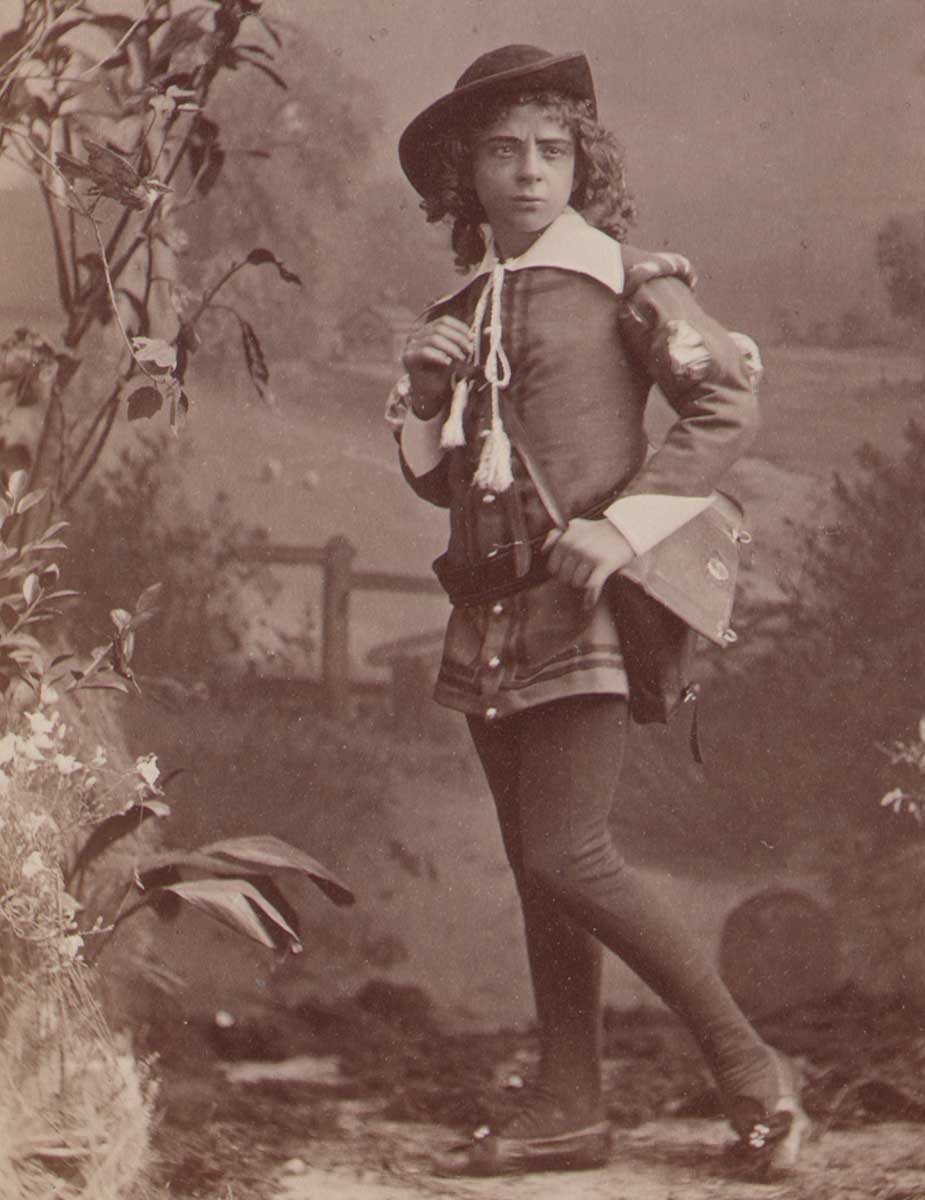 The Second Age: Detail: "The Schoolboy": James M. Landy, American: 1876: pasted albumen print included in the volume "Shakspere’s Seven Ages": 14.0 x 9.9 | 24.7 x 19.0 cm: Cincinnati: Robert Clarke & Co., 1876. Captioned text opposite book plate: "Then the whining school-boy, with his satchel, And shining morning face, creeping like snail Unwillingly to school." From: PhotoSeed Archive
The Second Age: Detail: "The Schoolboy": James M. Landy, American: 1876: pasted albumen print included in the volume "Shakspere’s Seven Ages": 14.0 x 9.9 | 24.7 x 19.0 cm: Cincinnati: Robert Clarke & Co., 1876. Captioned text opposite book plate: "Then the whining school-boy, with his satchel, And shining morning face, creeping like snail Unwillingly to school." From: PhotoSeed Archive
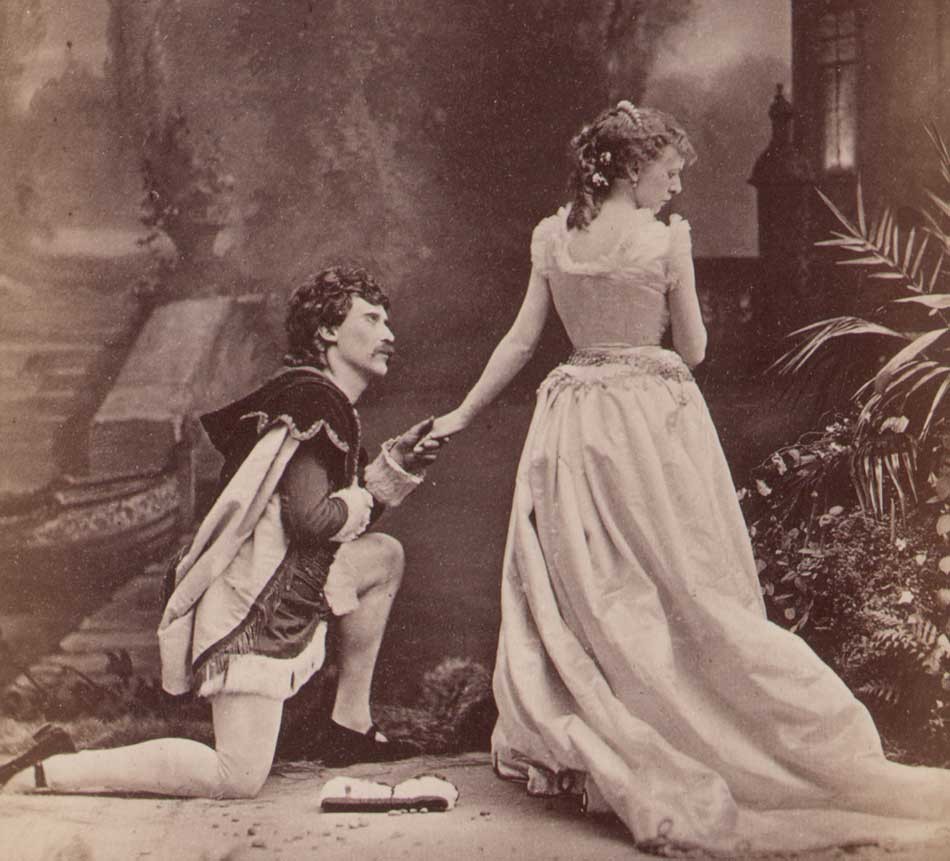 The Third Age: Detail: "The Lover": James M. Landy, American: 1876: pasted albumen print included in the volume "Shakspere’s Seven Ages": 14.3 x 9.9 | 24.7 x 19.0 cm: Cincinnati: Robert Clarke & Co., 1876. Captioned text opposite book plate: "And then the lover, Sighing like furnace, with a woful ballad Made to his mistress’ eyebrow." From: PhotoSeed Archive
The Third Age: Detail: "The Lover": James M. Landy, American: 1876: pasted albumen print included in the volume "Shakspere’s Seven Ages": 14.3 x 9.9 | 24.7 x 19.0 cm: Cincinnati: Robert Clarke & Co., 1876. Captioned text opposite book plate: "And then the lover, Sighing like furnace, with a woful ballad Made to his mistress’ eyebrow." From: PhotoSeed Archive
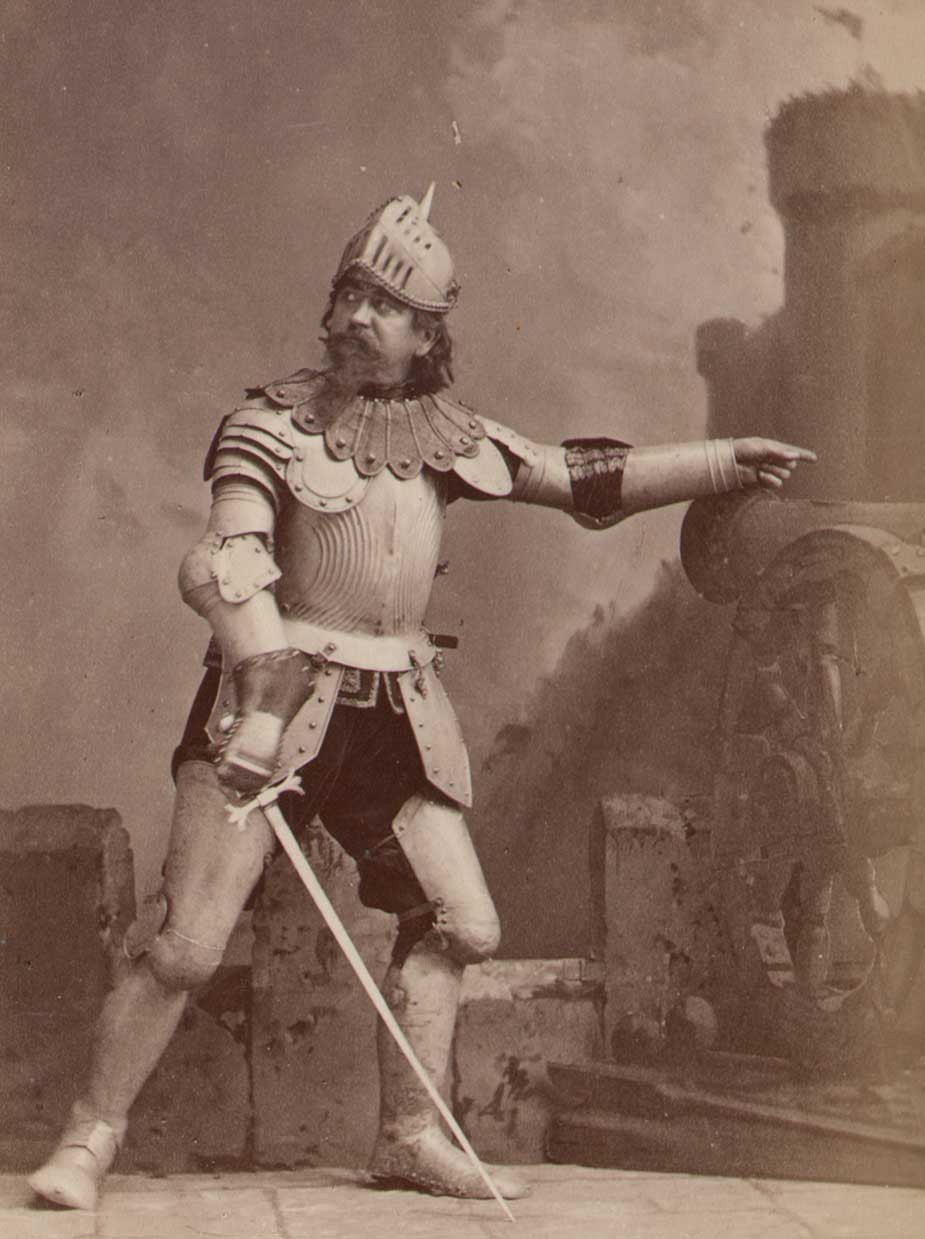 The Fourth Age: Detail: "The Soldier": James M. Landy, American: 1876: pasted albumen print included in the volume "Shakspere’s Seven Ages": 14.0 x 9.9 | 24.7 x 19.0 cm: Cincinnati: Robert Clarke & Co., 1876. Captioned text opposite book plate: "Then a soldier, Full of strange oaths, and bearded like the pard, Jealous in honor, sudden and quick in quarrel, Seeking the bubble reputation Even in the cannon’s mouth." From: PhotoSeed Archive
The Fourth Age: Detail: "The Soldier": James M. Landy, American: 1876: pasted albumen print included in the volume "Shakspere’s Seven Ages": 14.0 x 9.9 | 24.7 x 19.0 cm: Cincinnati: Robert Clarke & Co., 1876. Captioned text opposite book plate: "Then a soldier, Full of strange oaths, and bearded like the pard, Jealous in honor, sudden and quick in quarrel, Seeking the bubble reputation Even in the cannon’s mouth." From: PhotoSeed Archive
 The Fifth Age: "The Justice": James M. Landy, American: 1876: pasted albumen print included in the volume "Shakspere’s Seven Ages": 14.3 x 9.7 | 24.7 x 19.0 cm: Cincinnati: Robert Clarke & Co., 1876. Captioned text opposite book plate: "And then the Justice, In fair round belly, with good capon lin'd, With eyes severe, and beard of formal cut, Full of wise saws and modern instances; And so he plays his part." From: PhotoSeed Archive
The Fifth Age: "The Justice": James M. Landy, American: 1876: pasted albumen print included in the volume "Shakspere’s Seven Ages": 14.3 x 9.7 | 24.7 x 19.0 cm: Cincinnati: Robert Clarke & Co., 1876. Captioned text opposite book plate: "And then the Justice, In fair round belly, with good capon lin'd, With eyes severe, and beard of formal cut, Full of wise saws and modern instances; And so he plays his part." From: PhotoSeed Archive
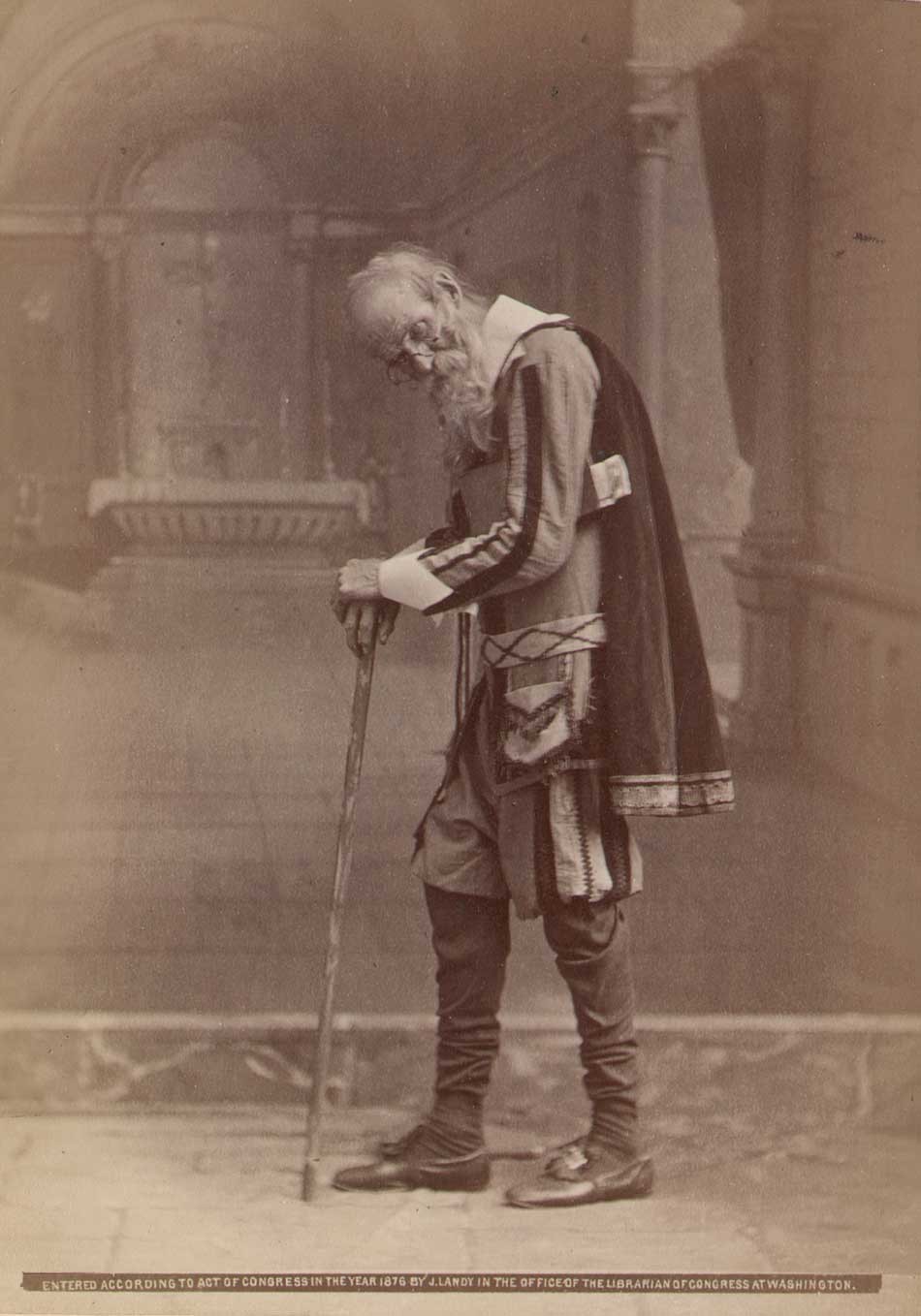 The Sixth Age: "The Lean and Slipper’d Pantaloon": James M. Landy, American: 1876: pasted albumen print included in the volume "Shakspere’s Seven Ages": 14.0 x 9.9 | 24.7 x 19.0 cm: Cincinnati: Robert Clarke & Co., 1876. Captioned text opposite book plate: "The sixth age shifts Into the lean and slipper’d pantaloon, With spectacles on nose and pouch on side, His youthful hose well saved, a world too wide For his shrunk shank; and his big manly voice, Turning again toward childish treble, pipes And whistles in his sound." From: PhotoSeed Archive
The Sixth Age: "The Lean and Slipper’d Pantaloon": James M. Landy, American: 1876: pasted albumen print included in the volume "Shakspere’s Seven Ages": 14.0 x 9.9 | 24.7 x 19.0 cm: Cincinnati: Robert Clarke & Co., 1876. Captioned text opposite book plate: "The sixth age shifts Into the lean and slipper’d pantaloon, With spectacles on nose and pouch on side, His youthful hose well saved, a world too wide For his shrunk shank; and his big manly voice, Turning again toward childish treble, pipes And whistles in his sound." From: PhotoSeed Archive
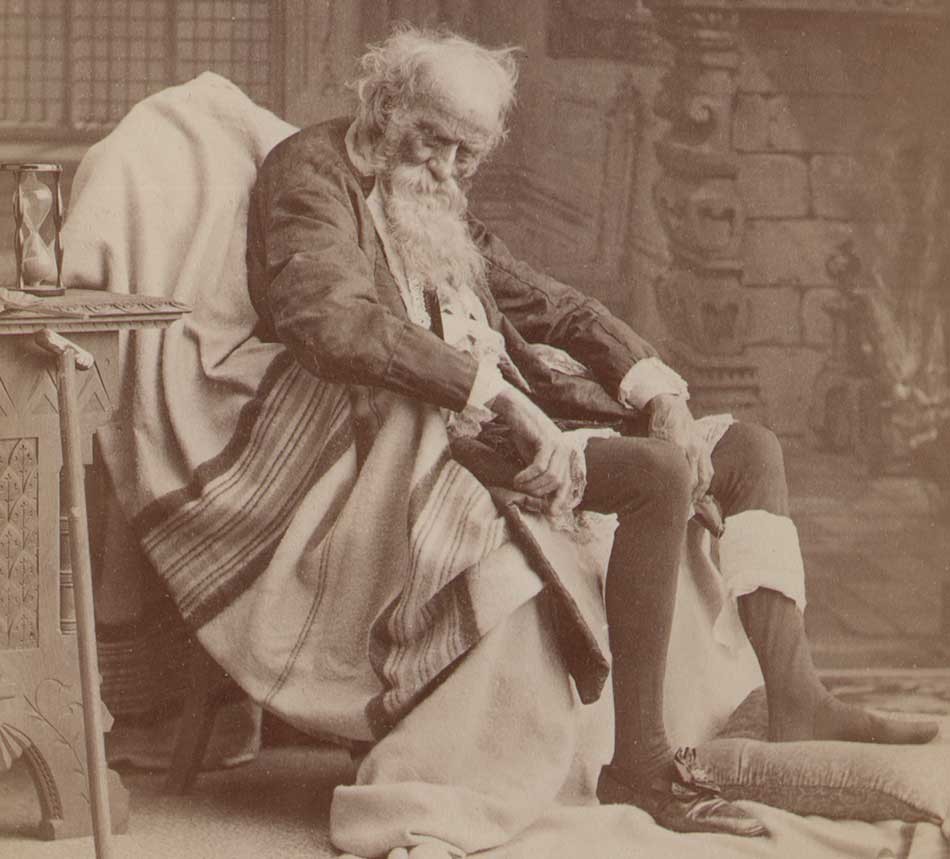 The Seventh Age: Detail: "Sans Teeth, Sans Eyes, Sans Taste, Sans Everything": James M. Landy, American: 1876: pasted albumen print included in the volume "Shakspere’s Seven Ages": 14.0 x 9.9 | 24.7 x 19.0 cm: Cincinnati: Robert Clarke & Co., 1876. Captioned text opposite book plate: "Last scene of all That ends this strange eventful history, Is second childishness and mere oblivion— Sans teeth, sans eyes, sans taste, sans everything.” From: PhotoSeed Archive
The Seventh Age: Detail: "Sans Teeth, Sans Eyes, Sans Taste, Sans Everything": James M. Landy, American: 1876: pasted albumen print included in the volume "Shakspere’s Seven Ages": 14.0 x 9.9 | 24.7 x 19.0 cm: Cincinnati: Robert Clarke & Co., 1876. Captioned text opposite book plate: "Last scene of all That ends this strange eventful history, Is second childishness and mere oblivion— Sans teeth, sans eyes, sans taste, sans everything.” From: PhotoSeed Archive
1. James Landy: from: Artists in Ohio, 1787-1900: A Biographical Dictionary, Mary Sayre Haverstock et al: Kent State University Press, 2000: p. 506
SpringSprung
Posted April 2016 in Alternate Processes, Color Photography, Fashion Photography, New Additions, Unknown Photographers
The Northern Hemisphere has once again thankfully undergone rebirth, becoming the season of spring and with it, all the hope it represents for the continuation of our natural and human worlds.
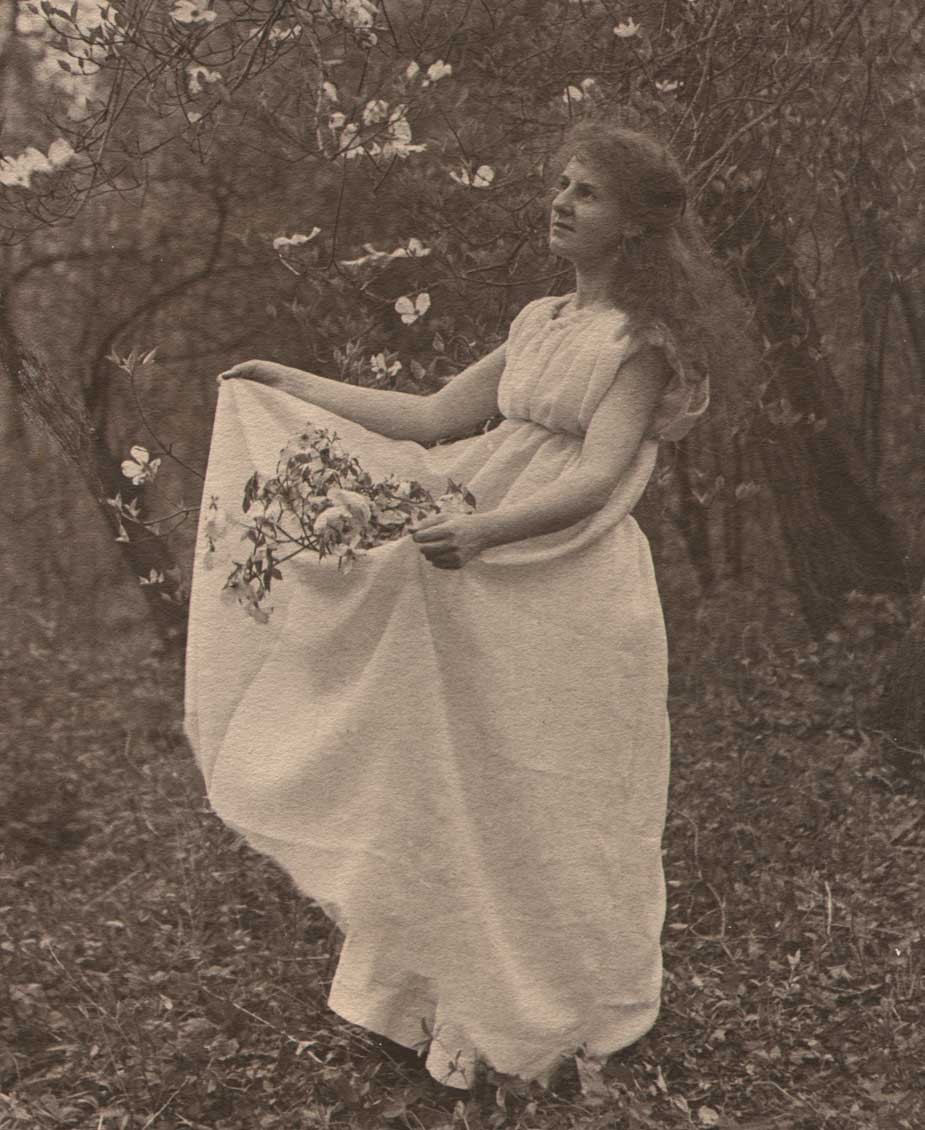 Detail: "Curtis High School Girl Gathering Dogwood Boughs": Charles Rollins Tucker: American: platinum: ca. 1910-15: 19.7 x 13.1 | 30.5 x 23.3 cm: A genre landscape study celebrating both spring and womanhood, the model is perhaps a thespian known to have attended Curtis High School on Staten Island in New York City, where photographer C.R. Tucker taught Physics at the time. From: PhotoSeed Archive
Detail: "Curtis High School Girl Gathering Dogwood Boughs": Charles Rollins Tucker: American: platinum: ca. 1910-15: 19.7 x 13.1 | 30.5 x 23.3 cm: A genre landscape study celebrating both spring and womanhood, the model is perhaps a thespian known to have attended Curtis High School on Staten Island in New York City, where photographer C.R. Tucker taught Physics at the time. From: PhotoSeed Archive
Photographically, with the exceptions of those open-minded enough to embrace the obvious-something Alfred Stieglitz seized upon in 1893 when winter proved more than suitable for subject matter- the majority of amateurs a bit later at the turn of the 20th century seemed interested in dusting off their cameras only when those first buds and flowers of the season awoke once more.
This abbreviated compilation of images spanning the 1890’s through about 1940 from the PhotoSeed Archive-no matter how dated they may appear from the mores of days long gone by- is a reaffirmation dedicated to you that spring’s beauty and potential might give us all a bit of hope towards the future betterment of our often fragmented, present-day world. David Spencer- April, 2016
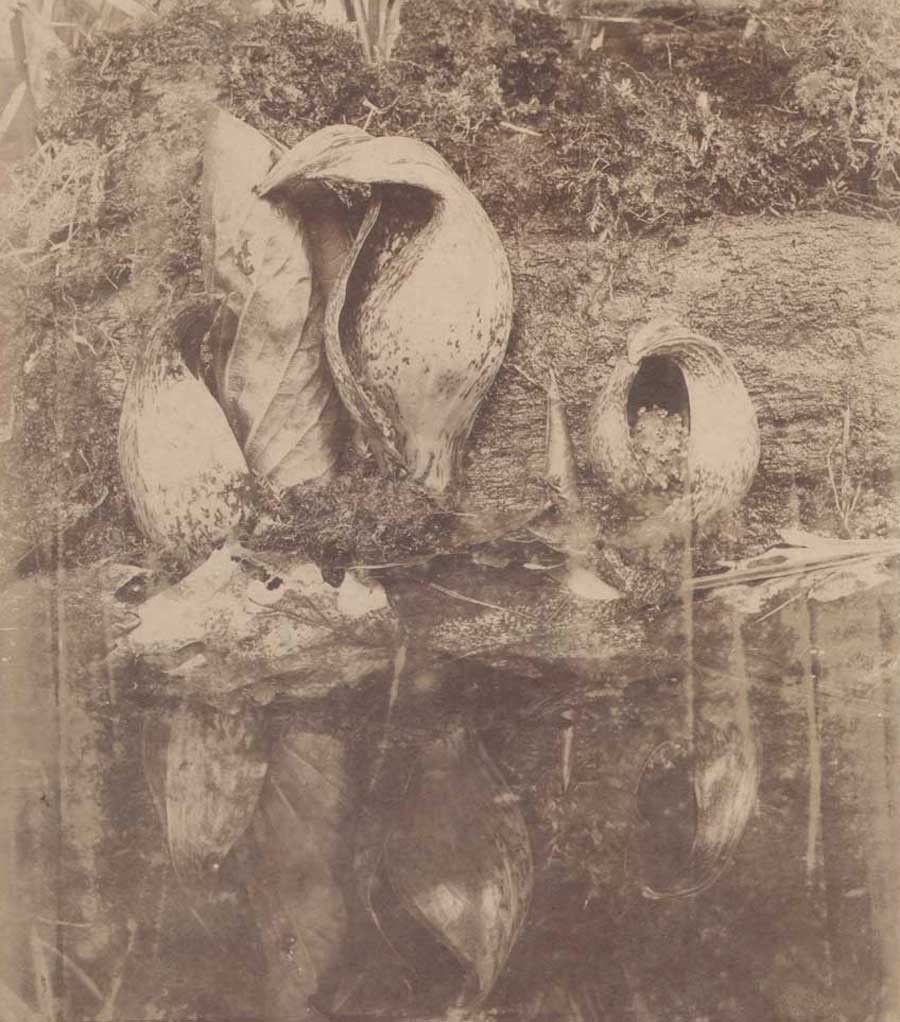 Detail: "Harbingers of Spring": Louise Birt Baynes: American: gelatin silver: 1904: 20.8 x 15.5 | 35.6 x 27.9 cm: This study of skunk cabbage growing in the spring time may have been taken using an artificial light source. Author Frank Roy Fraprie mentioned the work in his article on photographing wild flowers for the March, 1904 issue of Boston’s Photo-Era magazine: "The plant must be photographed in its surroundings, for it has no stem or leaves at this season, to make possible a graceful arrangement at home, even if one were inclined to extend it hospitality. Mrs. Baynes has conquered all these difficulties, and her picture, “Harbingers of Spring,” is interesting to both the naturalist and the artistic photographer, - to one for its fidelity and to the other for its good composition." From: PhotoSeed Archive
Detail: "Harbingers of Spring": Louise Birt Baynes: American: gelatin silver: 1904: 20.8 x 15.5 | 35.6 x 27.9 cm: This study of skunk cabbage growing in the spring time may have been taken using an artificial light source. Author Frank Roy Fraprie mentioned the work in his article on photographing wild flowers for the March, 1904 issue of Boston’s Photo-Era magazine: "The plant must be photographed in its surroundings, for it has no stem or leaves at this season, to make possible a graceful arrangement at home, even if one were inclined to extend it hospitality. Mrs. Baynes has conquered all these difficulties, and her picture, “Harbingers of Spring,” is interesting to both the naturalist and the artistic photographer, - to one for its fidelity and to the other for its good composition." From: PhotoSeed Archive
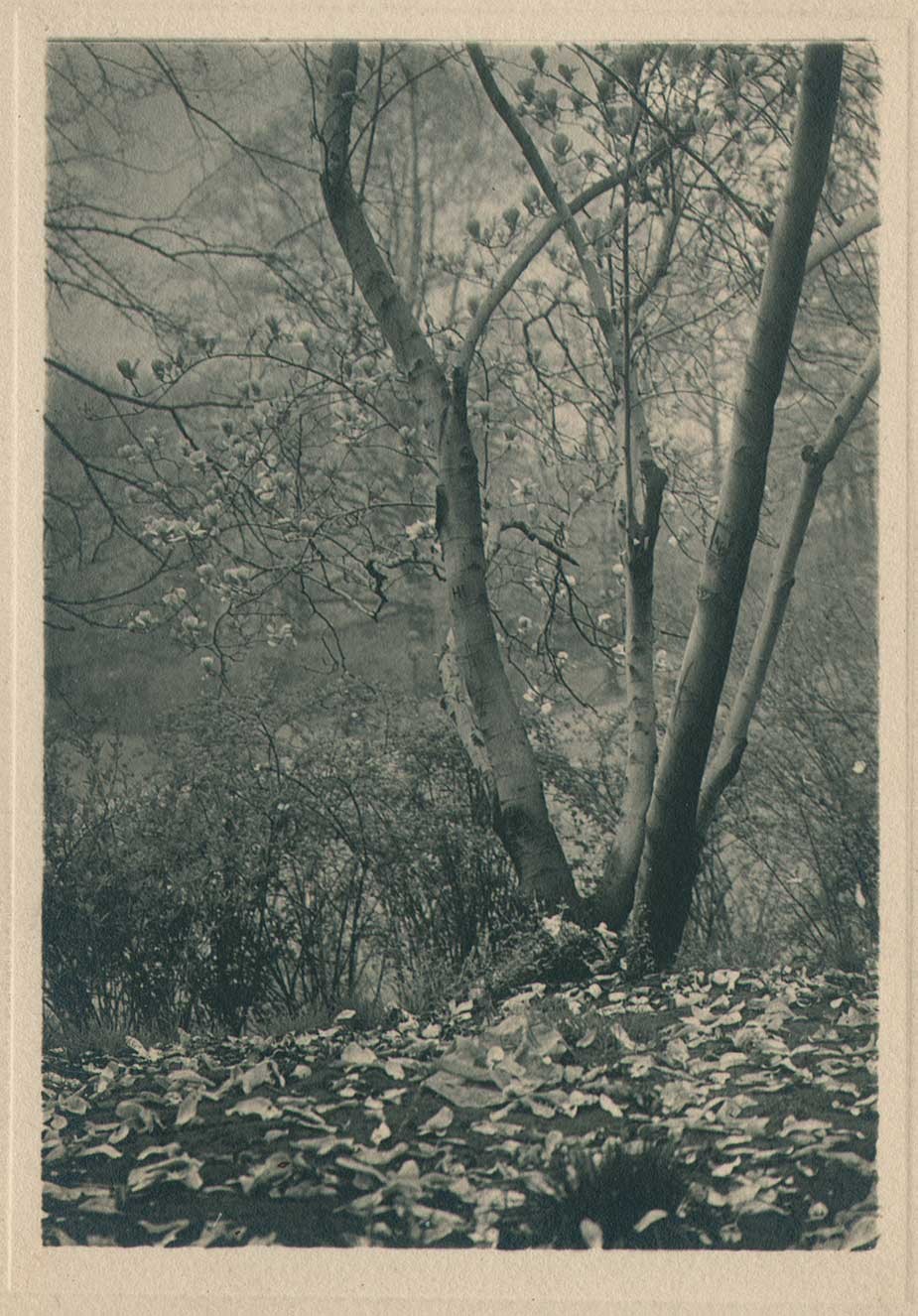 "Spring Vista with Fallen Leaves": by Unknown Brooklyn (photographer) : American: carbon?: ca. 1905-10: 11.9 x 8.2 | 17.8 x 12.1 cm: What are believed to be Magnolia tree blossoms litter the ground in the foreground of this spring landscape study featuring a blooming Magnolia in the background, with the setting believed to be Brooklyn's Prospect Park as many known examples of this location were taken by this photographer. This photograph, with title supplied by this archive, is by an Unknown Brooklyn amateur photographer whose surviving work was discovered in a trunk in the American South. Background can be found by searching for this site's 2015 blog post: "No Junk in Trunk". From: PhotoSeed Archive
"Spring Vista with Fallen Leaves": by Unknown Brooklyn (photographer) : American: carbon?: ca. 1905-10: 11.9 x 8.2 | 17.8 x 12.1 cm: What are believed to be Magnolia tree blossoms litter the ground in the foreground of this spring landscape study featuring a blooming Magnolia in the background, with the setting believed to be Brooklyn's Prospect Park as many known examples of this location were taken by this photographer. This photograph, with title supplied by this archive, is by an Unknown Brooklyn amateur photographer whose surviving work was discovered in a trunk in the American South. Background can be found by searching for this site's 2015 blog post: "No Junk in Trunk". From: PhotoSeed Archive
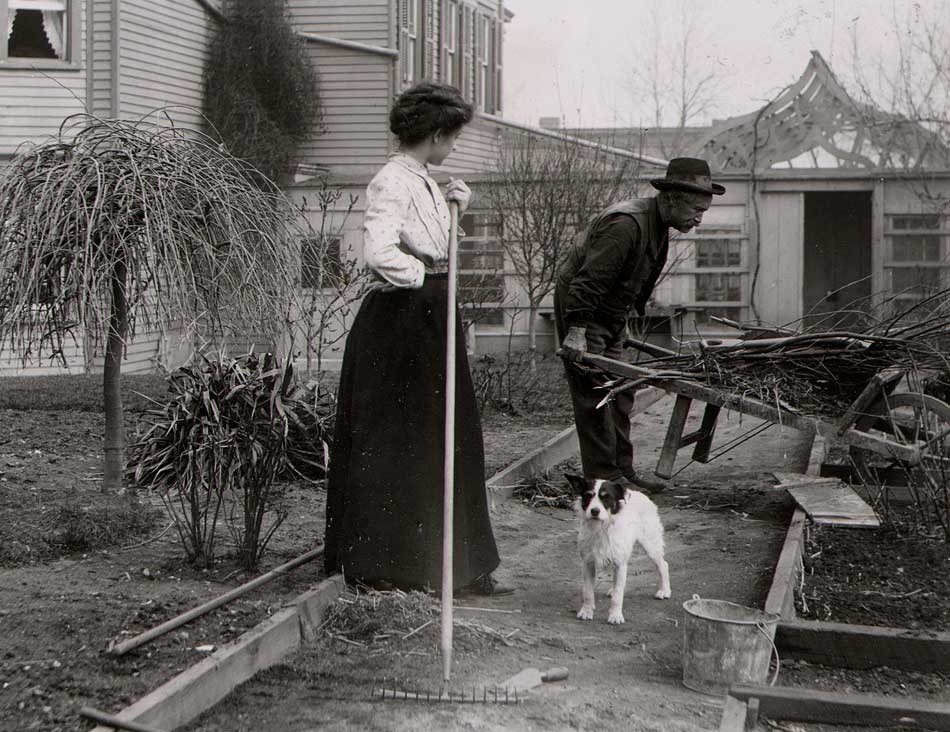 Detail: "Cleaning up the Yard in Spring": c. 1900-05 by Jeanette Bernard: American, born Germany: (1855-1941) gelatin silver print c. 1935-40 from original glass plate negative acquired by Culver Service : 15.4 x 13.9 cm: alternate title: "Woman and Man Gardening"-George Eastman House NEG: 40724: 83:2640:0025: A spring cleaning study in a garden shows the photographer's daughter with pet terrier dog at her feet watching as a gentleman (perhaps a hired man) prepares to move a collection of dead branches using a wheelbarrow. From: PhotoSeed Archive
Detail: "Cleaning up the Yard in Spring": c. 1900-05 by Jeanette Bernard: American, born Germany: (1855-1941) gelatin silver print c. 1935-40 from original glass plate negative acquired by Culver Service : 15.4 x 13.9 cm: alternate title: "Woman and Man Gardening"-George Eastman House NEG: 40724: 83:2640:0025: A spring cleaning study in a garden shows the photographer's daughter with pet terrier dog at her feet watching as a gentleman (perhaps a hired man) prepares to move a collection of dead branches using a wheelbarrow. From: PhotoSeed Archive
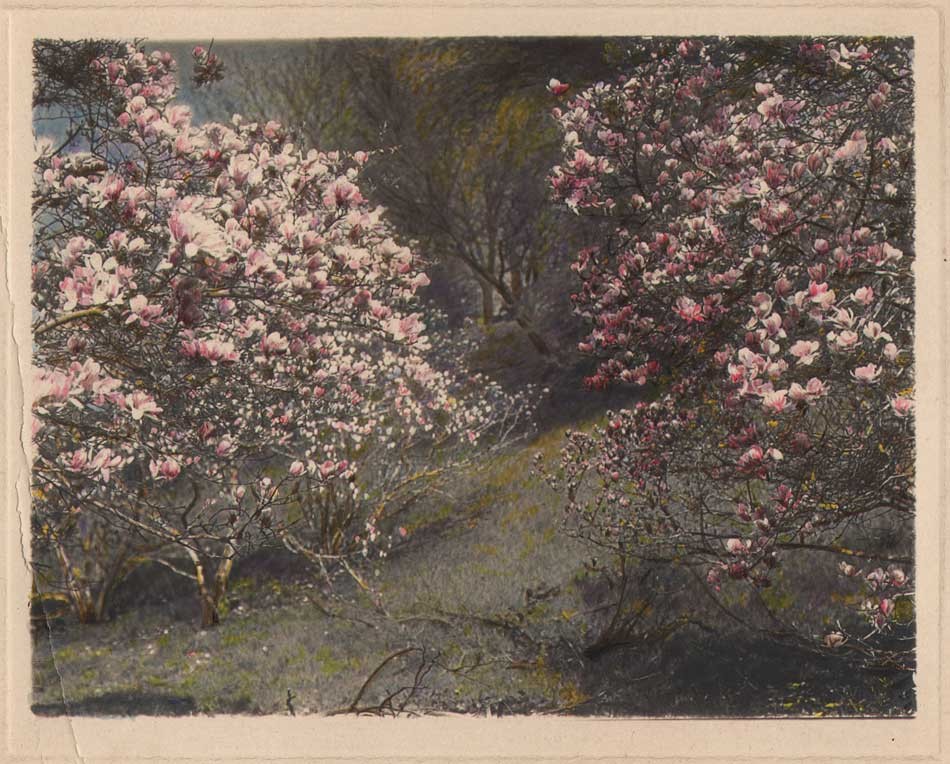 "Magnolia Trees Blooming in Spring": by Unknown Brooklyn (photographer) : American: gelatin silver (hand-colored) from copy print: ca. 1910-15: 9.0 x 11.6 | 12.4 x 16.4 cm: This hand-colored landscape study showing several blooming Magnolia trees is believed to have been taken at Brooklyn's Prospect Park as many known examples of this location were taken by this photographer. This photograph, with title supplied by this archive, is by an Unknown Brooklyn amateur photographer whose surviving work was discovered in a trunk in the American South. Background can be found by searching for this site's 2015 blog post: "No Junk in Trunk". From: PhotoSeed Archive
"Magnolia Trees Blooming in Spring": by Unknown Brooklyn (photographer) : American: gelatin silver (hand-colored) from copy print: ca. 1910-15: 9.0 x 11.6 | 12.4 x 16.4 cm: This hand-colored landscape study showing several blooming Magnolia trees is believed to have been taken at Brooklyn's Prospect Park as many known examples of this location were taken by this photographer. This photograph, with title supplied by this archive, is by an Unknown Brooklyn amateur photographer whose surviving work was discovered in a trunk in the American South. Background can be found by searching for this site's 2015 blog post: "No Junk in Trunk". From: PhotoSeed Archive
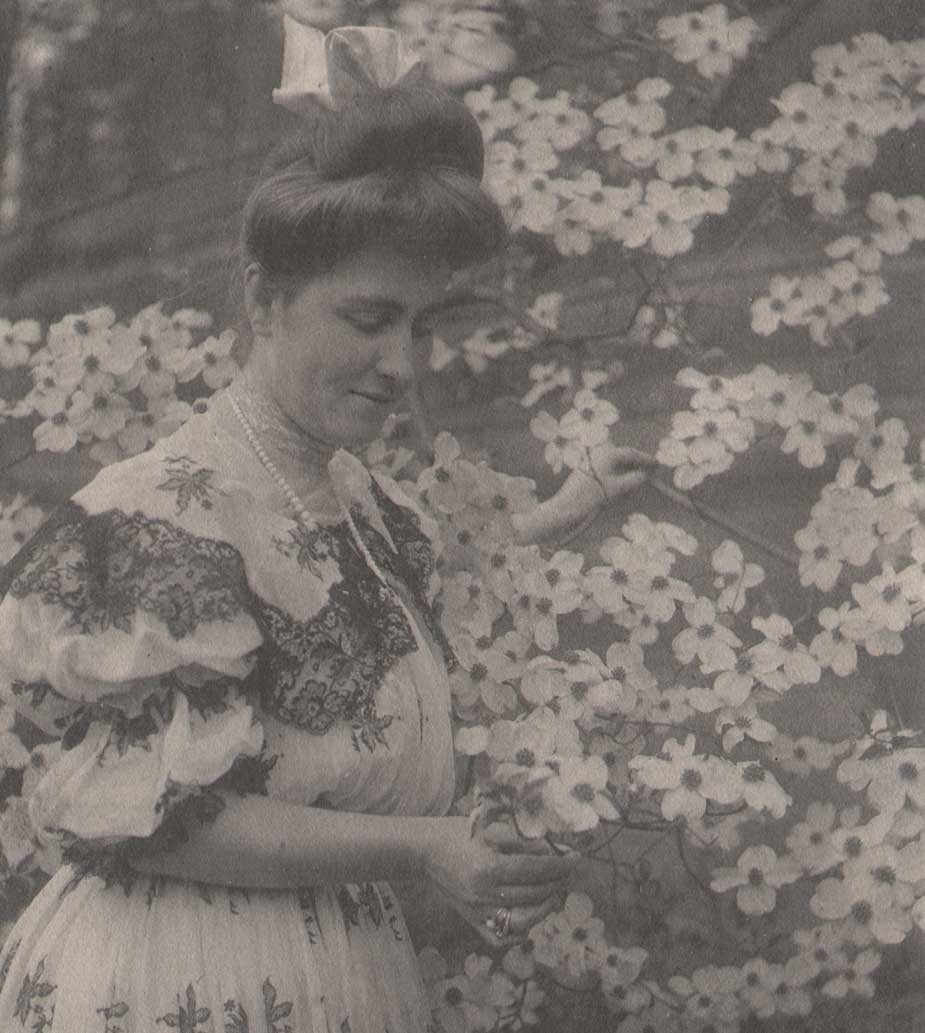 Detail: "Clare Shipman with Dogwood Blossoms": C.M. Shipman: American: platinum: 1904 or before: 17.5 x 11.8 cm | 27.9 x 36.0 cm tipped to black art-paper leaf from album: Born ca. 1880, Clare Cressey Shipman, spouse of amateur photographer Charles Melville Shipman, (1874-1947) examines a cluster of dogwood blossoms, most likely taken in the borough of Richmond on Staten Island, New York City, where the couple lived at the time. The photograph was included with other mostly naturalistic studies compiled in an album by the photographer with the final photograph signed and dated 1904. From: PhotoSeed Archive
Detail: "Clare Shipman with Dogwood Blossoms": C.M. Shipman: American: platinum: 1904 or before: 17.5 x 11.8 cm | 27.9 x 36.0 cm tipped to black art-paper leaf from album: Born ca. 1880, Clare Cressey Shipman, spouse of amateur photographer Charles Melville Shipman, (1874-1947) examines a cluster of dogwood blossoms, most likely taken in the borough of Richmond on Staten Island, New York City, where the couple lived at the time. The photograph was included with other mostly naturalistic studies compiled in an album by the photographer with the final photograph signed and dated 1904. From: PhotoSeed Archive
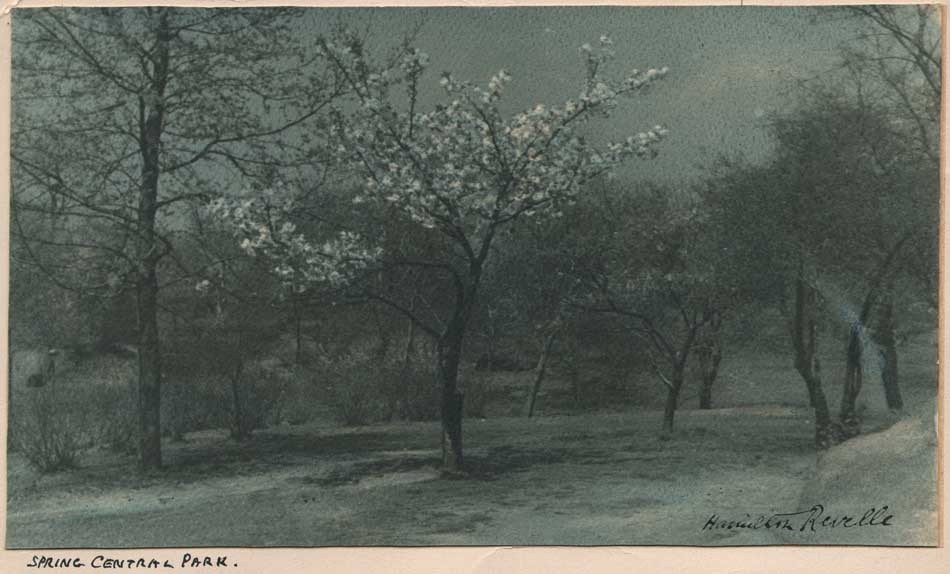 "Spring Central Park": Hamilton Revelle, (1872-1958) English, born Gibraltar: bromoil (hand-colored) ca. 1930-40: 10.2 x 18.5 | 14.3 x 22.4 cm: This delicate hand-colored, blue hued study of a blooming tree in springtime in New York City's Central Park was probably done in the early 1930's along with another landscape study shown with this post. A British born stage and screen actor and consummate amateur photography on the side, he later specialized in the bromoil-transfer process after mastering other processes. The Broadway Photographs website includes a short bio: "Revelle's intense interest in photography perhaps derived from the art's capacity to arrest beauty in timeless perfection. He began carrying his camera equipment with him everywhere and spent his days, before going to the theater in early evening, perfecting his technical mastery of the medium, in platinum, silver, and autochrome. He was an avid experimenter with various printing papers and popularized the print of works on parchment. His portraits were displayed in international salons regularly during the first decade of the 20th century. The Royal Photographic Society of London awarded him its gold medal for excellence in portraiture." From: PhotoSeed Archive
"Spring Central Park": Hamilton Revelle, (1872-1958) English, born Gibraltar: bromoil (hand-colored) ca. 1930-40: 10.2 x 18.5 | 14.3 x 22.4 cm: This delicate hand-colored, blue hued study of a blooming tree in springtime in New York City's Central Park was probably done in the early 1930's along with another landscape study shown with this post. A British born stage and screen actor and consummate amateur photography on the side, he later specialized in the bromoil-transfer process after mastering other processes. The Broadway Photographs website includes a short bio: "Revelle's intense interest in photography perhaps derived from the art's capacity to arrest beauty in timeless perfection. He began carrying his camera equipment with him everywhere and spent his days, before going to the theater in early evening, perfecting his technical mastery of the medium, in platinum, silver, and autochrome. He was an avid experimenter with various printing papers and popularized the print of works on parchment. His portraits were displayed in international salons regularly during the first decade of the 20th century. The Royal Photographic Society of London awarded him its gold medal for excellence in portraiture." From: PhotoSeed Archive
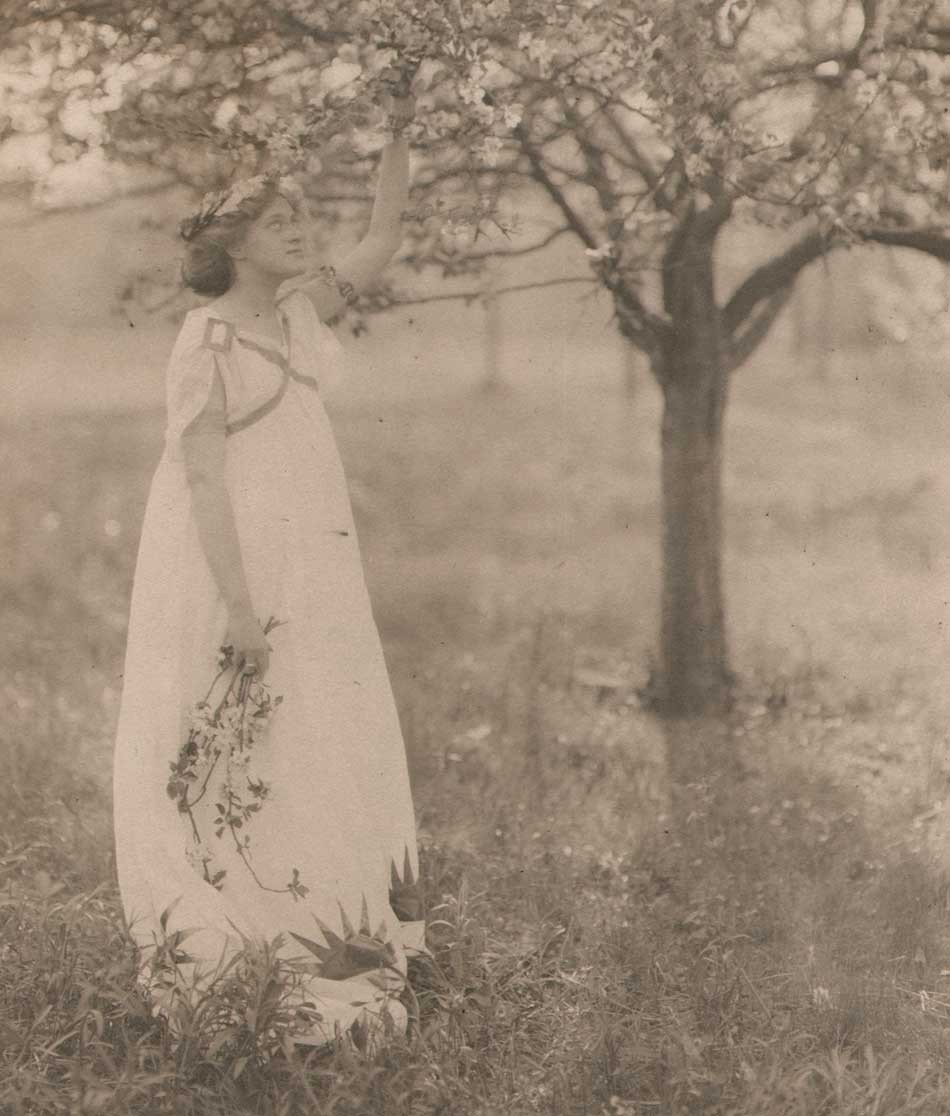 Detail: "Apple Blossoms": Charles Rollins Tucker: American: platinum: ca. 1905-10: 20.3 x 14.7 | 32.7 x 25.5 cm: A genre landscape study celebrating both spring and womanhood, (notice the sunbursts at the bottom of her dress) the model is perhaps a thespian who most likely attended Curtis High School on Staten Island in New York City, where photographer C.R. Tucker taught Physics at the time. From: PhotoSeed Archive
Detail: "Apple Blossoms": Charles Rollins Tucker: American: platinum: ca. 1905-10: 20.3 x 14.7 | 32.7 x 25.5 cm: A genre landscape study celebrating both spring and womanhood, (notice the sunbursts at the bottom of her dress) the model is perhaps a thespian who most likely attended Curtis High School on Staten Island in New York City, where photographer C.R. Tucker taught Physics at the time. From: PhotoSeed Archive
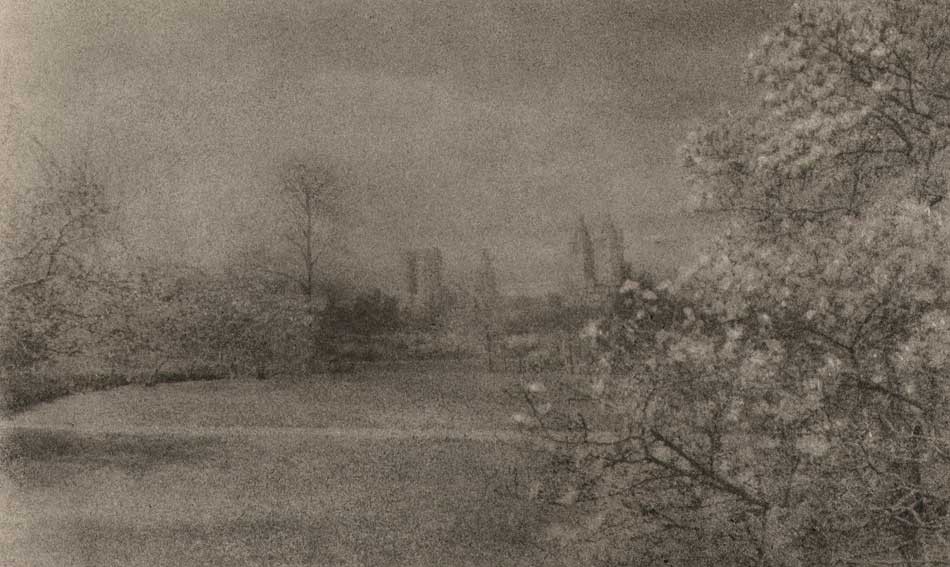 "Central Park Spring with Eldorado": Hamilton Revelle, (1872-1958) English, born Gibraltar: bromoil: ca. 1935-40: 11.5 x 18.5 | 17.6 x 27.8 cm: This bromoil landscape study taken in New York City's Central Park includes a few hints of the Manhattan skyline, including the luxury twin-spired Eldorado apartment building opened in 1931, seen just to the left of the blooming tree on the right side of frame. A British born stage and screen actor and consummate amateur photographer, Revelle later specialized in the bromoil-transfer process after mastering other photographic processes. From: PhotoSeed Archive
"Central Park Spring with Eldorado": Hamilton Revelle, (1872-1958) English, born Gibraltar: bromoil: ca. 1935-40: 11.5 x 18.5 | 17.6 x 27.8 cm: This bromoil landscape study taken in New York City's Central Park includes a few hints of the Manhattan skyline, including the luxury twin-spired Eldorado apartment building opened in 1931, seen just to the left of the blooming tree on the right side of frame. A British born stage and screen actor and consummate amateur photographer, Revelle later specialized in the bromoil-transfer process after mastering other photographic processes. From: PhotoSeed Archive
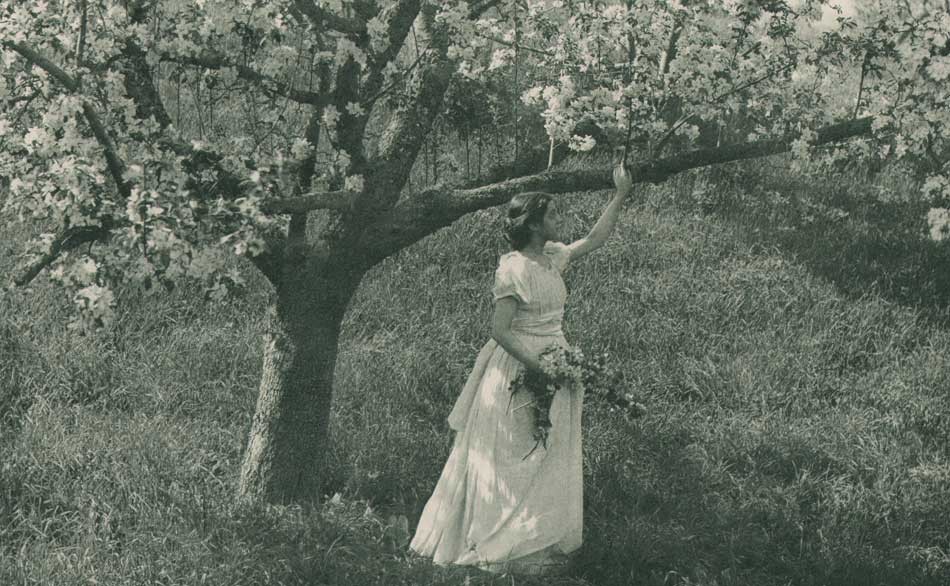 Detail: "Apple Blossoms": Emma Justine Farsworth, American: hand-pulled photogravure published in periodical "Sun & Shade" New York: June, 1893: whole #58: N.Y. Photogravure Co.: 17.0 x 21.7 cm | 27.5 x 34.7 cm: From: PhotoSeed Archive
Detail: "Apple Blossoms": Emma Justine Farsworth, American: hand-pulled photogravure published in periodical "Sun & Shade" New York: June, 1893: whole #58: N.Y. Photogravure Co.: 17.0 x 21.7 cm | 27.5 x 34.7 cm: From: PhotoSeed Archive
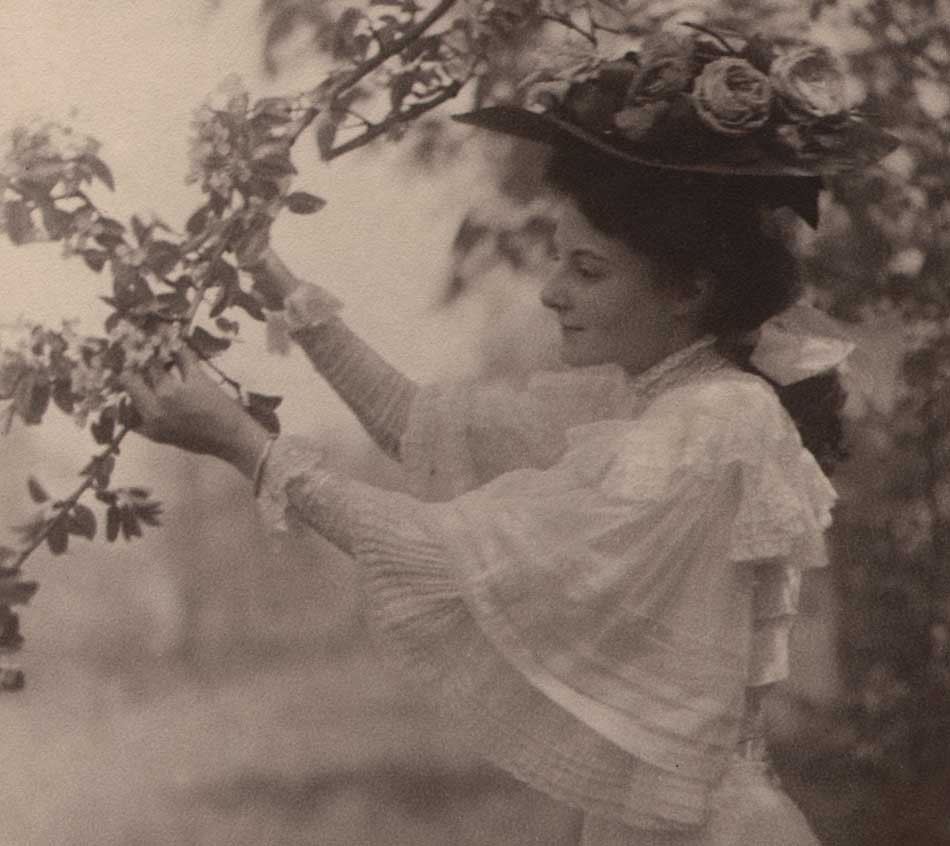 Detail: "Mary Tucker with Apple Blossoms": Charles Rollins Tucker: American: platinum: ca. 1905-10: 26.1 x 19.2 | 30.0 x 22.0 cm: Mary (Carruthers) Tucker, (1870-1940) spouse of amateur photographer C.R. Tucker, holds a bough of blossoms from an apple tree while wearing a hat adorned with flowers in this classic genre study celebrating womanhood in early spring. From: PhotoSeed Archive
Detail: "Mary Tucker with Apple Blossoms": Charles Rollins Tucker: American: platinum: ca. 1905-10: 26.1 x 19.2 | 30.0 x 22.0 cm: Mary (Carruthers) Tucker, (1870-1940) spouse of amateur photographer C.R. Tucker, holds a bough of blossoms from an apple tree while wearing a hat adorned with flowers in this classic genre study celebrating womanhood in early spring. From: PhotoSeed Archive
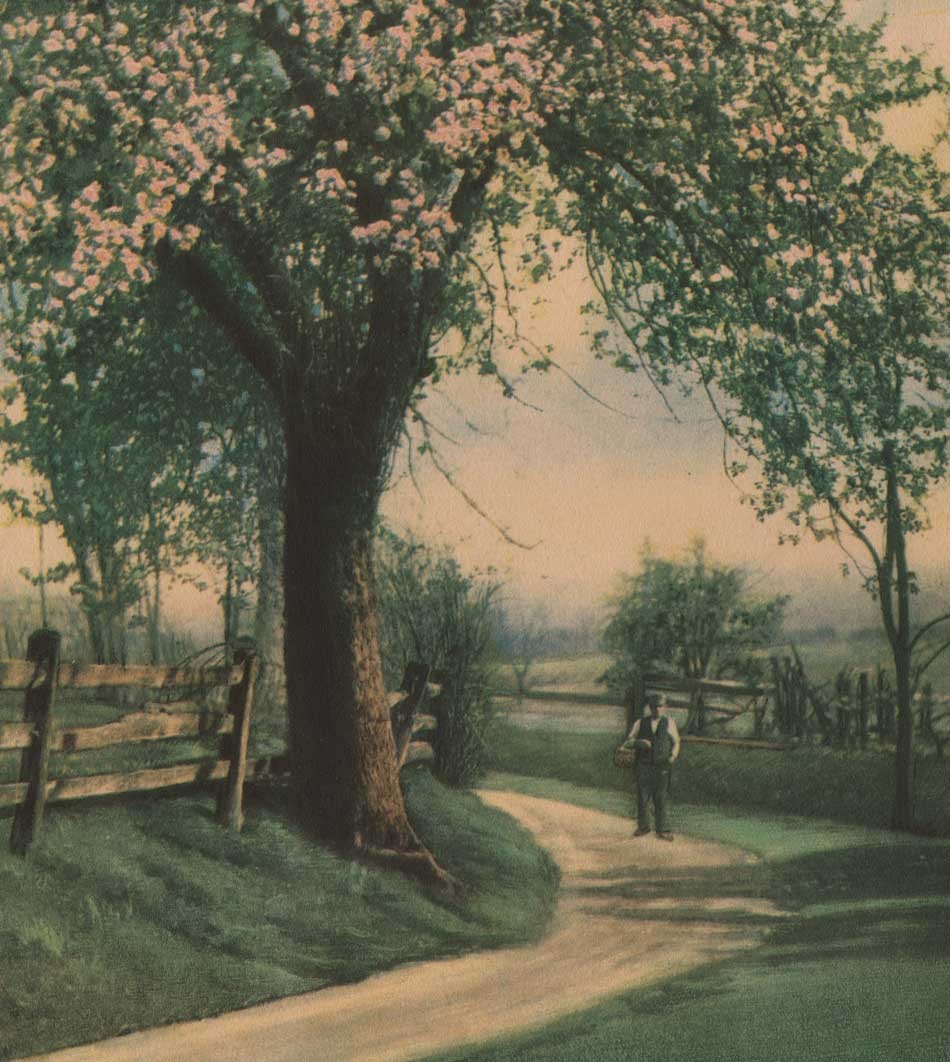 Detail: "In Apple Blossom Time": Henry Troth: American: lithograph, four-color: ca. 1915: 24.7 x 20.3: paperboard mount remnants with following additional details: Negative by Henry Troth; Artist Proof Fac-Simile; Published by the Henry Heininger Co NY.: This landscape study of a gentleman holding a basket in a roadway by Henry Troth shows a large flowering apple tree in the foreground. The Heininger firm, founded in 1885, marketed art reproductions and published postcards in addition to larger works like this. Metropostcard.com states this firm's "Fac-Simile Hand painted Nature Views were of course not hand colored but reproduced hand colored work in four color lithography through the use of paper grains. These cards also have a false plate mark." Another reference included in the publishing trade journal Geyer's Stationer from 1915 when this work is believed to have been produced stated: "The Heininger Co. are famed as well for their extensive line of artist proof facsimile nature pictures so perfectly executed that they readily pass for the high-priced hand-colored photoprints that command such generous prices on the market. The popular prices at which these art subjects are offered should command the instant attention of buyers, who already know the good value of their Abelart line, a complete display of which will be on view." Another Troth spring landscape, "The Hill Road" also appeared in 1915 produced by this firm. From: PhotoSeed Archive
Detail: "In Apple Blossom Time": Henry Troth: American: lithograph, four-color: ca. 1915: 24.7 x 20.3: paperboard mount remnants with following additional details: Negative by Henry Troth; Artist Proof Fac-Simile; Published by the Henry Heininger Co NY.: This landscape study of a gentleman holding a basket in a roadway by Henry Troth shows a large flowering apple tree in the foreground. The Heininger firm, founded in 1885, marketed art reproductions and published postcards in addition to larger works like this. Metropostcard.com states this firm's "Fac-Simile Hand painted Nature Views were of course not hand colored but reproduced hand colored work in four color lithography through the use of paper grains. These cards also have a false plate mark." Another reference included in the publishing trade journal Geyer's Stationer from 1915 when this work is believed to have been produced stated: "The Heininger Co. are famed as well for their extensive line of artist proof facsimile nature pictures so perfectly executed that they readily pass for the high-priced hand-colored photoprints that command such generous prices on the market. The popular prices at which these art subjects are offered should command the instant attention of buyers, who already know the good value of their Abelart line, a complete display of which will be on view." Another Troth spring landscape, "The Hill Road" also appeared in 1915 produced by this firm. From: PhotoSeed Archive
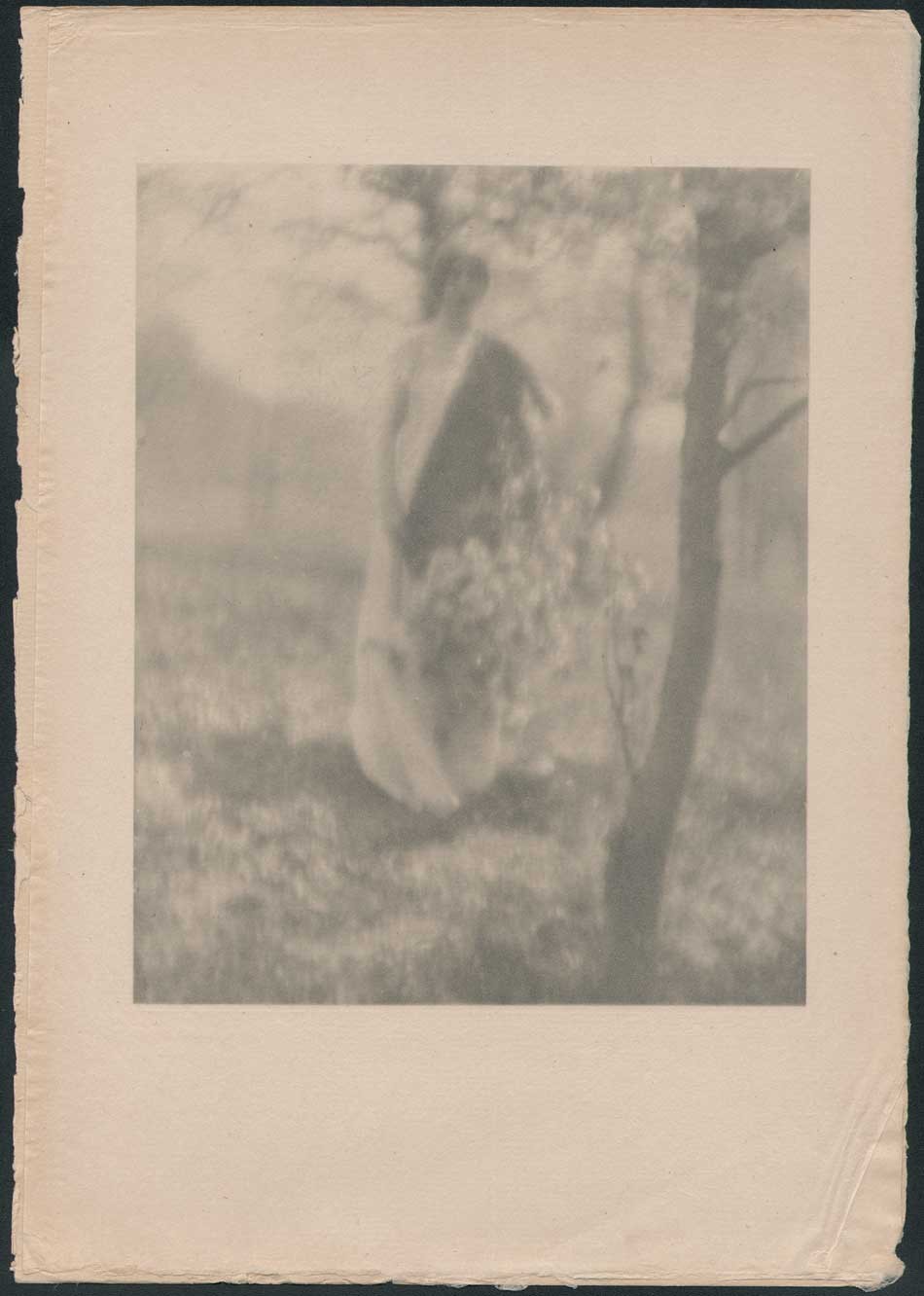 "Spring": George H. Seeley, American: hand-pulled Japan-paper tissue photogravure by the Manhattan Photogravure Co. included with Camera Work issue XXIX, January 1910: 19.7 x 15.8 | 29.7 x 20.6 cm | 30.0 x 21.0 cm- Enfield 1887 watermarked laid paper mount: A review in the February 25, 1910 issue of The British Journal of Photography discusses the ten photogravure plates by Seeley included with CW 29, and singles out this spring study with female model at the critique's conclusion: "Of the plates, the ten photogravures after photographs, by George H. Seeley, are remarkably rich examples of that idle sort of decorative toying with photography which “Camera Work" has always fostered. Mr. Seeley’s technical powers are very considerable. He is master enough to take great liberties with focussing, and does so with impunity; but the greatest enthusiast in art for art’s sake must admit that the subject-matter of Mr. Seeley's work is trivial and tiresome. "Girl with Bowl” is well designed and of exquisite quality. “Autumn" introduces a tambourine and bulrushes, with an inexplicable pose of the model. “The White Screen" shows the lady out of doors, dappled with the shadow from a tree. This is a charming study in tones. Next follow two subjects introducing an artist's palette—the first ridiculous and the next mystifying. Then comes a male nude of no attractions. “White Trees" and “Spring,” by their lightness and delicacy of tones, and the beauty of their suggestion, are, in our opinion, the best pictures of all. In the last two, the photographer’s title resources give out, and he contents himself with calling them No. 347 and No. 356. They do not suffer thereby. No. 356 is truly decorative, and shows us that Mr. Seeley has imbibed good ideas from the classics in painting."(p. 147: there is confusion as to the above numbers: a flysheet includes the pagination as plates VII (White Trees.) & VIII (Spring.): From: PhotoSeed Archive
"Spring": George H. Seeley, American: hand-pulled Japan-paper tissue photogravure by the Manhattan Photogravure Co. included with Camera Work issue XXIX, January 1910: 19.7 x 15.8 | 29.7 x 20.6 cm | 30.0 x 21.0 cm- Enfield 1887 watermarked laid paper mount: A review in the February 25, 1910 issue of The British Journal of Photography discusses the ten photogravure plates by Seeley included with CW 29, and singles out this spring study with female model at the critique's conclusion: "Of the plates, the ten photogravures after photographs, by George H. Seeley, are remarkably rich examples of that idle sort of decorative toying with photography which “Camera Work" has always fostered. Mr. Seeley’s technical powers are very considerable. He is master enough to take great liberties with focussing, and does so with impunity; but the greatest enthusiast in art for art’s sake must admit that the subject-matter of Mr. Seeley's work is trivial and tiresome. "Girl with Bowl” is well designed and of exquisite quality. “Autumn" introduces a tambourine and bulrushes, with an inexplicable pose of the model. “The White Screen" shows the lady out of doors, dappled with the shadow from a tree. This is a charming study in tones. Next follow two subjects introducing an artist's palette—the first ridiculous and the next mystifying. Then comes a male nude of no attractions. “White Trees" and “Spring,” by their lightness and delicacy of tones, and the beauty of their suggestion, are, in our opinion, the best pictures of all. In the last two, the photographer’s title resources give out, and he contents himself with calling them No. 347 and No. 356. They do not suffer thereby. No. 356 is truly decorative, and shows us that Mr. Seeley has imbibed good ideas from the classics in painting."(p. 147: there is confusion as to the above numbers: a flysheet includes the pagination as plates VII (White Trees.) & VIII (Spring.): From: PhotoSeed Archive
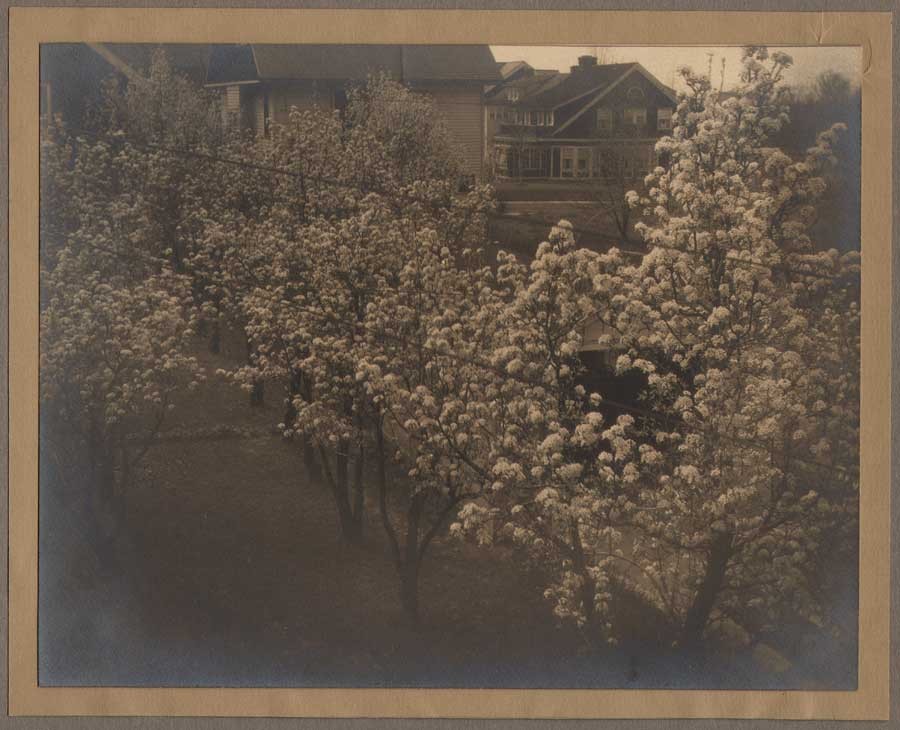 "Backyard Apple Trees Blossoming": Leo Kraft, (1885-1927) American: gelatin silver print, ca. 1915-20: 19.0 24.3 | 21.0 26.1 | 33.0 x 39.3 cm. This photograph most likely picture's the backyard area of the photographer's Lakewood, Ohio home outside Cleveland showing a double-line of flowering apple or crabapple trees. The print is believed to be printed on Kodak's P. M. C. Bromide (double weight) paper like other known examples by Kraft in this archive.: From: PhotoSeed Archive
"Backyard Apple Trees Blossoming": Leo Kraft, (1885-1927) American: gelatin silver print, ca. 1915-20: 19.0 24.3 | 21.0 26.1 | 33.0 x 39.3 cm. This photograph most likely picture's the backyard area of the photographer's Lakewood, Ohio home outside Cleveland showing a double-line of flowering apple or crabapple trees. The print is believed to be printed on Kodak's P. M. C. Bromide (double weight) paper like other known examples by Kraft in this archive.: From: PhotoSeed Archive
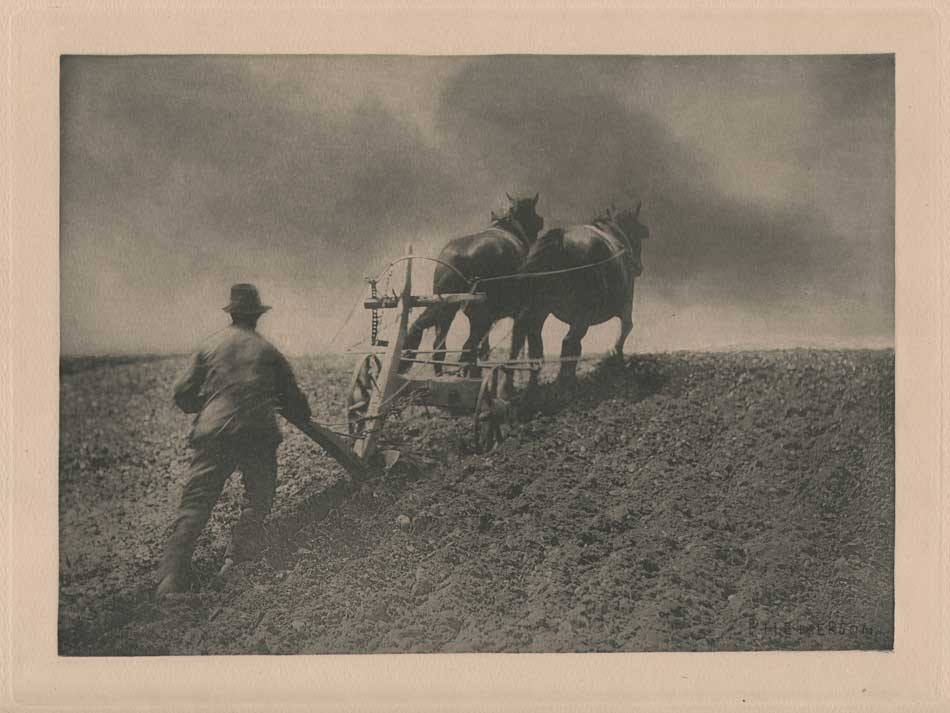 "A Stiff Pull": Peter Henry Emerson: British, born Cuba: hand-pulled photogravure by the photographer included in his limited, second-edition portfolio "Pictures of East Anglian Life": 1890: 20.7 x 28.8 | 34.1 x 42.6 cm: A farmer guides a plow behind a team of two horses as he tills the earth in the English spring countryside. England's Victoria & Albert Museum notes of this work included with this portfolio: "In 1889 Emerson published his controversial book 'Naturalistic Photography for Students of the Art' without images. 'Naturalistic Photography' examined his purist approach to photography, derived from his fascination with Naturalism in art, and attacked the prevailing artificial aesthetic in art photography. After its publication Emerson felt that his opponents had misunderstood his ideas. So, in 1890 he selected 10 plates from his book 'Pictures of East Anglian Life' (1888) that best illustrated his theories, and presented them loose in a portfolio dedicated to the ‘photographic student’, with the same title and cover of the book. He then donated copies of this portfolio to every photographic society in the country." Included in the work as plate III, "A Stiff Pull" is also reproduced as a line engraving on the oversized canvas board folio, but with the odd inclusion of the ocean with sailboats and gulls flying overhead on the horizon. From: PhotoSeed Archive
"A Stiff Pull": Peter Henry Emerson: British, born Cuba: hand-pulled photogravure by the photographer included in his limited, second-edition portfolio "Pictures of East Anglian Life": 1890: 20.7 x 28.8 | 34.1 x 42.6 cm: A farmer guides a plow behind a team of two horses as he tills the earth in the English spring countryside. England's Victoria & Albert Museum notes of this work included with this portfolio: "In 1889 Emerson published his controversial book 'Naturalistic Photography for Students of the Art' without images. 'Naturalistic Photography' examined his purist approach to photography, derived from his fascination with Naturalism in art, and attacked the prevailing artificial aesthetic in art photography. After its publication Emerson felt that his opponents had misunderstood his ideas. So, in 1890 he selected 10 plates from his book 'Pictures of East Anglian Life' (1888) that best illustrated his theories, and presented them loose in a portfolio dedicated to the ‘photographic student’, with the same title and cover of the book. He then donated copies of this portfolio to every photographic society in the country." Included in the work as plate III, "A Stiff Pull" is also reproduced as a line engraving on the oversized canvas board folio, but with the odd inclusion of the ocean with sailboats and gulls flying overhead on the horizon. From: PhotoSeed Archive
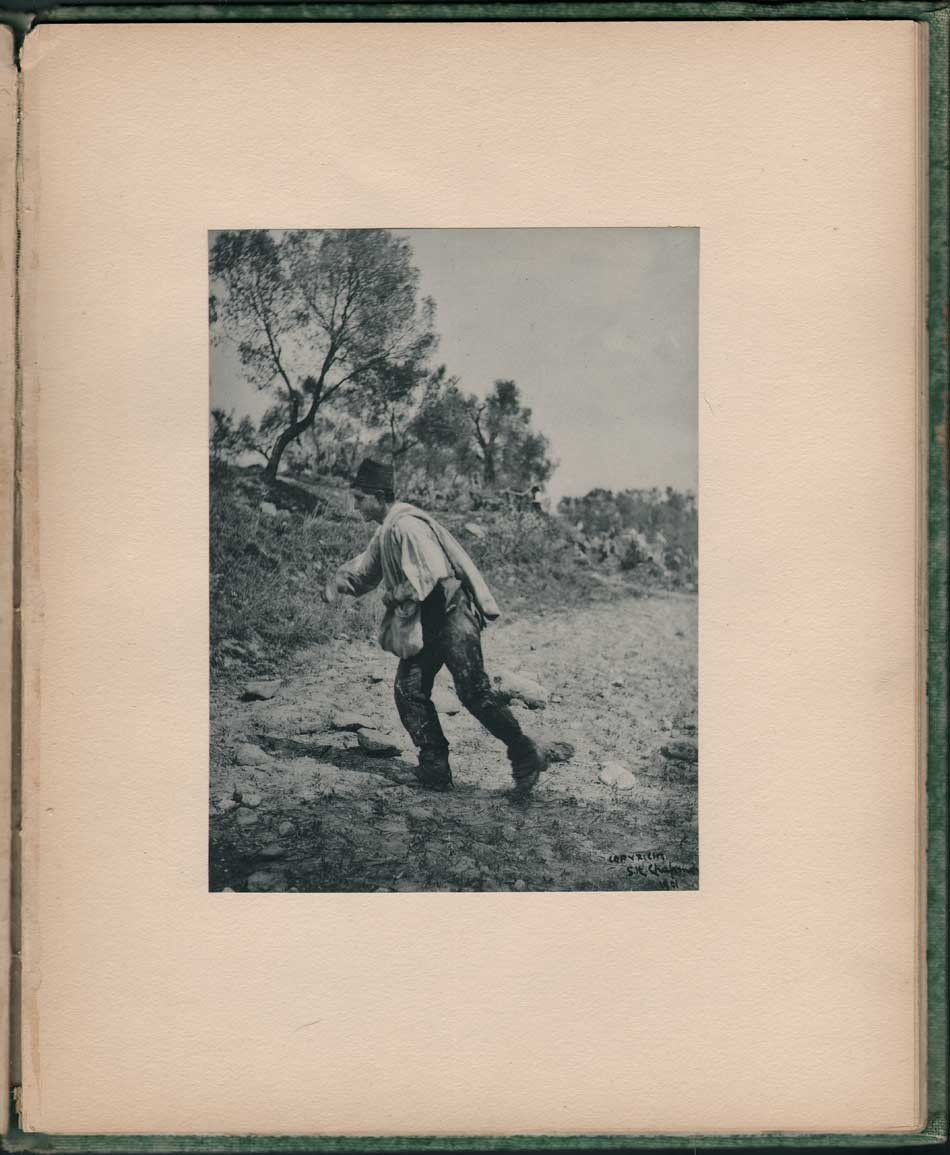 "Some fell upon Stony Places,…": Samuel Hudson Chapman, American (1857-1931): platinum print included in his self-published volume: "The Parable of the Sower, Illustrated From Life, With The Series of Pictures Awarded The Allison Silver Cup of the Photographic Society of Philadelphia For the Year 1900: S.H. & H. Chapman 1348 Pine Street, 1901: 18.8 x 13.9 corner-glued | 31.5 x 25.4 cm: A dealer in rare coins along with his brother Henry, Philadelphia resident Samuel Hudson Chapman was also an accomplished photographer and president of the Photographic Society of Philadelphia at the time he published this volume which included this photograph in 1901. Showing a farmhand sowing seeds in the springtime, most likely done in the Italian countryside, the following copy accompanies the work opposite, from the King James Version of the Bible's Book of Matthew: "Some fell upon Stony Places, where they had not much earth: and forthwith they sprung up, because they had no deepness of earth; and when the sun was up, they were scorched; and because they had no root, they withered away." From: PhotoSeed Archive
"Some fell upon Stony Places,…": Samuel Hudson Chapman, American (1857-1931): platinum print included in his self-published volume: "The Parable of the Sower, Illustrated From Life, With The Series of Pictures Awarded The Allison Silver Cup of the Photographic Society of Philadelphia For the Year 1900: S.H. & H. Chapman 1348 Pine Street, 1901: 18.8 x 13.9 corner-glued | 31.5 x 25.4 cm: A dealer in rare coins along with his brother Henry, Philadelphia resident Samuel Hudson Chapman was also an accomplished photographer and president of the Photographic Society of Philadelphia at the time he published this volume which included this photograph in 1901. Showing a farmhand sowing seeds in the springtime, most likely done in the Italian countryside, the following copy accompanies the work opposite, from the King James Version of the Bible's Book of Matthew: "Some fell upon Stony Places, where they had not much earth: and forthwith they sprung up, because they had no deepness of earth; and when the sun was up, they were scorched; and because they had no root, they withered away." From: PhotoSeed Archive
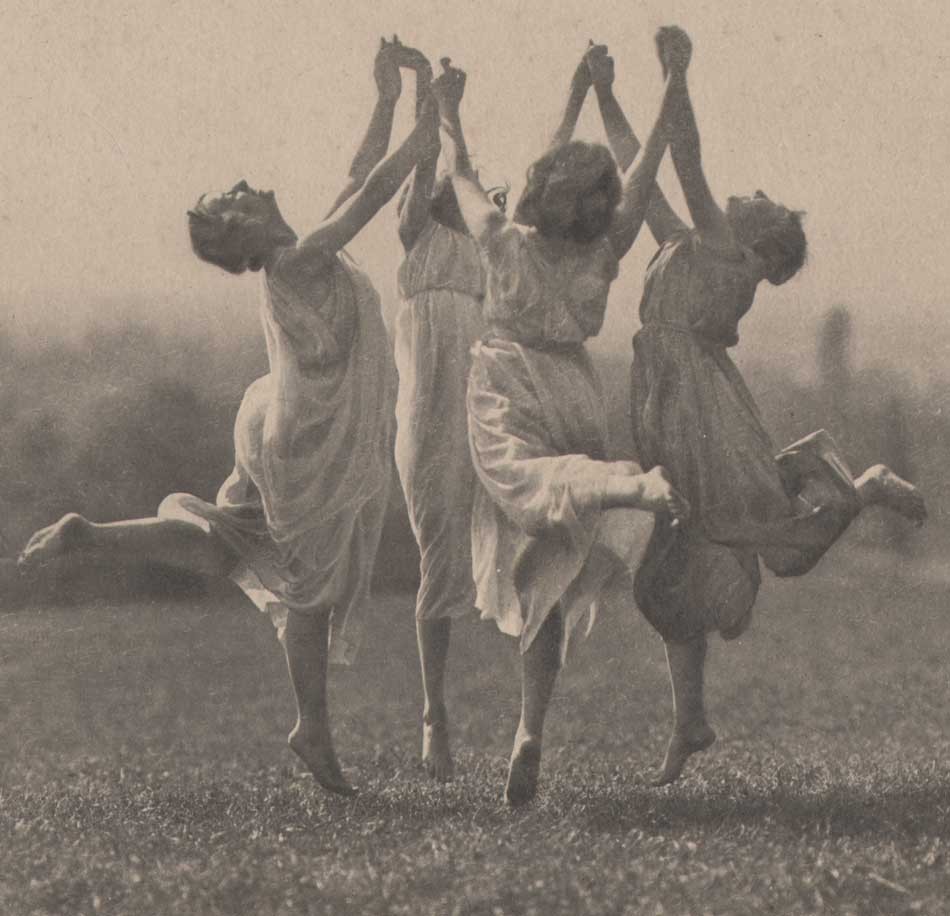 Detail: "Vers L'Idéal, Jeunes Filles Dansant : "Towards the Ideal, Young Girls Dancing" : Frederick Boissonnas, Swiss (1858-1946): hand-pulled photogravure by Munich's Verlagsanstalt F. Bruckmann A.-G. : 1911: 21.2 x 29.2 | 26.3 x 36.6 cm: Suggestive of an exuberant ritual acknowledging rebirth in spring, this photographic study of four female dancers can be dated to around 1911, when it was titled Vers L'Ideal "Towards the Ideal" and exhibited as part of the London Salon of Photography, where it was shown cropped to the central figures. These dancers were students attending a school teaching the "Dalcroze Method" of music pedagogy in Hellerau, Germany, now part of Dresden. The school was founded in 1910 by the Swiss composer, musician and music educator Émile Jaques-Dalcroze. (1865-1950) From: PhotoSeed Archive
Detail: "Vers L'Idéal, Jeunes Filles Dansant : "Towards the Ideal, Young Girls Dancing" : Frederick Boissonnas, Swiss (1858-1946): hand-pulled photogravure by Munich's Verlagsanstalt F. Bruckmann A.-G. : 1911: 21.2 x 29.2 | 26.3 x 36.6 cm: Suggestive of an exuberant ritual acknowledging rebirth in spring, this photographic study of four female dancers can be dated to around 1911, when it was titled Vers L'Ideal "Towards the Ideal" and exhibited as part of the London Salon of Photography, where it was shown cropped to the central figures. These dancers were students attending a school teaching the "Dalcroze Method" of music pedagogy in Hellerau, Germany, now part of Dresden. The school was founded in 1910 by the Swiss composer, musician and music educator Émile Jaques-Dalcroze. (1865-1950) From: PhotoSeed Archive
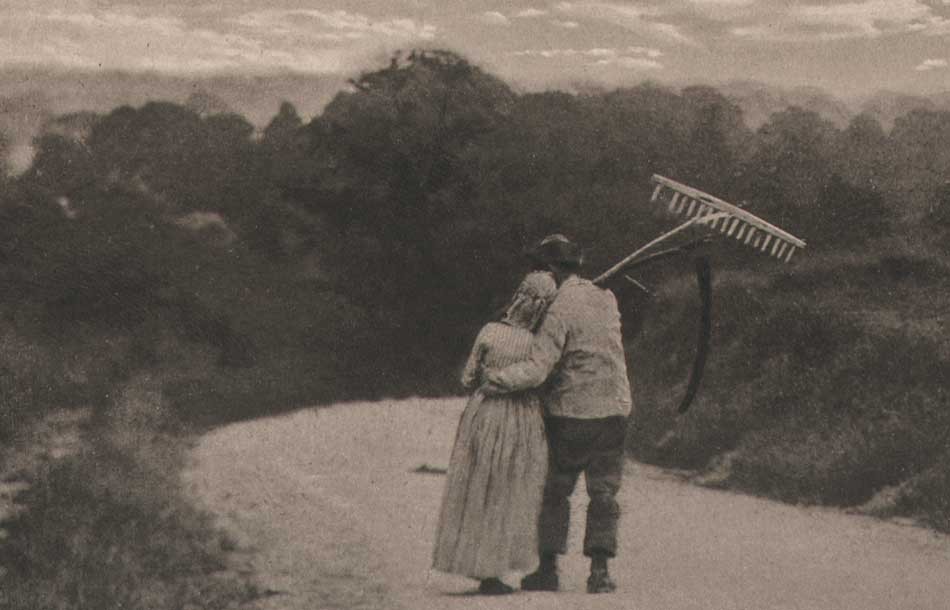 Detail: "Sweet Springtime" : Ralph Winwood-Robinson, English (1862-1942): hand-pulled, Chine-collé edition photogravure from limited-edition portfolio "Amateur-Kunst: 37 Photogravuren Nach Naturaufnahmen" (Amateur Art: 37 photo Engravings after nature Photographs) published by Richard Paulussen at Vienna's Gesellschaft für Vervielfältigende Kunst: 1891: 20.6 x 26.8 | 35.6 x 48.2 cm: Titled "Sweet Springtime", this romantic landscape genre study showing a couple walking together (please see this website for uncropped version) down a road past a windmill was taken by the son of renowned English photographer Henry Peach Robinson. It was exhibited in Vienna during the groundbreaking 1891 "Internationale Ausstellung Künstlerischer Photographien" (International Exhibition of Art Photographers) organized by the Club of Amateur Photographers in Austria (Club der Amateur Photographen in Wien) the same year.: From: PhotoSeed Archive
Detail: "Sweet Springtime" : Ralph Winwood-Robinson, English (1862-1942): hand-pulled, Chine-collé edition photogravure from limited-edition portfolio "Amateur-Kunst: 37 Photogravuren Nach Naturaufnahmen" (Amateur Art: 37 photo Engravings after nature Photographs) published by Richard Paulussen at Vienna's Gesellschaft für Vervielfältigende Kunst: 1891: 20.6 x 26.8 | 35.6 x 48.2 cm: Titled "Sweet Springtime", this romantic landscape genre study showing a couple walking together (please see this website for uncropped version) down a road past a windmill was taken by the son of renowned English photographer Henry Peach Robinson. It was exhibited in Vienna during the groundbreaking 1891 "Internationale Ausstellung Künstlerischer Photographien" (International Exhibition of Art Photographers) organized by the Club of Amateur Photographers in Austria (Club der Amateur Photographen in Wien) the same year.: From: PhotoSeed Archive
California Pipe Dreamer
Posted January 2016 in Alternate Processes, History of Photography, Journals, New Additions, Publishing, Texts
Sigismund Blumann, (1872-1956) an American who became an important editor and photographer after moving to San Francisco, California from New York City in the early 1880’s is our subject for this post, along with his involvement with and history of Camera Craft magazine. Never heard of him? A few relevant but by no means comprehensive list of details about this gentleman whose friends addressed him as “Sig” for short:
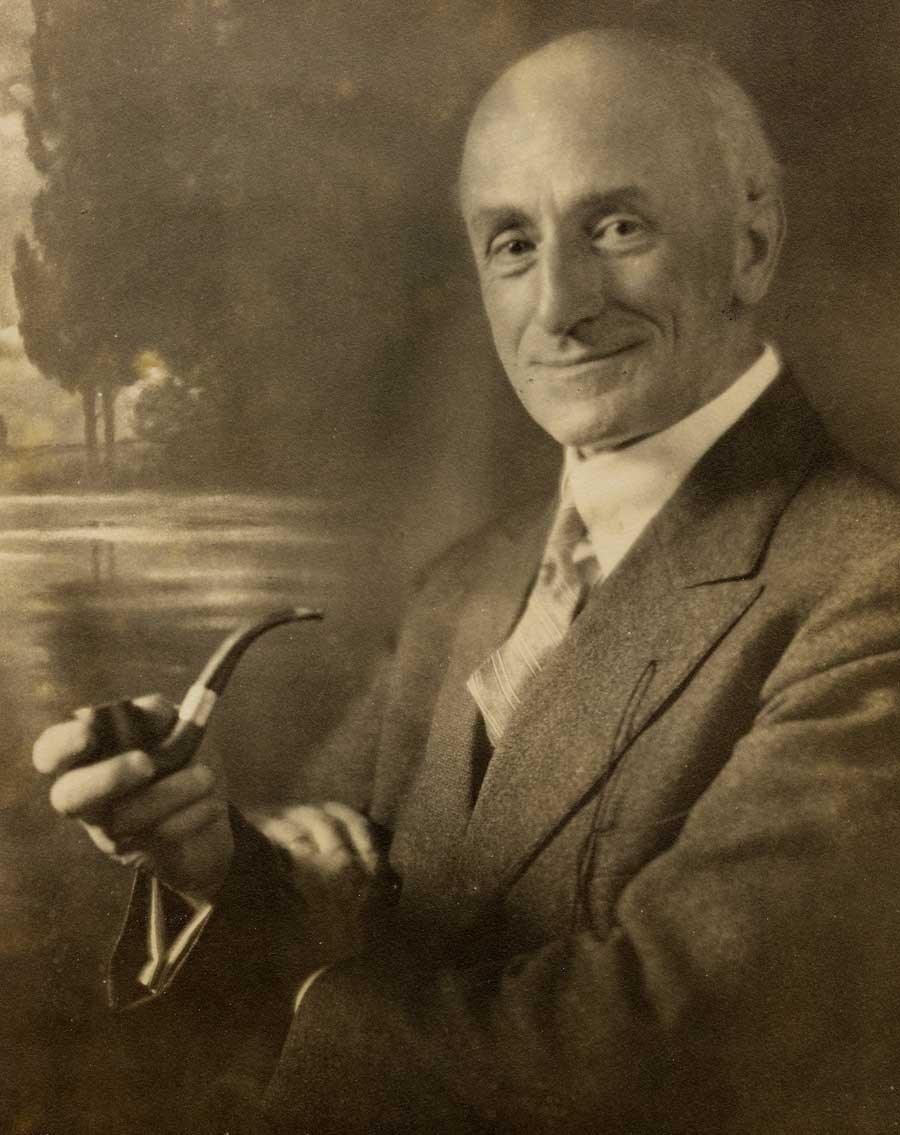 Detail: "Self-Portrait of Sigismund Blumann" (1872-1956) : American: gelatin silver print ca. 1930: Blumann was editor-in-chief of San Francisco-based Camera Craft magazine from 1924-1933: Photograph courtesy Thomas High
Detail: "Self-Portrait of Sigismund Blumann" (1872-1956) : American: gelatin silver print ca. 1930: Blumann was editor-in-chief of San Francisco-based Camera Craft magazine from 1924-1933: Photograph courtesy Thomas High
⌘ West Coast champion for photography in his role as Editor-in-Chief of Camera Craft magazine from 1924-1933. Prolific writer for said journal whose love of language sometimes lead to his mangling of it, but only with the best of intentions.
⌘ Significant pictorialist photographer from the same period and earlier whose darkroom work was equally inventive and important.
⌘ Poet.
⌘ So gregarious in affect, photographic historian Christian A. Peterson duly notes, (1.) that as editor, he personally answered all correspondence sent to him by his 8000 monthly Camera Craft readers in addition to his regular duties of penning multiple articles for each issue.
⌘ Possession of a sly sense of humor: look no further than a ca. 1930 self-portrait in which his suit lapel sprouts a long cable release rather than a floral boutonnière.
⌘ Conservative writer in print who often took a while to accept new ideas: as one example, Peterson notes his use of the made-up word “Sewereelism” included in a 1938 editorial written by him on his feelings towards the failings of the art movements Surrealism and Dada for the magazine Photo Art Monthly, a publication he owned himself. (2.)
⌘ Pipe smoker extraordinaire. Featured not only in the above referenced self-portrait but immortalized by artist W.R. Potter in print every month as artistic caricature shown smoking and reading a book used for his Under the Editor’s Lamp column in Camera Craft beginning in April 1926.
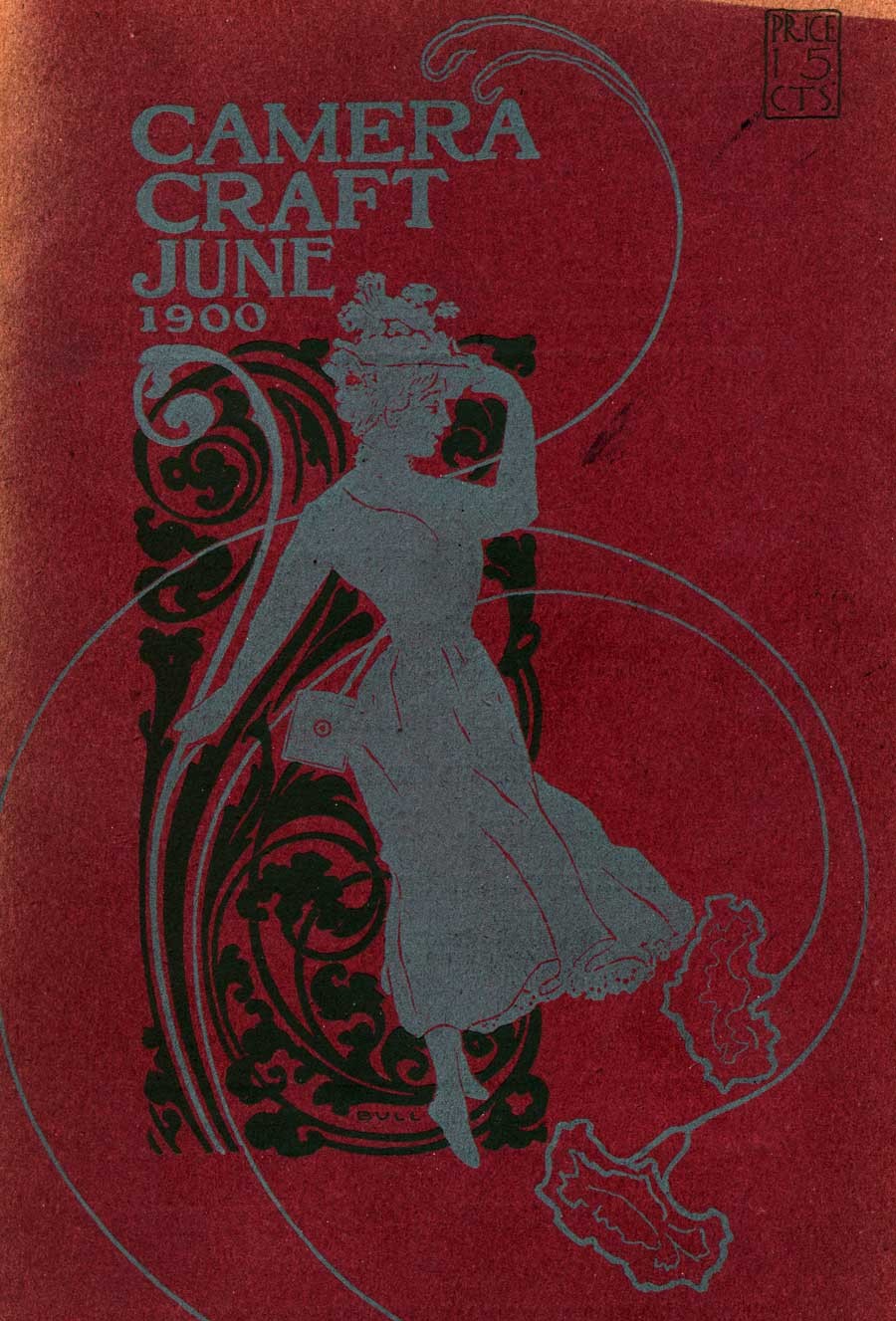 Detail: Cover Design: Camera Craft magazine: June, 1900: William Howell Bull: 1851-1940: American-California: 26.0 x 17.5 cm: two-color wood engraving : Sunset Press & Photo Engraving Company - San Francisco: cover price at upper right corner 15¢. Although this was the second issue of the magazine to appear, the first issue for May used the same cover design showing this stylish woman done in the Art-Nouveau style with small box camera slung on her side. From: PhotoSeed Archive
Detail: Cover Design: Camera Craft magazine: June, 1900: William Howell Bull: 1851-1940: American-California: 26.0 x 17.5 cm: two-color wood engraving : Sunset Press & Photo Engraving Company - San Francisco: cover price at upper right corner 15¢. Although this was the second issue of the magazine to appear, the first issue for May used the same cover design showing this stylish woman done in the Art-Nouveau style with small box camera slung on her side. From: PhotoSeed Archive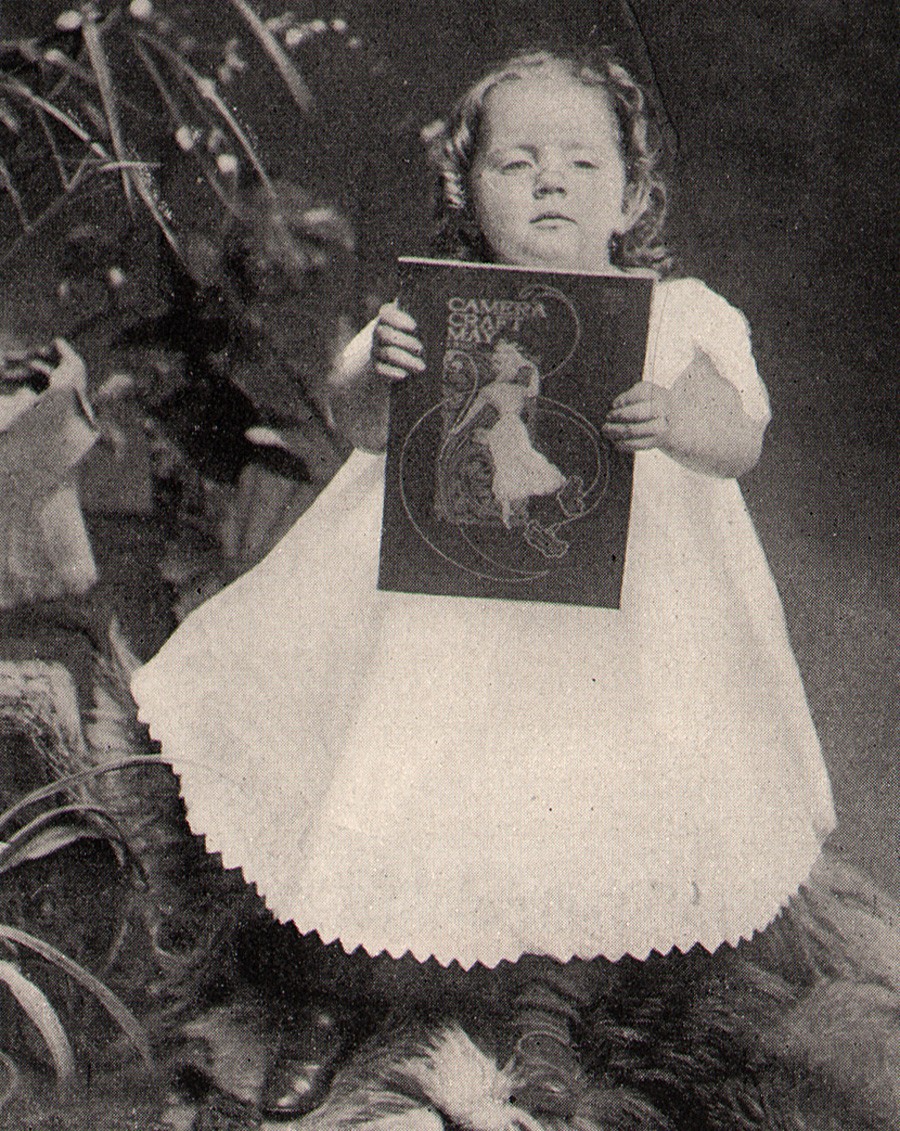 Detail: "Everyone Reads It": Mrs. C.S. Smith, American: Marysville (CA): halftone from June, 1900 Camera Craft magazine p. 57: 10.6 x 8.1 cm: A young girl holds up the very first issue of Camera Craft dated May, 1900. The design by California artist W.H. Bull was also used as the cover for June, 1900. From: PhotoSeed Archive
Detail: "Everyone Reads It": Mrs. C.S. Smith, American: Marysville (CA): halftone from June, 1900 Camera Craft magazine p. 57: 10.6 x 8.1 cm: A young girl holds up the very first issue of Camera Craft dated May, 1900. The design by California artist W.H. Bull was also used as the cover for June, 1900. From: PhotoSeed Archive
Sigismund Blumann: Short Biography
For the past three years, I’ve had the distinct pleasure of corresponding with Thomas High, Sigismund Blumann’s grandson, and been equally fortunate in acquiring a small archive of Sig’s vintage work for PhotoSeed previously kept in the family. Unlike Sig’s friends, Tom tells me, as a boy of perhaps five or six, he would of course address him as Grampa Blumann. Tom goes on to say:
”I only wish I had known him better – he died when I was a child, and my only real memories of him were playing rummy and whist with him.”
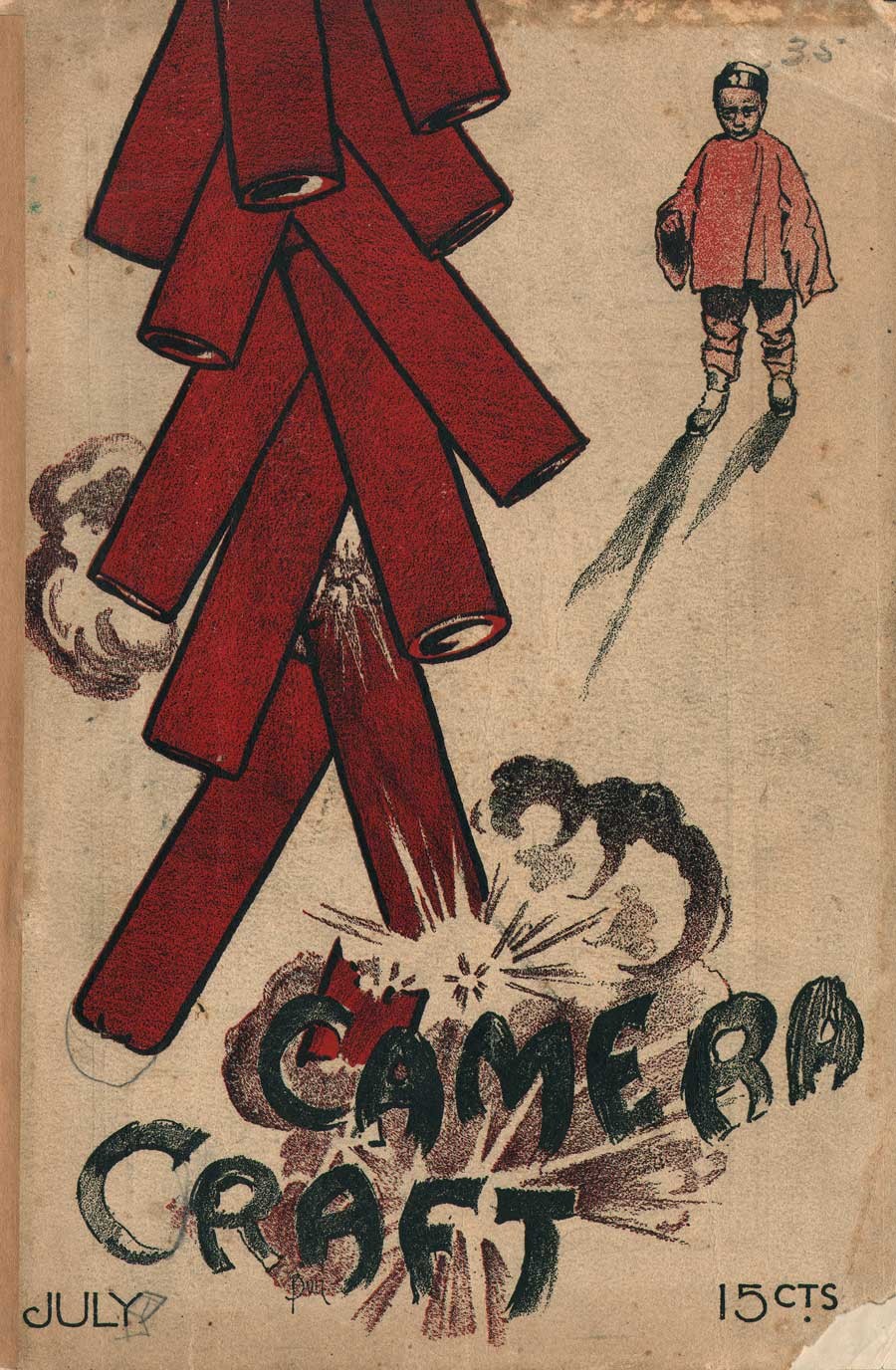 Cover Design: Chinese Firecrackers: Camera Craft magazine: July, 1900: William Howell Bull: 1851-1940: American-California: 26.0 x 17.5 cm: two-color wood engraving : Sunset Press & Photo Engraving Company - San Francisco: cover price at lower right corner 15¢. From: PhotoSeed Archive
Cover Design: Chinese Firecrackers: Camera Craft magazine: July, 1900: William Howell Bull: 1851-1940: American-California: 26.0 x 17.5 cm: two-color wood engraving : Sunset Press & Photo Engraving Company - San Francisco: cover price at lower right corner 15¢. From: PhotoSeed ArchiveTom has also agreed to let me reprint for purposes of introduction the following short biography of his grandfather written in October, 2009, for which I’m very grateful.
Sigismund Blumann (1872-1956) by Thomas High
Sigismund Blumann was born on September 13, 1872, in New York City, the son of Alexander Blumann and Rosalie (Price) Blumann. He came to San Francisco with his parents in late 1881 or 1882, and subsequently became a professional pianist and music teacher.
Sigismund Blumann married first on August 30, 1894, to Adele Morgenstern. They divorced in May of 1895. He married second on June 4, 1901, to Hilda Axelina Johansson and they subsequently had four daughters, Ethel, Amy, Lorna, and Vera.
In the 1890s, Sigismund Blumann became interested in photography and had begun taking photos seriously by 1900 while living in San Francisco. At the time of the San Francisco earthquake on April 9, 1906, he and his wife were still living with his parents on Army Street. He volunteered to help the recovery and, with his official permits, got through the lines and took a number of photographs.
Mr. Blumann was also a prolific writer and he authored numerous articles, commentaries, and poems.
After the 1906 earthquake, the Blumanns moved to Davis Street in Fruitvale (later part of Oakland). From that time, all of his photographic work was done in his darkroom at the Davis Street home.
Photography increased in importance in his life, and at the 1915 Panama-Pacific International Exposition he combined all of his talents: he played in an orchestra, photographed the Fair, and worked as a correspondent for the New York Tribune and other newspapers.
In the early 1920s, Sigismund retired from an active career in music and entered the profession of efficiency engineering, with offices in the Monadnock Building in San Francisco. His principal client was the Forster Music Publishing Company.
He continued his interest in photography and in 1924 he became editor of Camera Craft magazine. In addition to editing the publication and writing numerous articles for it, he also wrote the Photographic Workroom Handbook, published by Camera Craft in 1927.
Mr. Blumann’s last issue as editor of Camera Craft was in August of 1933. Several months later, he launched his own magazine, Photo Art Monthly, which he edited and published until 1940. During this period, he also produced several more manuals for amateur photographers, including the Photographic Handbook, Photographic Greetings - How to Make Them, Enlarging Manual, and Toning Processes.
In 1940, he sold the Photo Art Monthly to his assistant, Franke Unger (who married photographer Adolf Fassbender about the same time). She soon closed the magazine.
The Blumanns continued to live at their Davis Street home for the rest of their lives, joined by their unmarried daughters, Ethel and Lorna Blumann, both librarians. He produced little photographic work in the 1940s and 1950s, contenting himself to dabble in photography and discuss it with his new son-in-law, William A. High, who married his daughter, Vera, in February of 1943. Bill High was a commercial photographer before World War II, a combat photographer for the US Army during the war, and the founder of the photography department at Oakland’s Laney Trade School (later Peralta Junior College) thereafter.
Sigismund Blumann died in Oakland on July 9, 1956, and Hilda Blumann died on February 1, 1958, also in Oakland.
Sigismund Blumann’s photos are in the Oakland Museum, Minneapolis Institute of Art, High Museum in Atlanta, and elsewhere.
For further information, see “Sigismund Blumann, California Editor and Photographer,” by Christian A. Peterson, in History of Photography, vol. 26, no. 1. (Spring 2002).
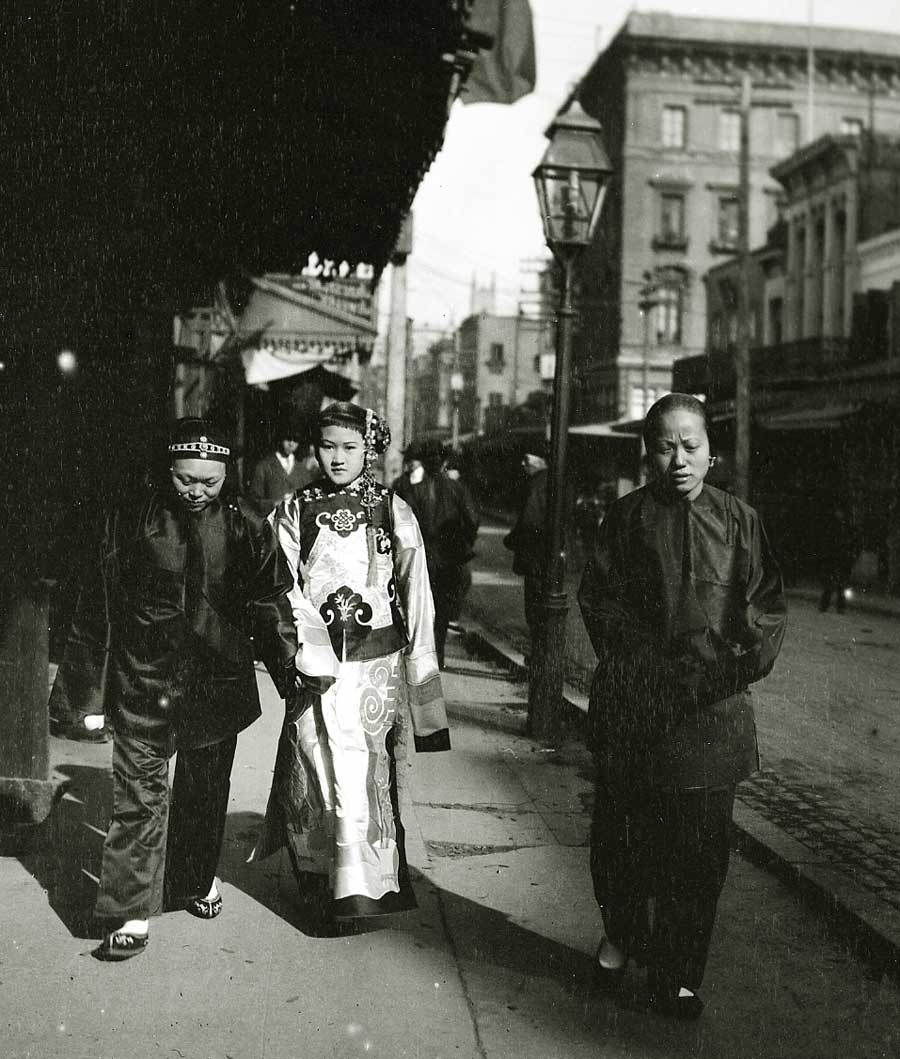 Detail: "Highborn Lady With Duenna": Sigismund Blumann: American: ca. 1901: This view is from a collection of at least 43 documentary photographs, with several corresponding paper negative envelopes dated 1901 by Blumann donated by his family to the California Historical Society. They can be viewed there as part of the collection “The Chinese in California: 1850-1925.” Photograph courtesy Thomas High
Detail: "Highborn Lady With Duenna": Sigismund Blumann: American: ca. 1901: This view is from a collection of at least 43 documentary photographs, with several corresponding paper negative envelopes dated 1901 by Blumann donated by his family to the California Historical Society. They can be viewed there as part of the collection “The Chinese in California: 1850-1925.” Photograph courtesy Thomas High
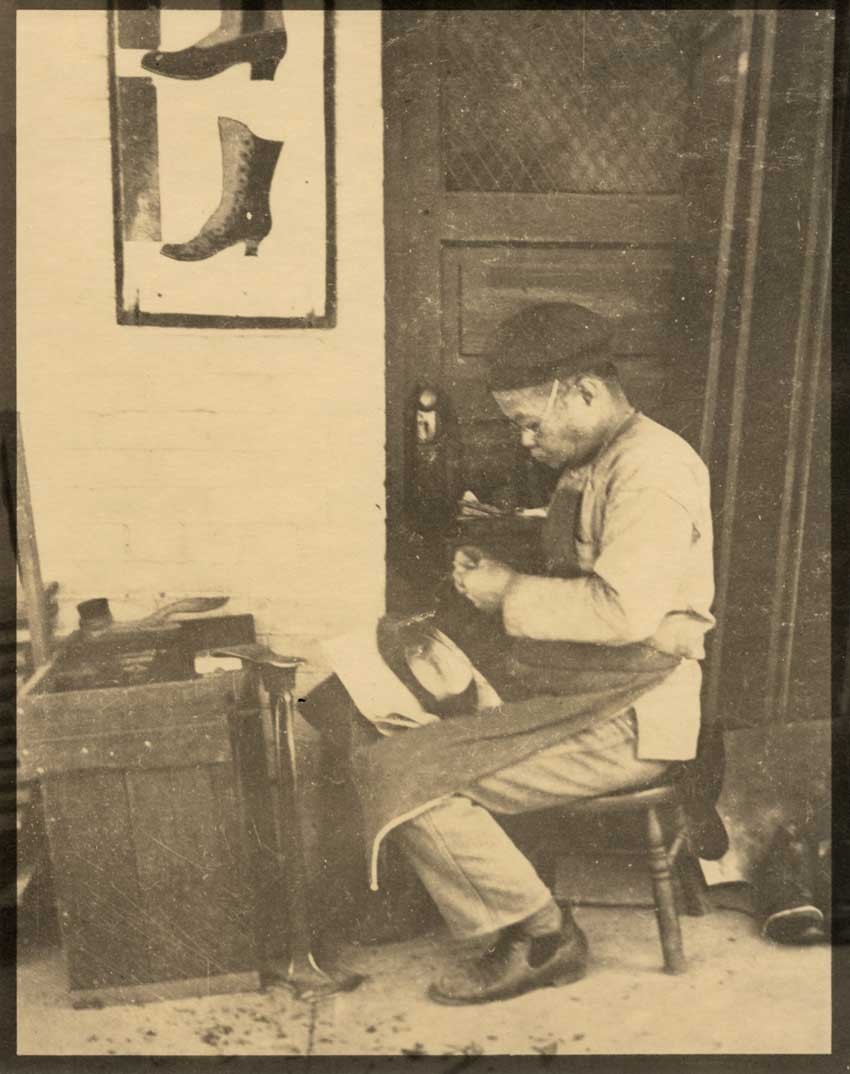 "Chinese Cobbler": San Francisco Chinatown: Sigismund Blumann: American: ca. 1901, printed early 1920s: gelatin silver print- app. 8 7/8 x 7.0": variant: "Shoe Mender": from California Historical Society collection: FN-34374: Photograph courtesy Thomas High
"Chinese Cobbler": San Francisco Chinatown: Sigismund Blumann: American: ca. 1901, printed early 1920s: gelatin silver print- app. 8 7/8 x 7.0": variant: "Shoe Mender": from California Historical Society collection: FN-34374: Photograph courtesy Thomas High
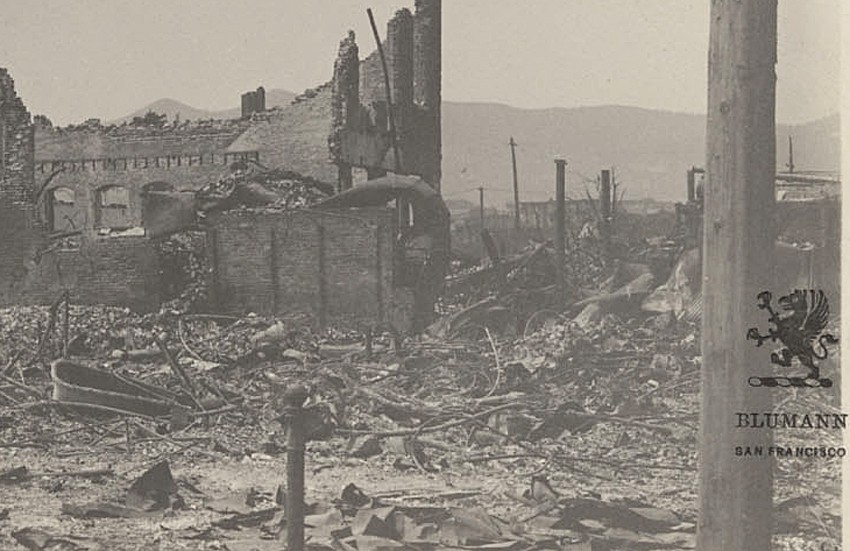 Detail: "Ruins" (San Francisco Earthquake): Sigismund Blumann: American: ca. 1906: gelatin silver print: 13.0 x 18.0 cm: overprinted with Blumann's winged griffin monogram at lower right: Photograph courtesy: California Historical Society: The 1906 San Francisco Earthquake and Fire Digital Collection: Local Call # FN-33293
Detail: "Ruins" (San Francisco Earthquake): Sigismund Blumann: American: ca. 1906: gelatin silver print: 13.0 x 18.0 cm: overprinted with Blumann's winged griffin monogram at lower right: Photograph courtesy: California Historical Society: The 1906 San Francisco Earthquake and Fire Digital Collection: Local Call # FN-33293
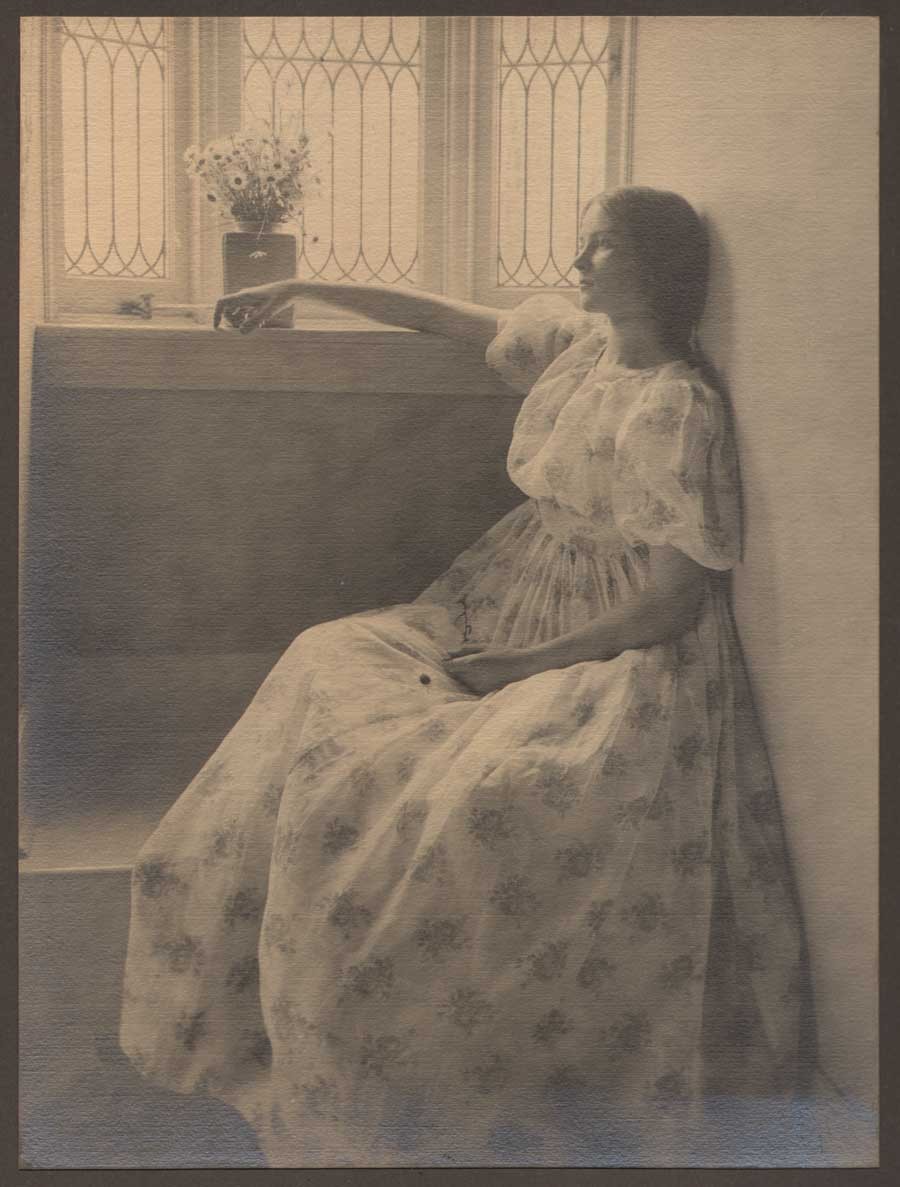 "Day Dreams" : Charles Rollins Tucker 1868-1956: American: gelatin silver print: June, 1906 printed 1915: 27.3 x 20.4 | 43.2 x 35.5 cm : First titled "Study in Home Portraiture" and published full page in the Oct. 1906 Photographic Times, this interior study later appeared as a full-page halftone in the July, 1907 Camera Craft magazine, and is a representative example of the pictorialist work that regularly appeared in its pages. Coincidentally, imagery like this was also gaining popularity during this time among amateur and professional photographers, and Sigismund Blumann was no exception, teaming up with fellow photographer Jacques Tillmany in 1907 on a part-time basis offering in-home photographic portraiture. From: PhotoSeed Archive
"Day Dreams" : Charles Rollins Tucker 1868-1956: American: gelatin silver print: June, 1906 printed 1915: 27.3 x 20.4 | 43.2 x 35.5 cm : First titled "Study in Home Portraiture" and published full page in the Oct. 1906 Photographic Times, this interior study later appeared as a full-page halftone in the July, 1907 Camera Craft magazine, and is a representative example of the pictorialist work that regularly appeared in its pages. Coincidentally, imagery like this was also gaining popularity during this time among amateur and professional photographers, and Sigismund Blumann was no exception, teaming up with fellow photographer Jacques Tillmany in 1907 on a part-time basis offering in-home photographic portraiture. From: PhotoSeed Archive
Beginnings in Word and Photography
Writing under his infrequent pen name Charles H. Fitzpatrick in Camera Craft in 1925, (3.) Sig most likely gives us a small hint of his own beginnings in photography, a passion that would soon evolve into his extensive documentation of life of San Francisco’s bustling Chinatown neighborhood in 1901. (4.) Later in this capacity as street shooter, he played the role of documentarian in the aftermath of the destruction of San Francisco in the 1906 earthquake and subsequent job as part-time portrait photographer after relocating to neighboring Oakland in 1907 due to the destruction. (5.) all while making his living as musical performer and teacher) :
Having become interested in Photography back in 1900 as an amateur with an old style Adlake plate camera, and two years later as a professional with a studio— and almost continuously since in Commercial Photography the author has had a wonderful opportunity to study composition both by experience and observation of the work of others. (6.)
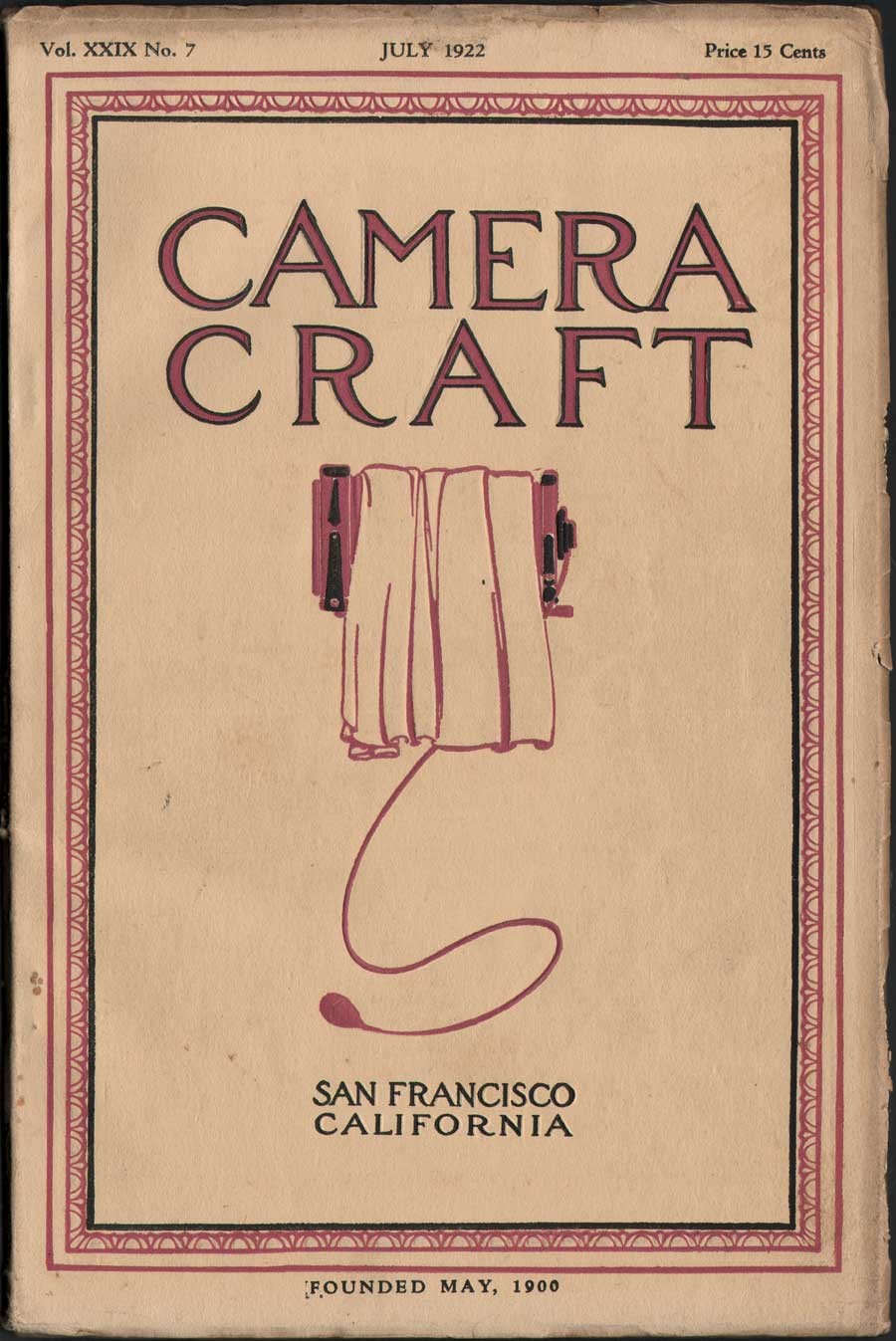 Cover Design: Camera Craft magazine: San Francisco, CA: July, 1922: 26.5 x 17.5 cm: two-color wood engraving : unknown artist and printer: cover price at upper right corner 15¢. This uncredited Camera Craft cover design first debuted with the January 1913 issue and featured a simple design of a plate camera shown in profile(lens board on right side) with dark cloth draped at center and bulb shutter release cable hanging down. This design lasted through the June, 1923 issue and was replaced with illustrations of architectural landmarks, notable western scenery and other thematic drawings done by San Francisco artist W.R. Potter through the September, 1924 issue. From: PhotoSeed Archive
Cover Design: Camera Craft magazine: San Francisco, CA: July, 1922: 26.5 x 17.5 cm: two-color wood engraving : unknown artist and printer: cover price at upper right corner 15¢. This uncredited Camera Craft cover design first debuted with the January 1913 issue and featured a simple design of a plate camera shown in profile(lens board on right side) with dark cloth draped at center and bulb shutter release cable hanging down. This design lasted through the June, 1923 issue and was replaced with illustrations of architectural landmarks, notable western scenery and other thematic drawings done by San Francisco artist W.R. Potter through the September, 1924 issue. From: PhotoSeed Archive
It was sometime in the 1890s, photographic historian Christian A. Peterson notes, that he “first used his wife’s Kodak camera to make snapshots and soon began searching the photographic periodicals for information and advice.” (7.) His editorship of Camera Craft as momentous professional occasion aside, Sig’s immersion in all things Photographic may very well have reached a high-point by 1933, the year he became a charter member of the Photographic Society of America as well as being honored a Fellow of the Royal Photographic Society.
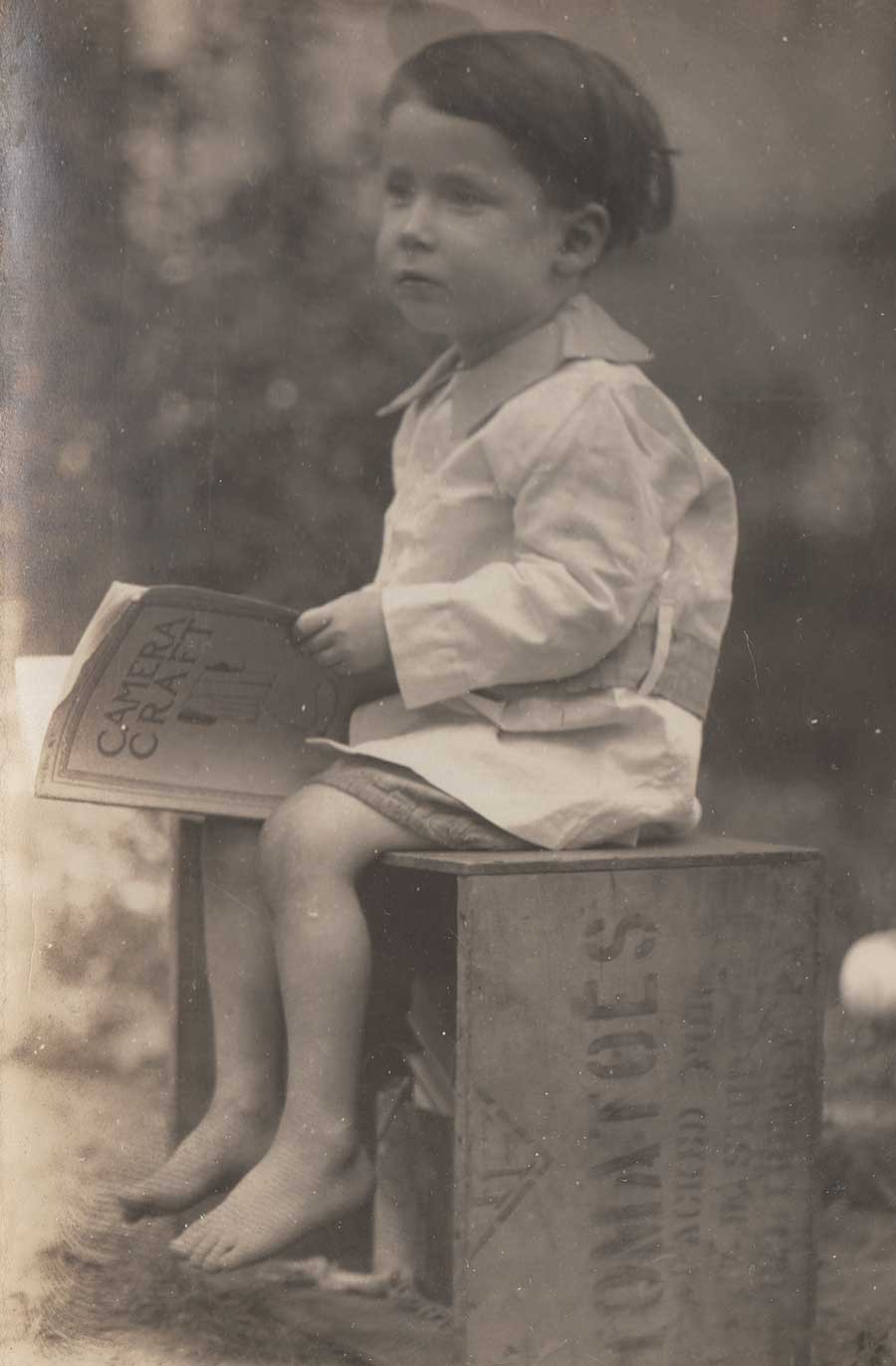 Detail: "Child Sitting on Tomato Crate Holding Camera Craft Magazine": by anonymous American photographer printed as unmailed postcard: gelatin silver print ca. 1920-25: 11.6 x 8.8 | 13.8 x 8.8 cm: written in graphite on verso: "with Love. Ellsworth" with the name "Walter" opposite address field. Child sits on crate stenciled on side as being from Pennsylvania-indicated "Packed For….PA " on side, with photo purchased from Parma, MI collector. From: PhotoSeed Archive
Detail: "Child Sitting on Tomato Crate Holding Camera Craft Magazine": by anonymous American photographer printed as unmailed postcard: gelatin silver print ca. 1920-25: 11.6 x 8.8 | 13.8 x 8.8 cm: written in graphite on verso: "with Love. Ellsworth" with the name "Walter" opposite address field. Child sits on crate stenciled on side as being from Pennsylvania-indicated "Packed For….PA " on side, with photo purchased from Parma, MI collector. From: PhotoSeed Archive
Photography in itself however was not his only reason for being during his professional career as editor, and even earlier as a musician. This was because Sig was a romantic at heart, a dreamer who had a great fondness for language, and the will to commit it to paper. Starting out for example, only in his early 20’s, he composed the following poem for the April, 1895 issue of the California-based magazine Overland Monthly:
PLEASURE.
PLEASURE is like perfect liquor,
Sweet to taste and after taste,
And like, too, in that when gotten
We imbibe too much, then waste,
And we find when pleasure passes
Life is empty as the glasses.
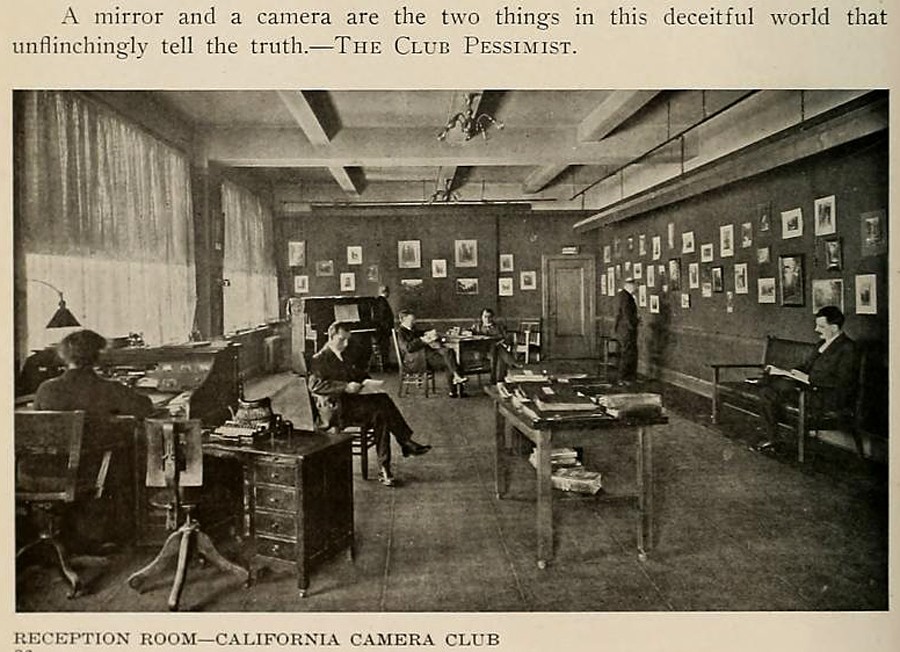 "Reception Room— California Camera Club": 1914: taken by an unknown photographer, this image appeared as a halftone illustration in the February, 1914 issue of Camera Craft for a story on the club, founded in 1890. At the time this appeared the club was located at 833 Market Street in San Francisco. The scene shows members seated with an exhibit of photographs on display at rear and on wall at right. Camera Craft regularly featured news of this important club, and future editor of the magazine Sigismund Blumann, although not a member, attended and was an occasional speaker. Photographic historian Christian A. Peterson notes Blumann spoke at this club in 1916 and much later, between 1934-40 attended gatherings here as well as at the Leica Club of Oakland, East Bay Camera Club, Golden Gate Miniature Camera Club, Photographic Society of San Francisco, San Jose Camera Club, and Western Amateur Camera Conclave. From: California State Library: Archive.org
"Reception Room— California Camera Club": 1914: taken by an unknown photographer, this image appeared as a halftone illustration in the February, 1914 issue of Camera Craft for a story on the club, founded in 1890. At the time this appeared the club was located at 833 Market Street in San Francisco. The scene shows members seated with an exhibit of photographs on display at rear and on wall at right. Camera Craft regularly featured news of this important club, and future editor of the magazine Sigismund Blumann, although not a member, attended and was an occasional speaker. Photographic historian Christian A. Peterson notes Blumann spoke at this club in 1916 and much later, between 1934-40 attended gatherings here as well as at the Leica Club of Oakland, East Bay Camera Club, Golden Gate Miniature Camera Club, Photographic Society of San Francisco, San Jose Camera Club, and Western Amateur Camera Conclave. From: California State Library: Archive.org
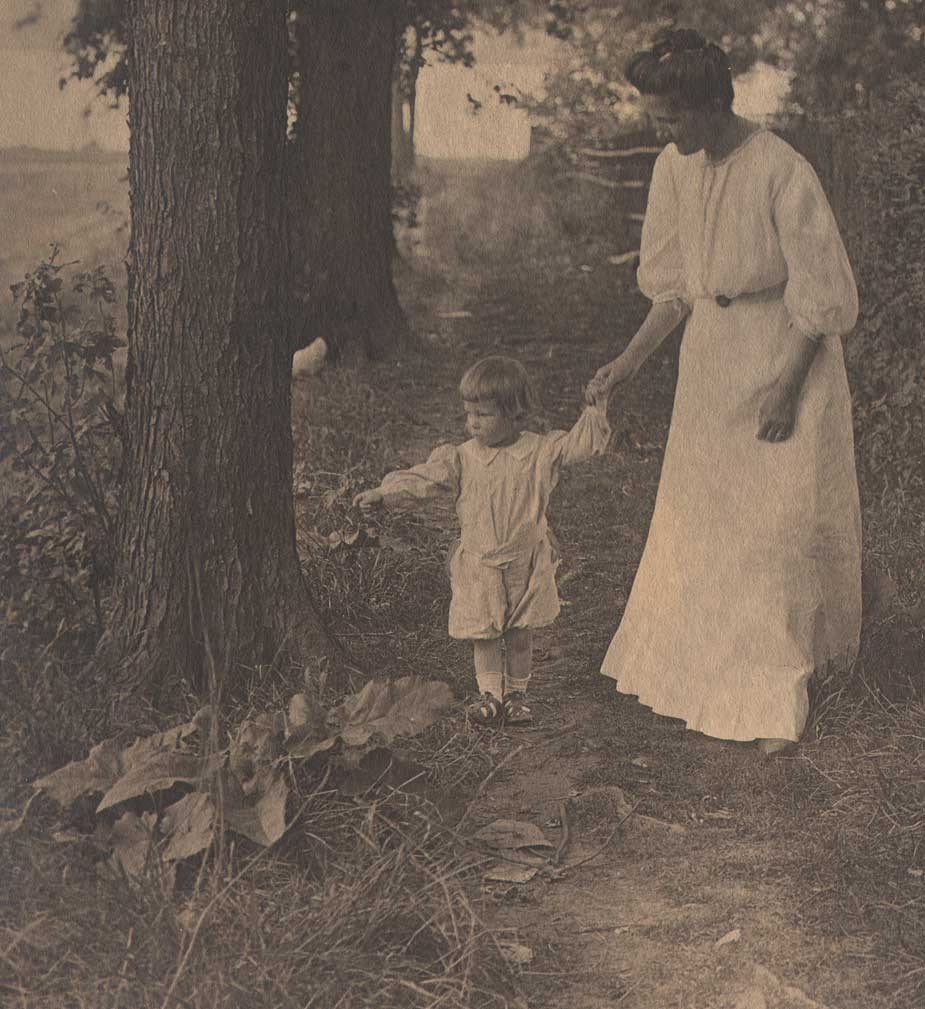 Detail: "Up the Path": Chester Moulton Whitney: American, b. 1873: 1914 or earlier: gelatin silver print: 24.8 x 19.3 cm: This photograph was illustrated as a full-page halftone with printed ornamental Art-Nouveau frame border in the August, 1914 Camera Craft, p. 422, and is a representative example of the pictorialist work that regularly appeared in its pages. From: PhotoSeed Archive
Detail: "Up the Path": Chester Moulton Whitney: American, b. 1873: 1914 or earlier: gelatin silver print: 24.8 x 19.3 cm: This photograph was illustrated as a full-page halftone with printed ornamental Art-Nouveau frame border in the August, 1914 Camera Craft, p. 422, and is a representative example of the pictorialist work that regularly appeared in its pages. From: PhotoSeed Archive
Wearing the hat of Poet-in-Residence at Camera Craft, Sig never neglected this early love of poetry for the publication, often combining his own photographic efforts alongside original compositions. One example, which he titled Lugubrio, though technically not even a real word, appeared in April, 1927, and was his way of simply assigning a mournful, or lugubrious meaning to his own photograph depicting jagged rocks and crashing waves-seen in his dramatic coastal landscape most likely taken on the Pacific coast:
LUGUBRIO
By Sigismund Blumann
The drowned and dead, now turned to stone,
Stand watching by the shore
And you may hear them through the night,
From set of sun to morning light,
As they shall do for evermore,
Weep as they watch, and moan. (p. 177)
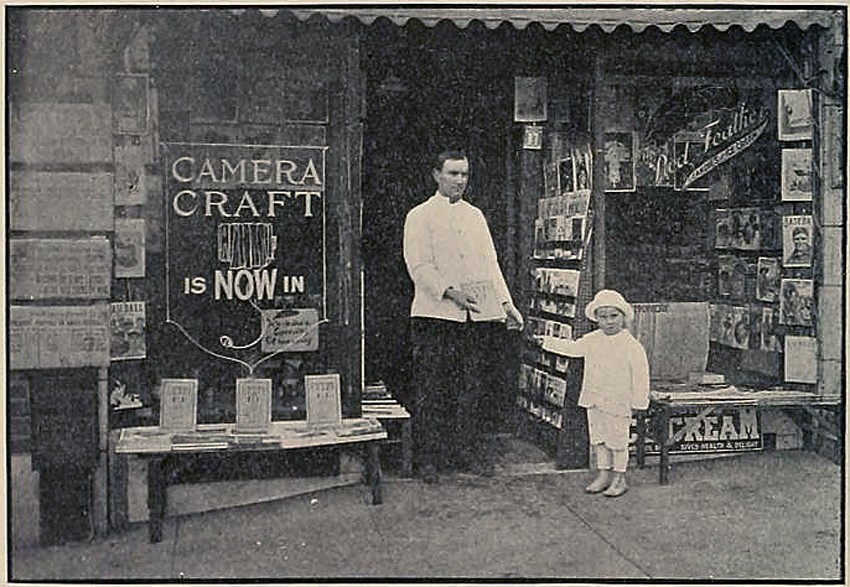 "Camera Craft is Now In": 1914: taken by an unknown photographer and used as a form of soft advertising, this image appeared as a halftone illustration in the June, 1917 issue of Camera Craft. It shows San Francisco business owner J.F. Brandert, owner of the Red Feather Store at 435 Jones Street, handing off a copy of the journal to a young visitor, with a display of three issues propped up on a bench at left in front of a window lettered with a graphic of the journal's cover: "CAMERA CRAFT IS NOW IN". From: California State Library: Archive.org
"Camera Craft is Now In": 1914: taken by an unknown photographer and used as a form of soft advertising, this image appeared as a halftone illustration in the June, 1917 issue of Camera Craft. It shows San Francisco business owner J.F. Brandert, owner of the Red Feather Store at 435 Jones Street, handing off a copy of the journal to a young visitor, with a display of three issues propped up on a bench at left in front of a window lettered with a graphic of the journal's cover: "CAMERA CRAFT IS NOW IN". From: California State Library: Archive.org
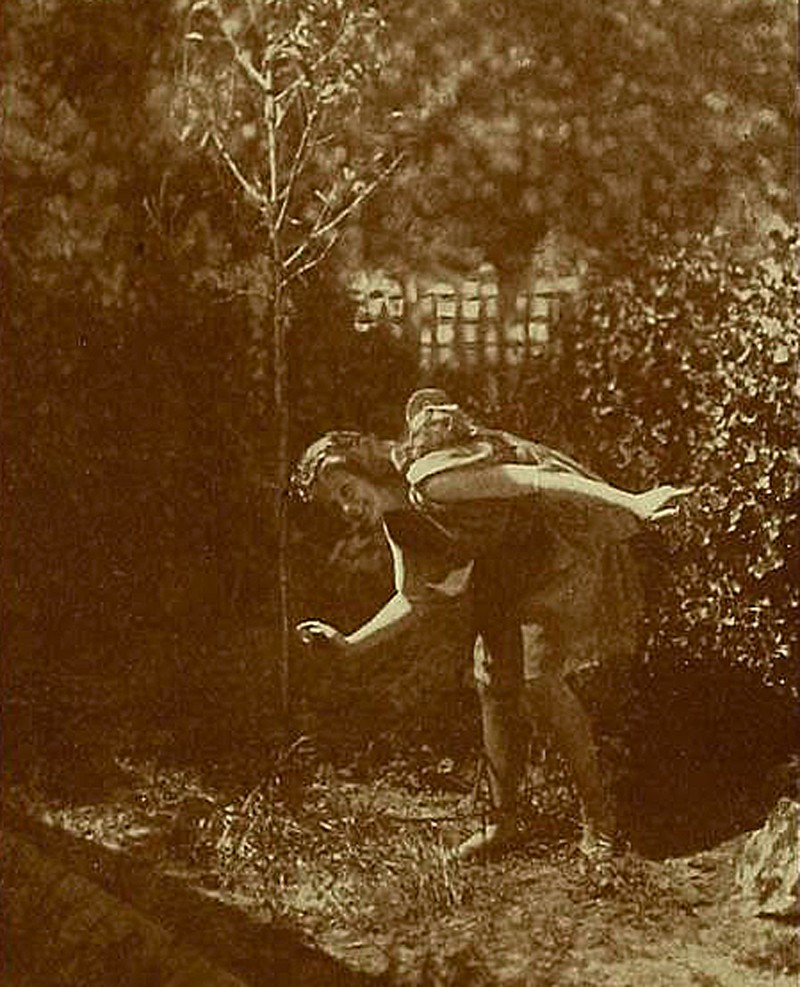 "When From Behind the Moondipt Bush Titania Floated in a Silver Haze": 1917 or before: Sigismund Blumann, American: This photograph was used as the frontis halftone for the July, 1917 issue of Camera Craft helping to illustrate the article "Poetry and Photography" written by Blumann. The photo shows Vera Hahn, a childhood friend of his eldest daughter Ethel Blumann. (b. 1902) He said of the photo: "She was costumed for a pageant and we all wanted a memento of the charming vision she made in our garden, among the green plants." This early example of Blumann's work also included one of his original poems titled "To Childhood": the first stanza: "Oh blessed youth! When from the enchanted page | Fancy stepped forth and made the unreal real, | When from behind the moondipt bush | Titania floated in a silver haze and greeted me! From: California State Library: Archive.org
"When From Behind the Moondipt Bush Titania Floated in a Silver Haze": 1917 or before: Sigismund Blumann, American: This photograph was used as the frontis halftone for the July, 1917 issue of Camera Craft helping to illustrate the article "Poetry and Photography" written by Blumann. The photo shows Vera Hahn, a childhood friend of his eldest daughter Ethel Blumann. (b. 1902) He said of the photo: "She was costumed for a pageant and we all wanted a memento of the charming vision she made in our garden, among the green plants." This early example of Blumann's work also included one of his original poems titled "To Childhood": the first stanza: "Oh blessed youth! When from the enchanted page | Fancy stepped forth and made the unreal real, | When from behind the moondipt bush | Titania floated in a silver haze and greeted me! From: California State Library: Archive.org
Camera Craft: Western Photographic Journal
Although he’d been a contributor to its’ pages in words and photos after the first decade of being founded, it would be 24 years from the journal’s 1900 founding until Sig would begin to establish an enduring legacy in the history of photography via his role as Editor-in-Chief of Camera Craft. Some historical background on the intents and purposes for this ground-breaking publication are in order.
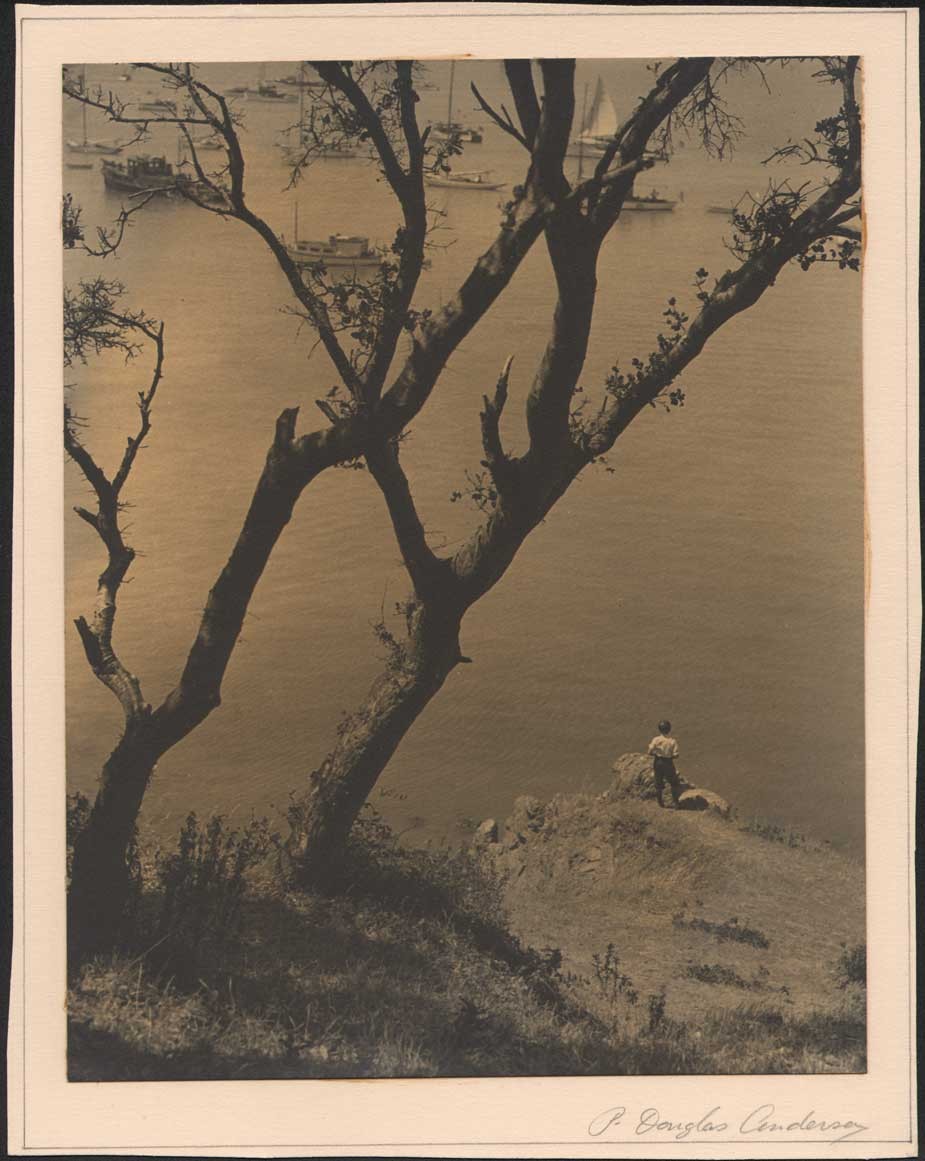 "Boy Looking out onto Bay" (San Francisco?-title supplied by this archive): ca. 1920-25: Paul Douglas Anderson, American 1887-1964: toned bromide or gelatin silver print: 24.2 x 19.0 | 27.5 x 21.6 cm: P. Douglas Anderson was an associate editor of Camera Craft beginning in May, 1923 & became editor-in-chief by January, 1924, continuing through the July issue. He was replaced by Sigismund Blumann the following month. Active in photography between 1910-1940's, Anderson was a member of the Camera Pictorialists of Los Angeles and Pictorial Photographers of America. From: PhotoSeed Archive
"Boy Looking out onto Bay" (San Francisco?-title supplied by this archive): ca. 1920-25: Paul Douglas Anderson, American 1887-1964: toned bromide or gelatin silver print: 24.2 x 19.0 | 27.5 x 21.6 cm: P. Douglas Anderson was an associate editor of Camera Craft beginning in May, 1923 & became editor-in-chief by January, 1924, continuing through the July issue. He was replaced by Sigismund Blumann the following month. Active in photography between 1910-1940's, Anderson was a member of the Camera Pictorialists of Los Angeles and Pictorial Photographers of America. From: PhotoSeed Archive
First based in San Francisco at 120 Sutter Street and issued monthly by the Camera Craft Publishing Company under the direction of editor W.G. Woods, the photographic journal Camera Craft was founded on the principles the West Coast of the United States should have an equal geographical mouthpiece of influence to counter that of the East Coast in promoting photography-for both professional and amateur workers. (to this end a separate page was devoted monthly to the happenings of many California amateur clubs) For the first issue of May, 1900, the following observations and arguments were made by the journal in support of these ideals:
The growth of photography, the introduction of simplifying methods in scientific picture-making, during the past twenty-five years is one of the wonders of the century. The phenomenal strides made by the photographic inventors of the world, resulting in the production of simple devices and convenient appliances, have made photography in all of its branches an almost universal fad. The Pacific Coast, ever ready to appreciate the merits of an innovation, has kept well abreast in the steady march of progress.
The wonderful climate of California lends itself enthusiastically to the wants of the photographer. The hand of Nature has reared, in eternal beauty, scenic effects unequaled elsewhere on earth. The very atmosphere of the Far West encourages the artistic impulse of its people. With such great natural advantages it is small wonder that when the western photographer has seen fit to cross the continent to compete with the eastern brotherhood he returns with laurels upon his brow. Not less wonderful is the existence of the largest Camera Club in the world in the city of the Golden Gate.
Yet, strange as it may seem, this great class of enthusiasts, this immense body of earnest workers has never been represented by a publication worthy of its trust. The photographers of the West have for years depended upon the journals of the East for enlightenment, but have looked in vain for recognition in their columns. It is to remedy this condition that Camera Craft now makes its bow to the public.
As to the scope of Camera Craft nothing can be said; it will have to speak for itself. The only promise made is the sincere intent on the part of the publishers to improve with each succeeding issue. The one hope of the magazine is that it may be so conducted as to meet the approbation of its readers and lend its aid to the material welfare of all interested in photography, whether for pleasure or for profit. (p. 26)
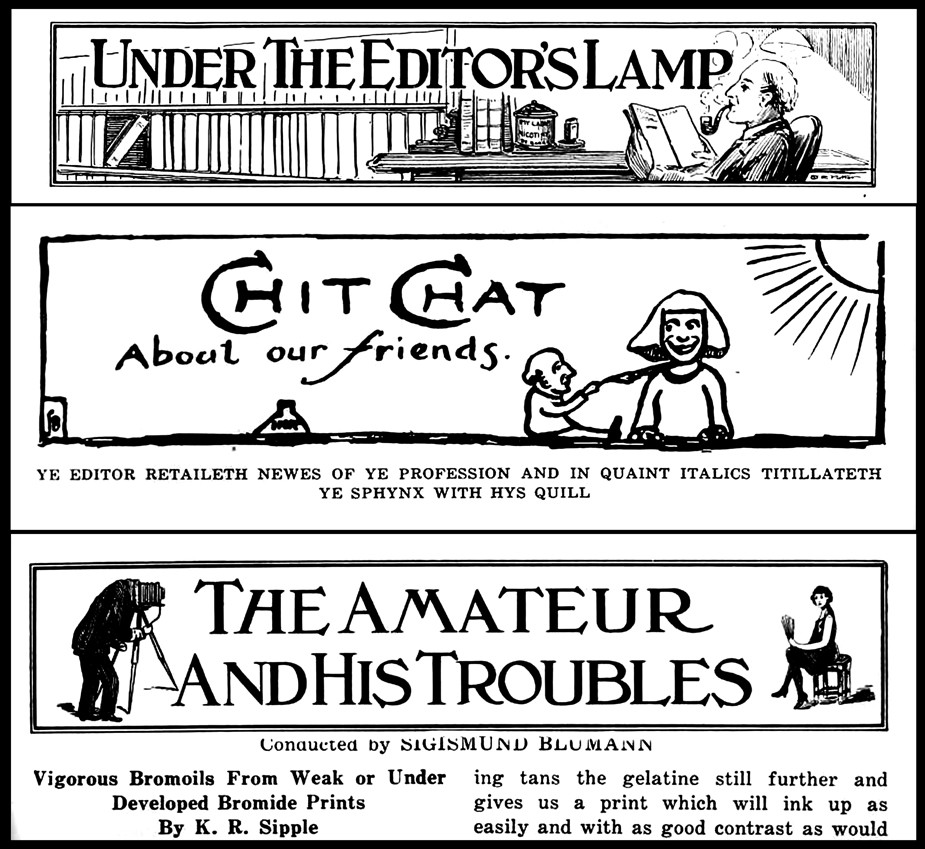 This triptych shows the three different Camera Craft magazine columns editor-in-chief Sigismund Blumann was involved with during his tenure at the journal from 1924-1933. "Under The Editor's Lamp" at top featured a caricature of the editor puffing a way on his trusty pipe while "Chit Chat About our Friends" at middle is comically subtitled "Ye Editor Retaileth Newes of Ye Profession And In Quaint Italics Titillateth Ye Sphynx With Hys Quill". "The Amateur And His Troubles", "conducted", appropriately enough by the man who had once made his living as a musician and orchestra leader, who already a feature of the publication when Blumann took over. From: PhotoSeed Archive
This triptych shows the three different Camera Craft magazine columns editor-in-chief Sigismund Blumann was involved with during his tenure at the journal from 1924-1933. "Under The Editor's Lamp" at top featured a caricature of the editor puffing a way on his trusty pipe while "Chit Chat About our Friends" at middle is comically subtitled "Ye Editor Retaileth Newes of Ye Profession And In Quaint Italics Titillateth Ye Sphynx With Hys Quill". "The Amateur And His Troubles", "conducted", appropriately enough by the man who had once made his living as a musician and orchestra leader, who already a feature of the publication when Blumann took over. From: PhotoSeed Archive
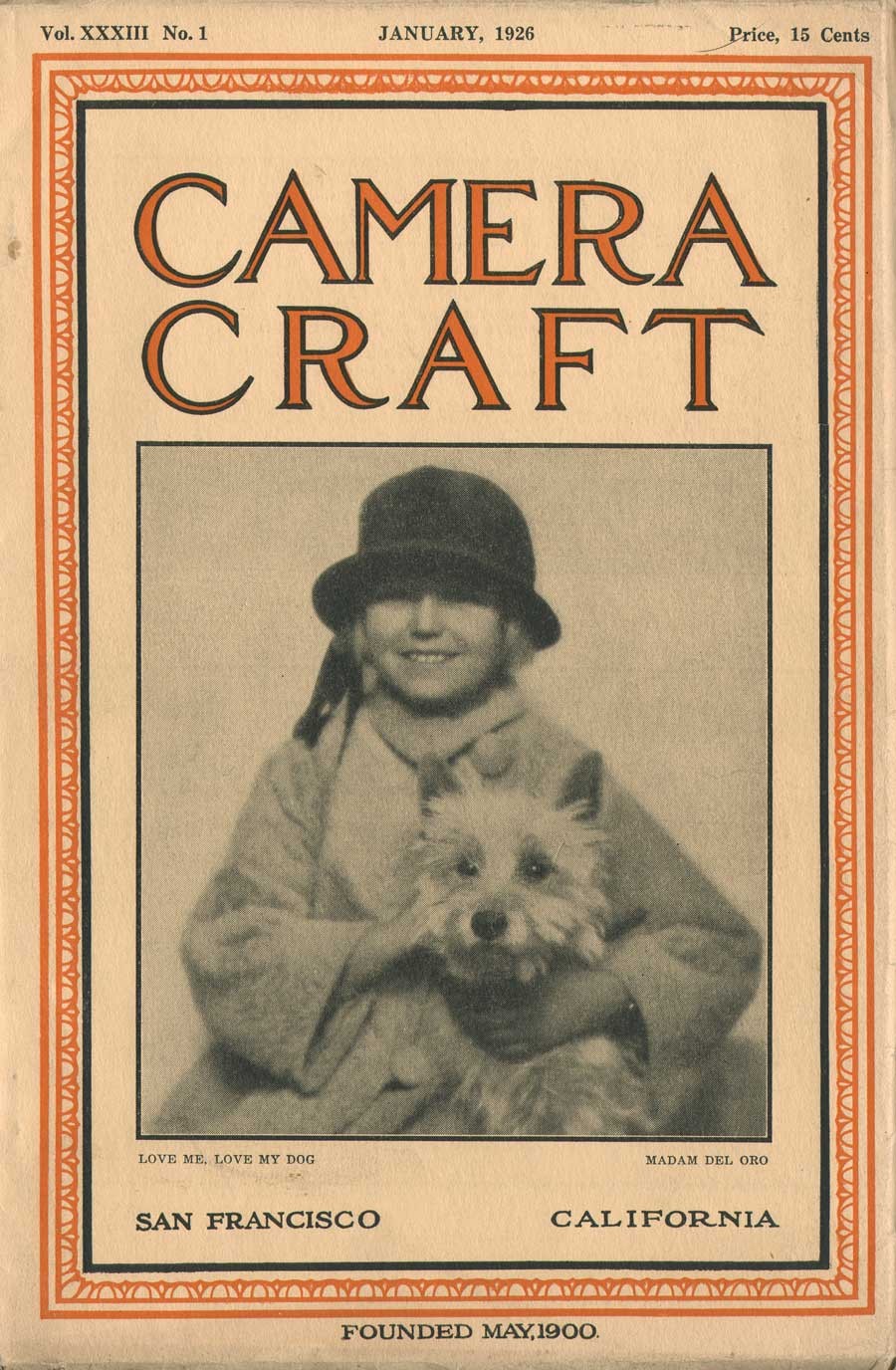 Cover Design: Camera Craft magazine: San Francisco, CA: January, 1926: Press of the Hansen Company, San Francisco: 26.5 x 17.5 cm: two-color wood engraved border design with inset halftone photograph: "Love Me, Love My Dog" by Madam Del Oro: American? 13.3 x 12.1 cm : cover price at upper right corner 15¢. One of the journal's seemingly obvious decisions, at least for the time, was to feature an actual photograph as a cover illustration for Camera Craft. Editor Blumann made this decision beginning with the October, 1924 issue. From: PhotoSeed Archive
Cover Design: Camera Craft magazine: San Francisco, CA: January, 1926: Press of the Hansen Company, San Francisco: 26.5 x 17.5 cm: two-color wood engraved border design with inset halftone photograph: "Love Me, Love My Dog" by Madam Del Oro: American? 13.3 x 12.1 cm : cover price at upper right corner 15¢. One of the journal's seemingly obvious decisions, at least for the time, was to feature an actual photograph as a cover illustration for Camera Craft. Editor Blumann made this decision beginning with the October, 1924 issue. From: PhotoSeed Archive
With its second issue for June, ambitions quickly shifted in support of the establishment of a West-Coast professional organization:
“Camera Craft intends to agitate the question of a Pacific Coast Convention of photographers. General inquiry throughout the state has led to the belief that such a convention is not only desirable but an actual need to those who make their living through the lens and shutter.” …We recall instances where photographers of this coast have attended conventions in the East and have returned with easy honors. Camera Craft would be pleased to learn of a serious consideration of the idea. A convention held in San Francisco with a first-class salon as an adjunct would undoubtedly lead to a permanent organization, and result in the advancement of the craft in a manner hitherto untried.” (p. 68)
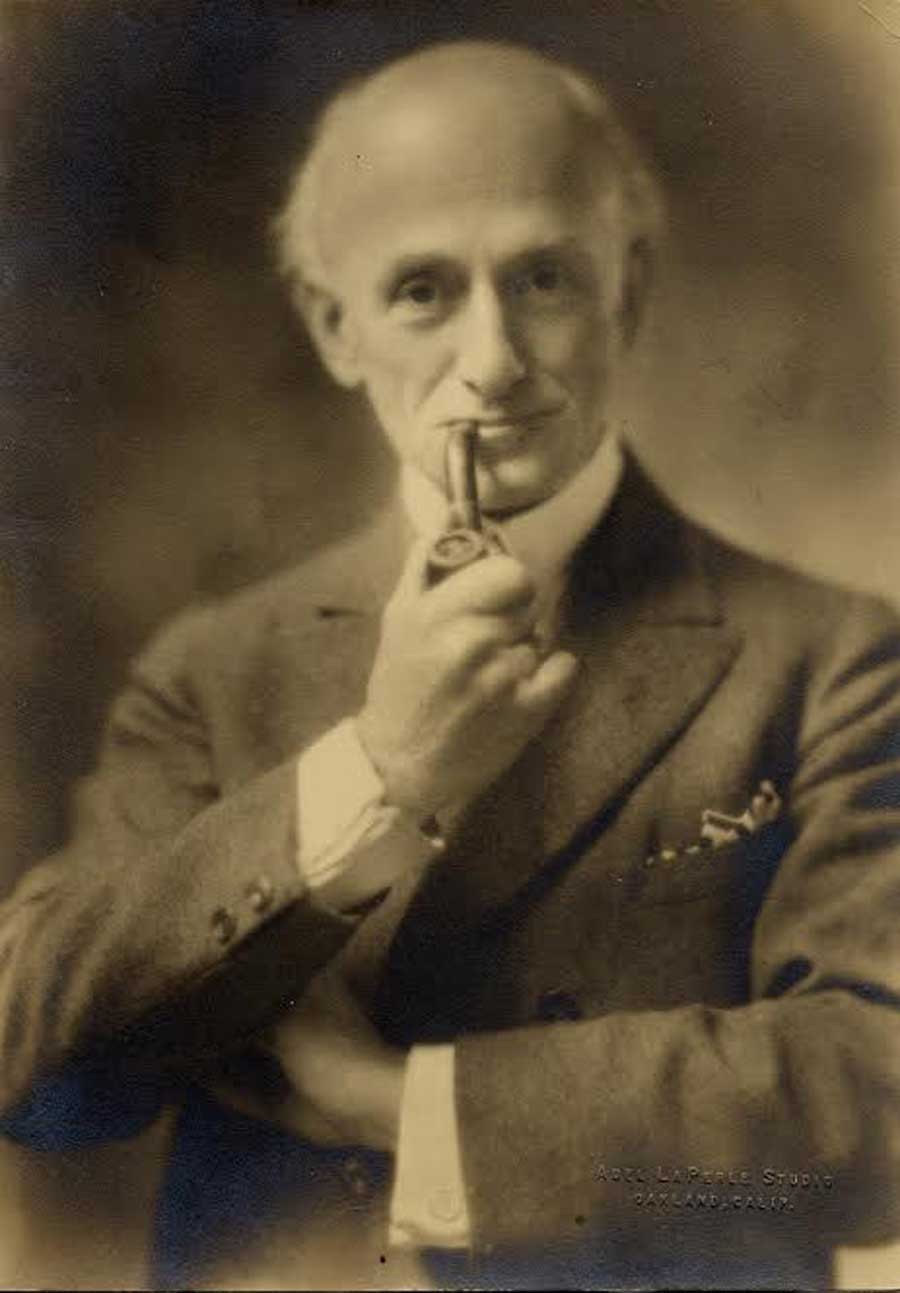 "Portrait of Sigismund Blumann": ca. 1928: Adel LaPerle Studio, Oakland, CA: gelatin silver print: Blumann was editor-in-chief of San Francisco-based Camera Craft magazine from 1924-1933: Photograph courtesy Thomas High
"Portrait of Sigismund Blumann": ca. 1928: Adel LaPerle Studio, Oakland, CA: gelatin silver print: Blumann was editor-in-chief of San Francisco-based Camera Craft magazine from 1924-1933: Photograph courtesy Thomas High
Although preceded geographically and in scope by the Pacific Coast Photographer, a short-lived monthly established in 1892 and believed to have ceased publication several years later, Camera Craft thrived as a robust Western photographic journal for the next 41 years. It first accomplished this under the capable tenure of editor Fayette J. Clute in the early decades of the publication before Sig took over in 1924, and was carried forward by him and others until the economic and human realities of World War II forced it’s hand. This occurred after the March, 1942 issue, when Camera Craft ironically headed back East so to speak, when it was absorbed by the Boston-based American Photography magazine. An editorial appearing in the final issue stated the decision to cease publishing was made because editor George Allen Young was taking his place in the armed services among other realities.
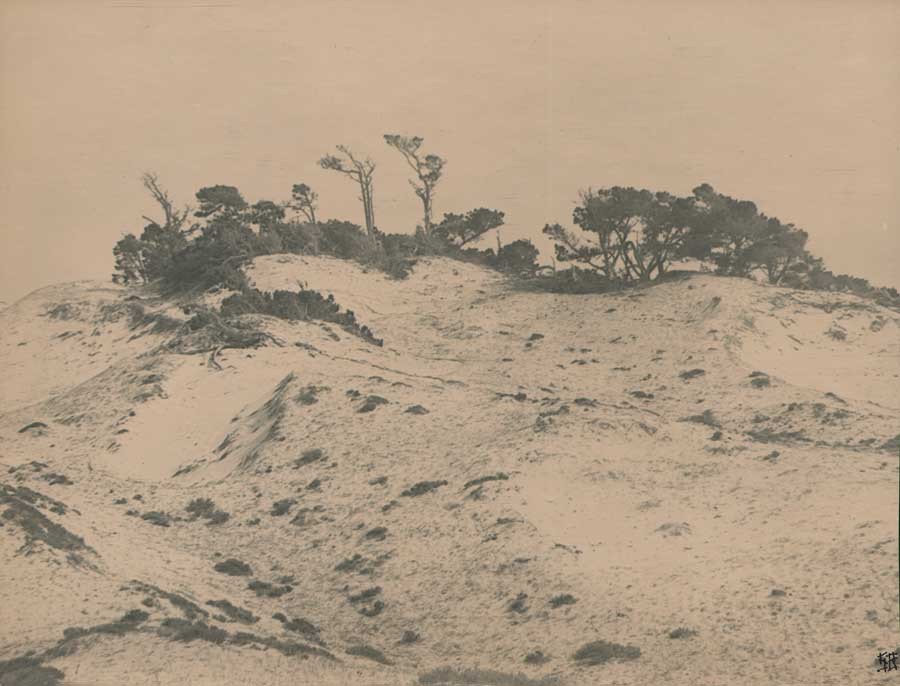 "Japonica" : Sigismund Blumann, American: ca 1920-40. gelatin silver print: 17.2 x 22.3 cm : This is a fine example of Blumann's pictorialist landscape work showing sand dunes and scrub trees, and was most likely taken on the West coast of the United States. Variants of this photograph have been similarly titled by the artist "Dune Pattern" and "Japanesque". This example signed in stylized Japanese initials at lower right corner: "SB". Three variants held by Minneapolis Institute of Arts: Accession #s: 99.230. (13-15) : From: PhotoSeed Archive
"Japonica" : Sigismund Blumann, American: ca 1920-40. gelatin silver print: 17.2 x 22.3 cm : This is a fine example of Blumann's pictorialist landscape work showing sand dunes and scrub trees, and was most likely taken on the West coast of the United States. Variants of this photograph have been similarly titled by the artist "Dune Pattern" and "Japanesque". This example signed in stylized Japanese initials at lower right corner: "SB". Three variants held by Minneapolis Institute of Arts: Accession #s: 99.230. (13-15) : From: PhotoSeed Archive
Sig As Camera Craft Editor: 1924-33
Photographic historian Christian A. Peterson, who called Camera Craft “the leading West Coast photographic monthly” and whose in-depth reassessment of Sigismund Blumann’s life and career was cited at the conclusion of Tom High’s short biography of his grandfather, called Sigismund Blumann:
”a prominent tastemaker in Californian photography during the 1920s and 1930s”. (8.)
Having an audience of 8000 monthly Camera Craft readers after coming aboard as chief editor in 1924 was surely a great start to becoming a tastemaker, but Sig proved his worth during the following nine years for his ability to impart to readers the essential knowledge of the ever-changing progress of photography. This took place in conjunction with his maintaining the vision of remaining true to himself-no matter how quirky some of his readers undoubtedly perceived him- while unashamedly promoting photographic talent in the pages of the magazine where he saw fit.
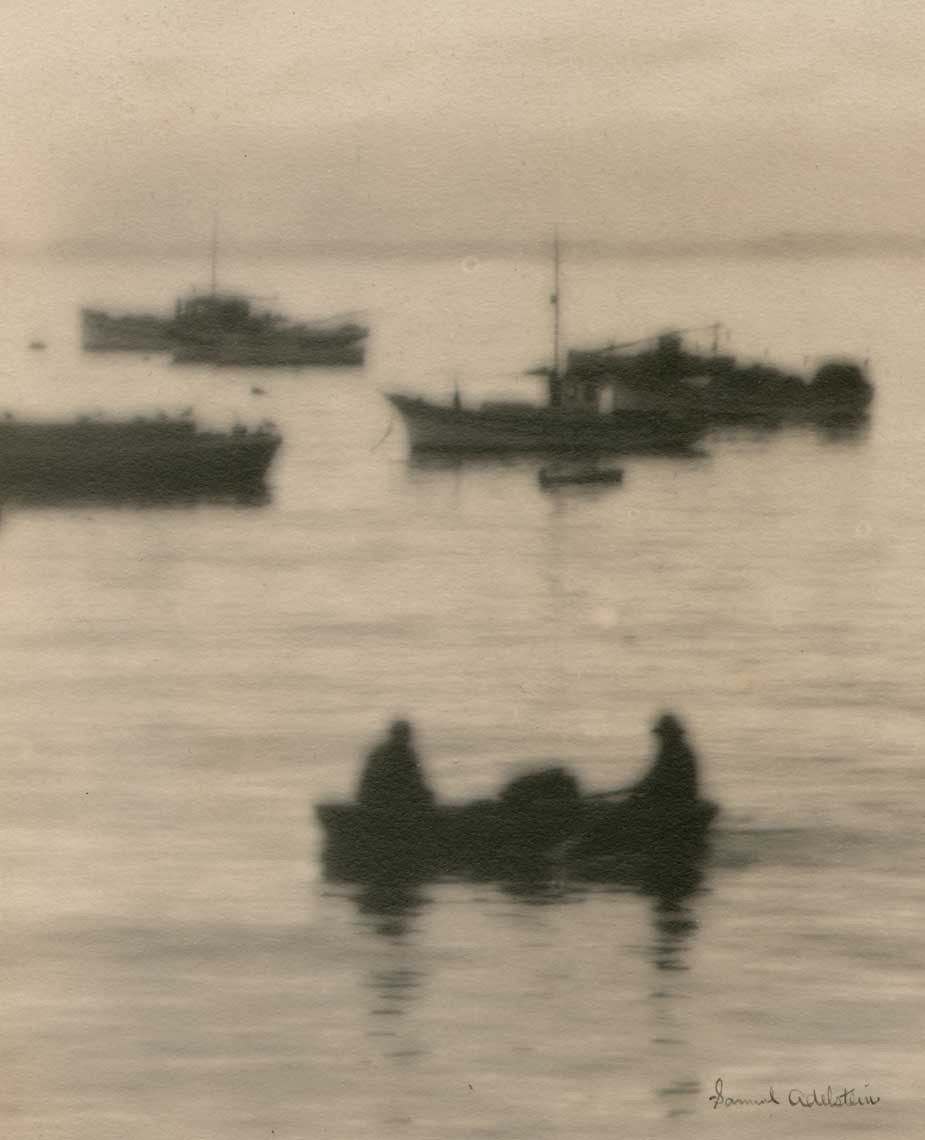 Detail: "Fishing Boats at Anchor" (probably Monterey Bay, CA) Samuel Adelstein, American, California: b. 1866?-d. 1934: silver bromide print ca. 1920-25: 18.5 x 13.6 | 40.6 x 25.4 cm: Adelstein was an active member of the California Camera Club whose pictorial works including a series of nude studies were published in Camera Craft in January, 1918 as part of the article: "An Enthusiast's Experience". The year before, the journal stated he was "an enthusiastic amateur photographer, a native son, a Director of the California Camera Club, and one of the Board of Governors of the Civic League of Improvement Clubs and Associations": Immersing himself in the art of photography around 1916, he specialized in making enlargements (from sharp negatives) with a soft-focus Verito lens. From: PhotoSeed Archive
Detail: "Fishing Boats at Anchor" (probably Monterey Bay, CA) Samuel Adelstein, American, California: b. 1866?-d. 1934: silver bromide print ca. 1920-25: 18.5 x 13.6 | 40.6 x 25.4 cm: Adelstein was an active member of the California Camera Club whose pictorial works including a series of nude studies were published in Camera Craft in January, 1918 as part of the article: "An Enthusiast's Experience". The year before, the journal stated he was "an enthusiastic amateur photographer, a native son, a Director of the California Camera Club, and one of the Board of Governors of the Civic League of Improvement Clubs and Associations": Immersing himself in the art of photography around 1916, he specialized in making enlargements (from sharp negatives) with a soft-focus Verito lens. From: PhotoSeed Archive
But some things remained the same after he took over. One, perhaps appropriate considering his musical background, was his retention of the subhead: “Conducted by Sigismund Blumann” for the journal’s long-established editorial column The Amateur And His Troubles previously edited by Paul Douglas Anderson. This time, an actual orchestra conductor was indeed stepping in to conduct editorial affairs! Keeping this personal touch intact-especially to those who knew him as someone passionate of music his entire life, was just one way of his remaining connected with readers as well as professional and social acquaintances in the Bay Area. Under Sig’s moderation, the column continued to offer advice dispensed by any number of well regarded authors who broke down and offered solutions to problems encountered by amateurs in the field relating to anything from photographic equipment to darkroom dilemmas.
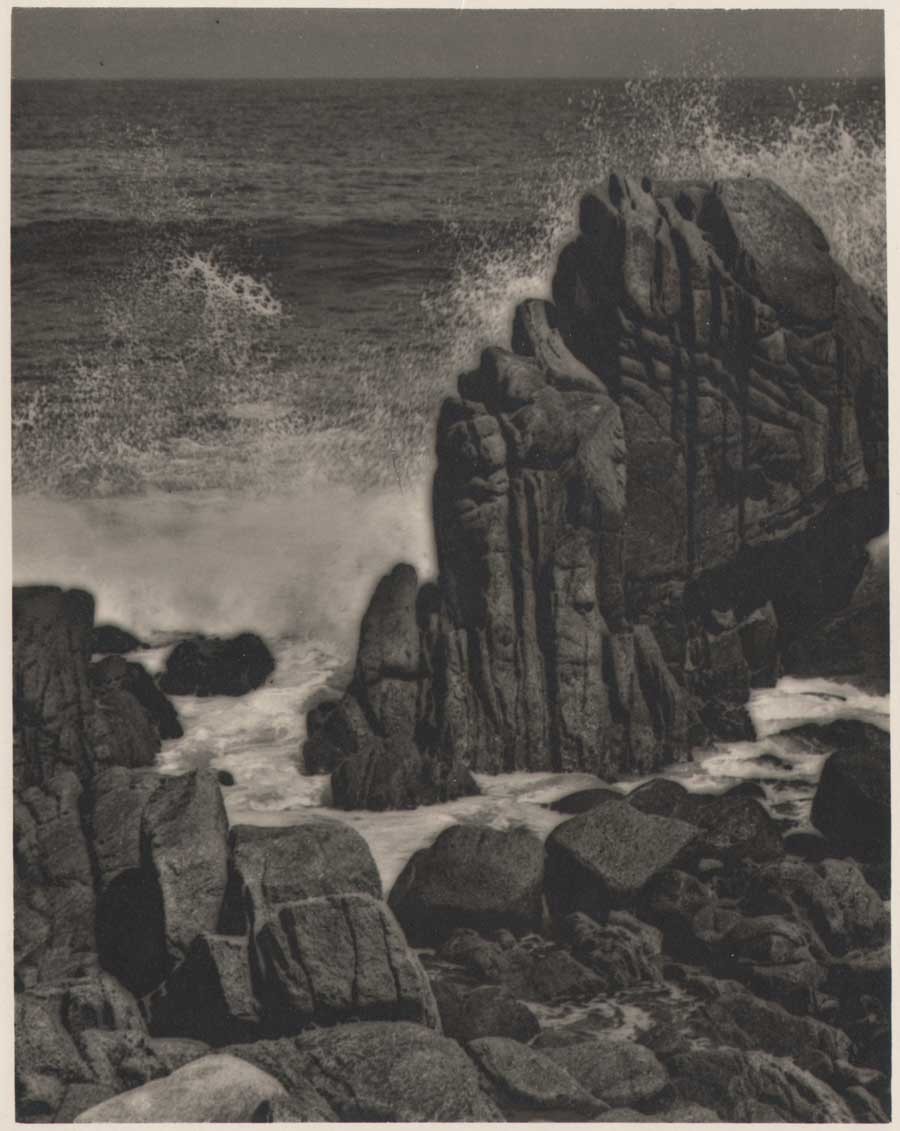 "Lugubrio": Sigismund Blumann, American: 1927 or before: gelatin silver print: 20.8 x 16.4 | 25.3 x 20.1 cm: This image, reproduced as a large halftone, was published on the same page as an accompanying poem of the same title for the April, 1927 issue of Camera Craft. The scene was most likely taken along the Pacific coastline. From: PhotoSeed Archive
"Lugubrio": Sigismund Blumann, American: 1927 or before: gelatin silver print: 20.8 x 16.4 | 25.3 x 20.1 cm: This image, reproduced as a large halftone, was published on the same page as an accompanying poem of the same title for the April, 1927 issue of Camera Craft. The scene was most likely taken along the Pacific coastline. From: PhotoSeed Archive
His second column, a new feature which debuted with the November, 1924 issue, was called CHIT CHAT About our friends. A vehicle for Sig’s effusive boosterism of photography in general, both professional and amateur, it was written in a style that might best be described, amusingly, as slightly syrupy in tone but delivered with erudition. Profiles on photographers he found interesting, and news of California camera clubs were a constant monthly feature of the column in addition to news of major upcoming exhibitions as well as critiques and results from those salons happening not only on the West Coast but throughout the United States and beyond. Comically subtitled: “Ye Editor Retaileth Newes of Ye Profession And In Quaint Italics Titillateth Ye Sphynx With Hys Quill”, the column’s “titillations” were often just longish aphorisms managing implied or direct associations to something photographic. Appearing rather infrequently at the column’s outset and disappearing altogether by August, 1931 when this inventive take on the English language was eliminated, they appeared from time to time, with several reprinted below for his January, 1926 column:
“Every time you get the best of a customer you have cheated yourself.”
“The most expensive lens may not be the best but the cheapest is pretty sure to be the worst.”
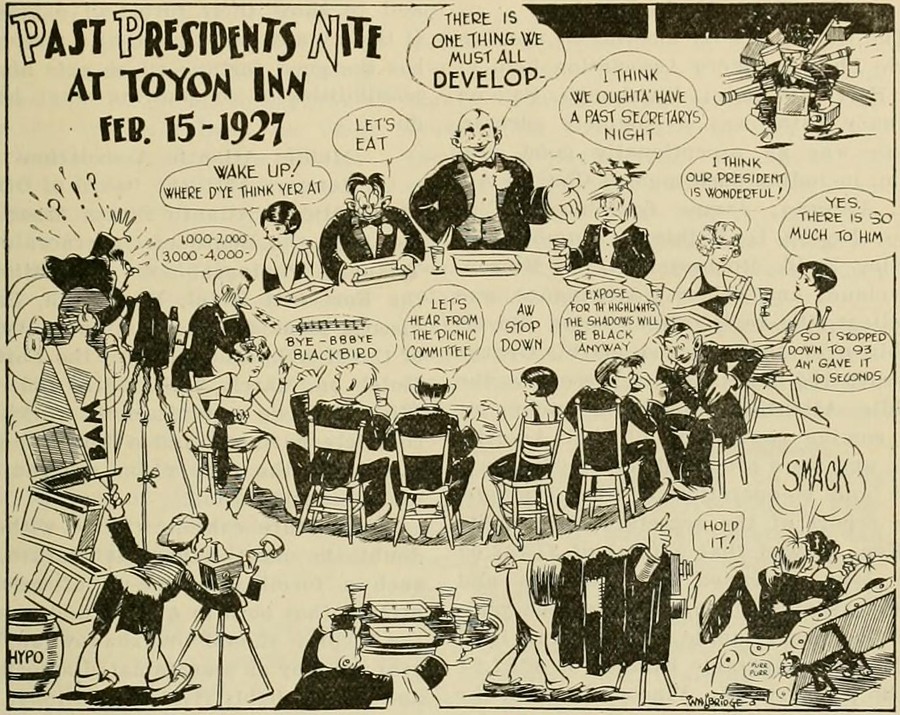 "Past Presidents Nite At Toyon Inn Feb. 15- 1927" : by artist W.A. Bridge, American -California? : Used as a halftone in the March, 1927 issue of Camera Craft, this humorous cartoon illustrated a dinner dance commemorating a gathering of past presidents of the Pacific International Photographers' Association which took place at San Leandro's Toyon Inn on Feb. 15, 1927. Sigismund Blumann, who served as host of the event, made sure to comment in the pages of Camera Craft magazine that "refreshments" of a most unusual kind: ie: inebriating, were served at the event during the era of American Prohibition. From: California State Library: Archive.org
"Past Presidents Nite At Toyon Inn Feb. 15- 1927" : by artist W.A. Bridge, American -California? : Used as a halftone in the March, 1927 issue of Camera Craft, this humorous cartoon illustrated a dinner dance commemorating a gathering of past presidents of the Pacific International Photographers' Association which took place at San Leandro's Toyon Inn on Feb. 15, 1927. Sigismund Blumann, who served as host of the event, made sure to comment in the pages of Camera Craft magazine that "refreshments" of a most unusual kind: ie: inebriating, were served at the event during the era of American Prohibition. From: California State Library: Archive.org
Lastly, and most importantly, one of the most personal reasons for Camera Craft’s success under Sig was his entirely self-written Under the Editor’s Lamp column, debuting with the April, 1926 issue. Already a fixture by means of the pen to his many readers-in prose as well as poetry- the column gave a final say so to speak to his personal views-conservative to be sure-on just about anything going on regarding photography and musings on current events. With accompanying column artwork by California artist W.R. Potter portraying Sig kicking back while puffing his pipe and seated at a library desk, the column became an effective way for this journal’s Editor-in-Chief to assume the role of oracle and brand ambassador. Sig’s short forward for his first Under the Editor’s Lamp :
When the desk is cleared of paste-pot and shears and the lamp is lit, it is good to put a match to the freshly loaded, old pipe and take a puff or two, letting the mind’s mind relax into mere dreams. The lamp is a sentimental fiction, of course, being a standardized glass bowl with a bulb glowing through, but the pipe is real, the mood is sincere, and we hope the mind exists, more or less.
Out go our thoughts to readers unseen, perhaps never to be met except as a large, critical, voracious body of men and women who consume the forty-eight pages of pictures and text and off-hand decide the fare has been very good, fair, or rotten. Little do they care what labor, what hopes, what ambitions went into every line and every illustration. Why should they. The best is no better than their due. (p.180)
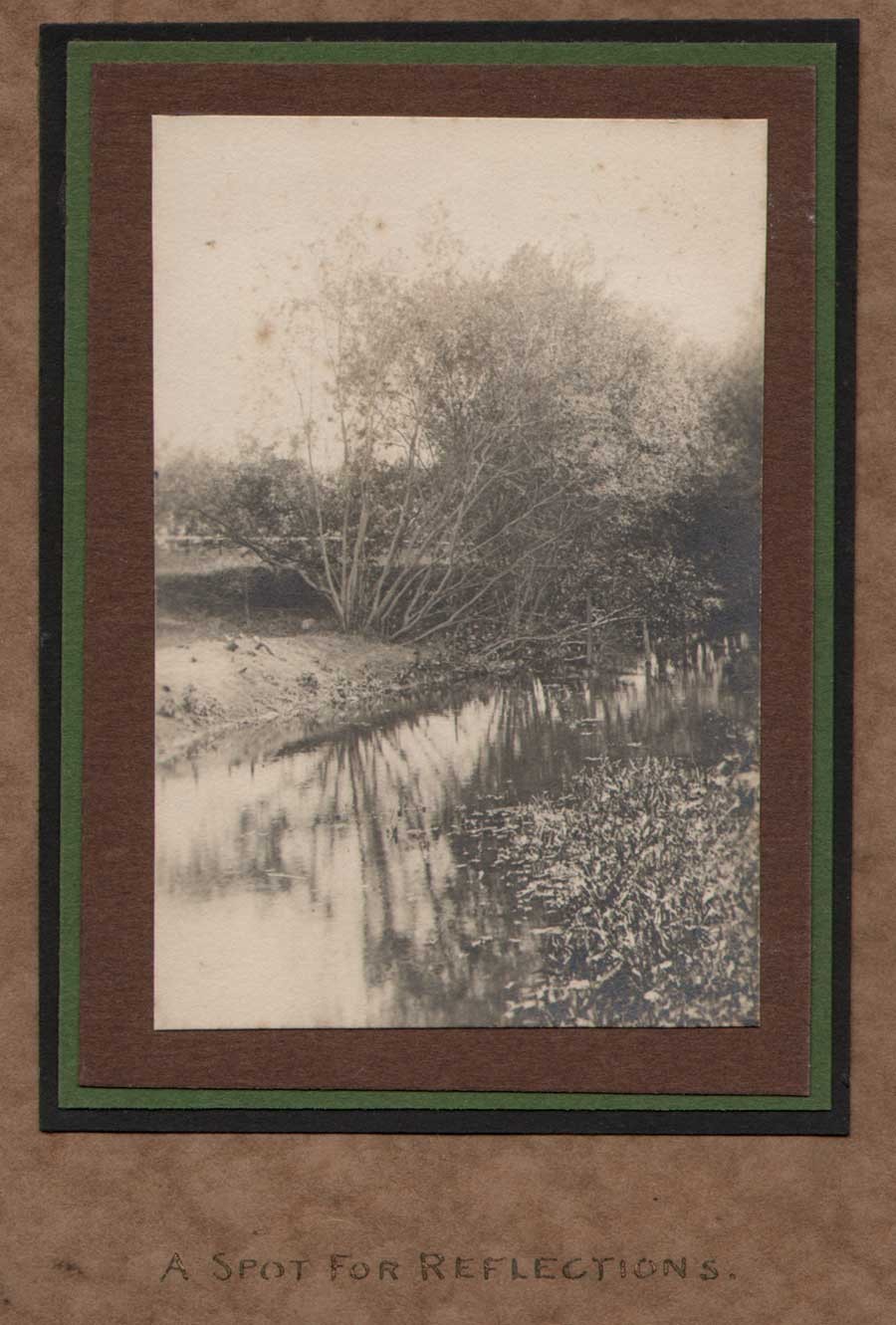 "A Spot for Reflections": Sigismund Blumann, American: ca. 1925-30: gelatin silver print : 9.8 x 6.5 | 18.2 x 14.5 cm : perhaps taken in Oakland or the Inverness area of Marin County, CA, this is a fine example of Blumann's pictorialist work in which he has titled the composition in gold lettering and triple-mounted the image onto fine art paper supports. From: PhotoSeed Archive
"A Spot for Reflections": Sigismund Blumann, American: ca. 1925-30: gelatin silver print : 9.8 x 6.5 | 18.2 x 14.5 cm : perhaps taken in Oakland or the Inverness area of Marin County, CA, this is a fine example of Blumann's pictorialist work in which he has titled the composition in gold lettering and triple-mounted the image onto fine art paper supports. From: PhotoSeed Archive
M.Q. Developer to Develop Good Feeling
Because Camera Craft billed itself the official organ of the Pacific International Photographers’ Association, (PIPA) with owner Ida M. Reed acting as Secretary and headquartered in the same San Francisco offices as the journal, (703 Market in Claus Spreckles Building) news of the Association-which covered a wide western geographic area including membership from Alaska, Alberta, Arizona, British Columbia, California, the Hawaiian Islands, Idaho, Montana, Nevada, Oregon, Utah and Washington states- became a regular monthly feature of the previously discussed Chit-Chat column. By 1927, Sig was hitting full-stride at Camera Craft, his writing skills undoubtedly honed through his reminisces featured in the Editor’s Lamp column.
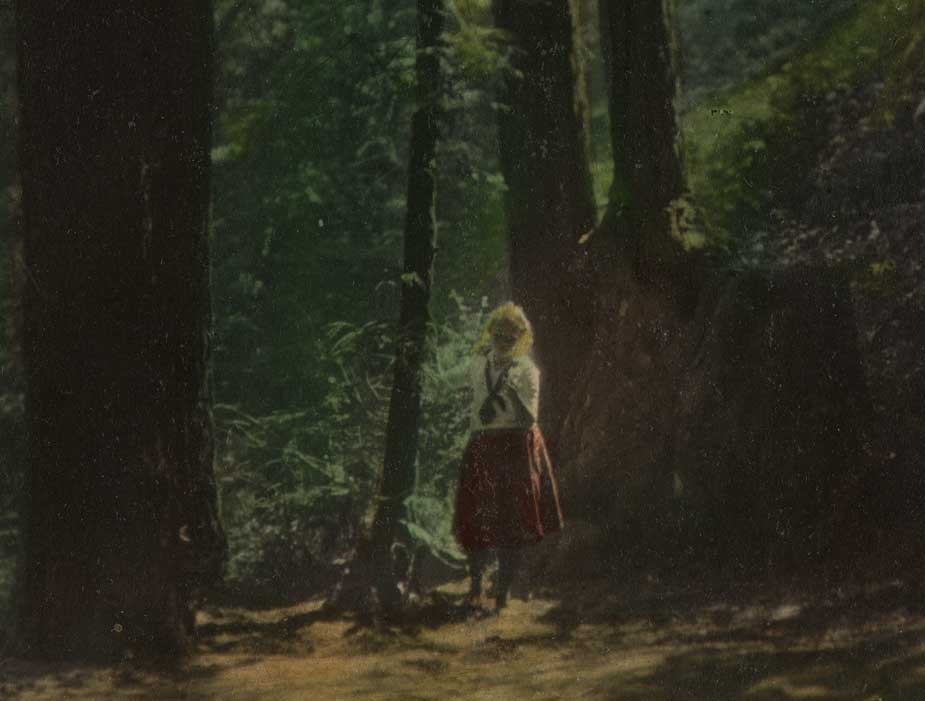 Detail: "Vera in the Woods": Sigismund Blumann, American: 1920-25: hand-colored gelatin silver print: 24.2 x 18.6 cm: Taken among a stand of Redwood trees, perhaps in the present-day Muir Woods National Monument in Marin County, CA, the subject of this photograph is believed to show the photographer's youngest daughter Vera Blumann, b. 1911. Blumann was in love with the outdoors, and frequently took part in extended camping trips with family members to hike and photograph areas of beauty in California and the Pacific Northwest-trips he wrote about in the pages of Camera Craft. See variant: Minneapolis Institute of Arts: Accession #99.231.15. From: PhotoSeed Archive
Detail: "Vera in the Woods": Sigismund Blumann, American: 1920-25: hand-colored gelatin silver print: 24.2 x 18.6 cm: Taken among a stand of Redwood trees, perhaps in the present-day Muir Woods National Monument in Marin County, CA, the subject of this photograph is believed to show the photographer's youngest daughter Vera Blumann, b. 1911. Blumann was in love with the outdoors, and frequently took part in extended camping trips with family members to hike and photograph areas of beauty in California and the Pacific Northwest-trips he wrote about in the pages of Camera Craft. See variant: Minneapolis Institute of Arts: Accession #99.231.15. From: PhotoSeed Archive
The following account is a result of this, of Sig’s prodigious social engagement with members active in the Bay-area camera club scene. In a humorous yet telling example of his own admission to preserve the rightful history of one particular PIPA (often referred to as a club) meeting for Chit-Chat, the March, 1927 issue duly reported on the Past Presidents Night dinner dance at San Leandro’s Toyon Inn on Feb. 15, 1927. Taking place when Prohibition was still the law of the land in America, (9.) Sig’s account made sure to include the lengths employed at the soirée in order for those attending to enjoy the social, and inebriating benefits of some “liquid cheer”:
But hold, before we close it must be chronicled as it shall be inscribed in the archives of the club that each guest found a developing tray and two glass graduates before him. It was a paper tray, so that when dropped the falling tray might not raise the deuce. In one of the two ounce graduates water was served and in the other M.Q. developer to develop good feeling. A bucket of Hypo was kept in the ante-room to fix the police, and everything was provided to make a perfect picture except bromide. If any was needed it was the next morning. (p. 145: M.Q. was an alkaline developer for gelatine emulsions combining Metol and hydroquinone)
 "Yosemite Falls | Yosemite Valley": Sigismund Blumann, American: dated 1926 & signed: "Dry Point Etching" ie: most likely a Kallitype or bleached and toned print on Vitava E (tching) chlorobromide paper: 13.1 x 9.0 | 23.7 x 16.5 cm: A specialist in alternative darkroom processes, particularly Kallitype, Blumann perfected his "Dry Point Etching" process and described it in lengthy articles in Camera Craft in 1925 and later in July, 1934 for his own Photo Art monthly using the pen name "Charles H. Fitzpatrick." This finished etching showing Yosemite Falls was originally taken as a photograph by Blumann in the Spring of 1925. Both photo and etching were illustrated side-by-side as halftones in the October, 1925 Camera Craft article titled "Making Photographs Into Dry Point Etchings". See the following citation at end of this caption in Notes field for a working description of the "Dry Point Etching" process. (11.) From: PhotoSeed Archive
"Yosemite Falls | Yosemite Valley": Sigismund Blumann, American: dated 1926 & signed: "Dry Point Etching" ie: most likely a Kallitype or bleached and toned print on Vitava E (tching) chlorobromide paper: 13.1 x 9.0 | 23.7 x 16.5 cm: A specialist in alternative darkroom processes, particularly Kallitype, Blumann perfected his "Dry Point Etching" process and described it in lengthy articles in Camera Craft in 1925 and later in July, 1934 for his own Photo Art monthly using the pen name "Charles H. Fitzpatrick." This finished etching showing Yosemite Falls was originally taken as a photograph by Blumann in the Spring of 1925. Both photo and etching were illustrated side-by-side as halftones in the October, 1925 Camera Craft article titled "Making Photographs Into Dry Point Etchings". See the following citation at end of this caption in Notes field for a working description of the "Dry Point Etching" process. (11.) From: PhotoSeed Archive
Camera Nut to the End
Considering he was having an awfully good time in his position as Editor-in Chief, an observation certainly not witnessed by this writer but most obvious by the written evidence left for posterity, Sig’s resignation at the end of July, 1933 does seem a bit abrupt. Historian Christian A. Peterson speculates he and owner Ida M. Reed “parted ways over deep differences.” (10.) But with the installation of Camera Craft veteran George Allen Young to replace him, Sig was none the less given deserved praise by owner Ida Reed the following month:
Since 1924 we, and the readers of this magazine, have enjoyed his contagious enthusiasm, and his wide technical knowledge of photography,. He leaves with our best wishes for success and happiness. (p. 387)
Earlier, for his final Under the Editor’s Lamp column written in July, 1933 and published the next month, his nine-year run at the journal concludes with a perhaps knowing, but certainly wistful remembrance of his good times spent there. Recounting adventures in photography that summer while traveling the California High Sierra, Sig first gives accolades to the efforts U.S. President Theodore Roosevelt was giving to get American industry moving again during the ongoing Great Depression before concluding by stating his own continued love affair with photography:
Does thinking of Yosemite and speaking of photography seem like reductum ad absurdum to you? It should not for I can allow myself so very short a time in that garden of The God and I can so effectively carry some of its glory and inspiration over the rest of the year with what my camera has enabled me to bring home, that it is natural to raise the picture, as near as imagination makes possible, to the original.
As I look at the screen and project the pictures, studying how to express my reactions when on the spot, I once again smell the pines and hear the rush of the Merced as it boils over the Happy Isles. In the quiet and the benignancy of the red light fancy builds Half Dome, El Capitan, and the Domes anew.
The old rags that made us free. The open spaces that made us immortal in spiritual disembodiment. The camera that vitalized every hour of the day with its assurance of creative picture making. Friends, I am glad, very glad, to be a camera Nut. (p. 343)
With that, a poem by Sig somehow seems a good fit in ending this remembrance about the young boy who moved to California and proceeded through hard work and perseverance to embrace the Golden State as his own. Along with possessing the gift of innumerable talents and more than a few dreams, he managed to share them with many others.
THE QUIET CORNER by Sigismund Blumann
A PIPE, some books, a flower or two,
The picture of one gone before
Who stands without the open door
And shall not die.
When work is through
Some day, some day, when rest is won
And the long, long duty-season done,
I’ll sit me down to taste the best
Of books, tobacco, men and things:
To listen when the spring-bird sings—
Looking in peace toward the West.
Against that day, and I am spared,
My quiet corner stands prepared.
To see all work by Sigismund Blumann in the PhotoSeed Archive please go here.
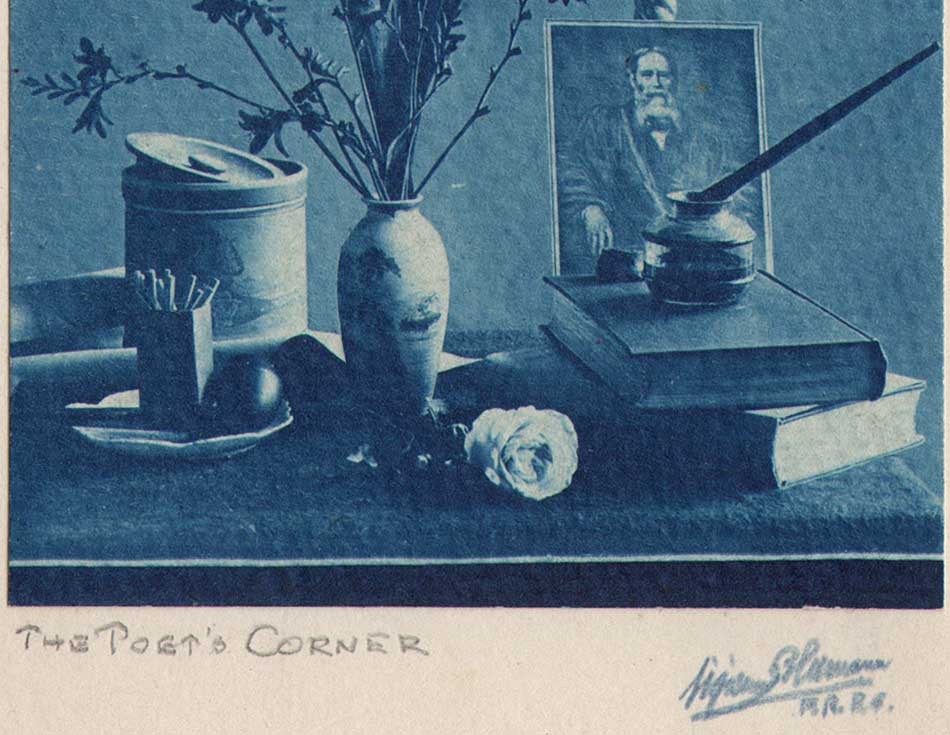 Detail: "The Poet's Corner" or "The Quiet Corner": Sigismund Blumann, American: 1933 or later: toned pigment print: 10.6 x 7.5 | 16.9 x 11.6 cm: The author's trusty pipe can be seen at left in this still-life table top study reproduced as the frontis halftone illustration for the August, 1927 issue of Camera Craft. From: PhotoSeed Archive
Detail: "The Poet's Corner" or "The Quiet Corner": Sigismund Blumann, American: 1933 or later: toned pigment print: 10.6 x 7.5 | 16.9 x 11.6 cm: The author's trusty pipe can be seen at left in this still-life table top study reproduced as the frontis halftone illustration for the August, 1927 issue of Camera Craft. From: PhotoSeed Archive
NOTES:
1. see: Early Years in Photography: “Sigismund Blumann, California Editor and Photographer”, by Christian A. Peterson in History of Photography, vol. 26, no. 1. (Spring 2002) p. 59.
2. Ibid: in: Photo Art Monthly, 1933-40: p. 73
3. It would not be until July, 1934, in an updated version of this 1925 Camera Craft article on describing the process of turning photographs into dry point etchings in Photo-Art Monthly, that evidence of Fitzpatrick and Blumann being the same person would seem to be confirmed. In it, the illustrated example of Blumann’s credited photograph titled “Land’s End” is also shown reproduced into the converted dry point etching with credit given to Fitzpatrick. Editorially, it might seem odd to continue this pen-name fiction with Blumann even going to lengths to construct a suspect history in 1925 of “Fitzpatrick’s” own beginnings although the reason was most likely intended as another way of imparting education on a topic deemed worthy and educational enough in the eyes and mind of the editor himself.
4. Copies of at least 43 documentary photographs, with several corresponding paper negative envelopes dated 1901 by Sigismund Bluman, were donated by his family to the California Historical Society where they can be viewed as part of the collection “The Chinese in California: 1850-1925.” The following link includes a smaller sampling of later printed examples, (some hand-colored) along with a rare surviving example titled “Ruin” (a detail included with this post) from 1906 of earthquake damage taken by the photographer as well as several portraits of Sig taken by others.
5. see: citation #1: p. 54.
6. excerpt: introduction: Making Photographs Into Dry Point Etchings: by Charles H. Fitzpatrick Illustrated by the Author: in: Camera Craft: October, 1925: San Francisco: p. 485.
7. see: citation #1 p. 54
8. Ibid: introduction: p. 53
9. American Prohibition was a nationwide constitutional ban on the sale, production, importation, and transportation of alcoholic beverages.
10. see: citation #1 p. 65
11. In order to make one of these etchings, the article instructs that after first selecting a printed photograph with little detail, the next step is to: “draw as much as he can on the photograph, using Higgins’ Water Proof India Ink. When this is absolutely dry the silver is completely bleached out with Bichloride of Mercury or Iodine-Iodide bleachers. The pen shading and finishing is then done with care, when the bleached and washed print has been dried.” From here, the article states a copy negative must then be made which is used to make the final second-generation finished (and reduced for effect) “etchings” using various grades of photographic paper: “The method of reproducing drawings is very simple. Place drawing on wall or easel and camera on firm support exactly centering lens on drawing, making exposure on a slow copy plate by diffused daylight or electric light, and develop for contrast. In copying it is advisable to reduce the image one-third smaller than the original as a finer line is thus secured which improves the finished print. The writer prefers a buff stock, matt paper of medium grade and heavy; and has found Vitava E just right: This is a matter of choice, however, as good prints may be secured on Azo, Velox, Cyco, Kruxo, Defender, Haloid, Barston, Charcoal Black or other matt papers. Proceed as in ordinary photographic printing then tone by re-development, using whatever process you prefer. I use Royal-Re-developer with pleasing results.” In the later 1934 article: “Etchings From and With Photographs”, “Fitzpatrick”goes further in depth on this etching process, adding that after the second-generation reduced copy print is made, the print could be “treated through all the usual solutions in the usual way and may be developed in any of the prescribed formulae for blue-black, jet-black, warm-black, or dark brown tones. Or it may be subsequently toned by the bleach and redevelop methods. The particular brown of an etching is easily gotten on Vitava Athena with a developer containing Athenon. Azo P-2 or 3, Vitava Athena E, Novira in the matt smooth or rough are all fine for the purpose. Gevalux gives a wonderful image in a true carbon black color and velvet crayon patine.” Continuing, the article offers a summary of the entire process: “That is all there is to the whole thing. You could not complicate it if you tried. Just make an enlargement, work on it with pen and ink, bleach out the silver leaving the ink image, photograph the line drawing, make as many etching-prints from the copy negative as you wish. Where can you go wrong? How can you fail?” He concludes by saying the maker of these etchings could also go “one step further by using hand-sensitized photographic papers for this final second-generation completed “etching”: “Furthermore, should you desire to print on colored papers or card- board of such surface as cannot be bought ready sensitized it will be a simple matter to sensitize any stock with the well known Blue Print solutions, or if the various shades of brown and black are wanted to resort to Kallitype. These processes are as cheap as they are easy to compound and use; they work on any paper not too saturated with chlorides or unfixed dyes. Kallitype is moreover a beautiful process in itself and prints endure according to the care in making them.”
In with the New
Posted January 2016 in New Additions, PhotoSeed, Typography, Unknown Photographers
No Junk in Trunk
Posted December 2015 in Alternate Processes, Cameras, Color Photography, New Additions, Photography, Unknown Photographers
If the story is to be believed, the contents of a mystery trunk ⎯the artistic passion of yet another unknown early 20th Century photographer ⎯have been saved once again in the name of photographic collecting. The evidence was several hundred photographs tucked inside:
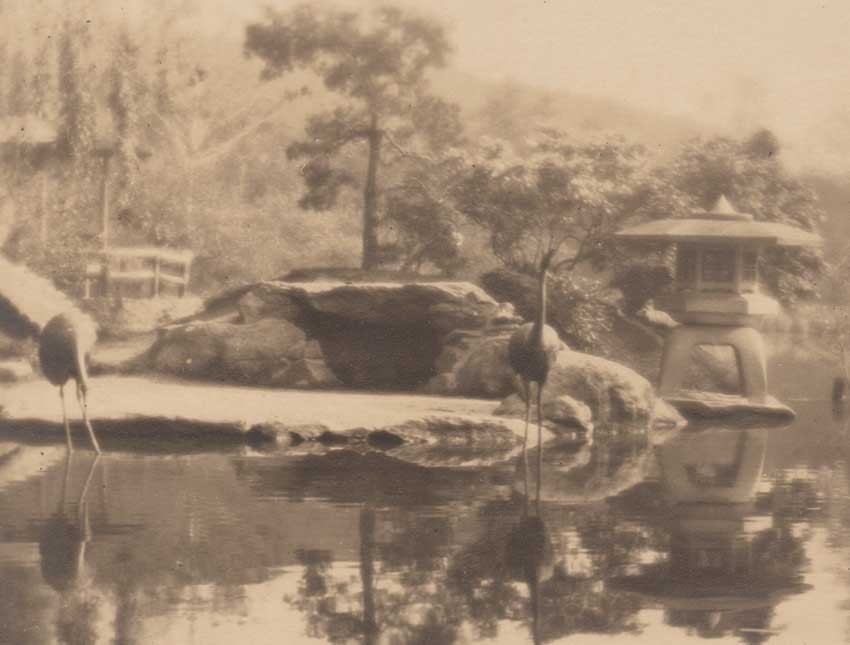 Detail: "Japanese Hill-and-Pond Garden Island" (at Brooklyn, New York Botanic Garden): ca. 1920-25: Unknown Brooklyn photographer: gelatin silver: 8.8 x 11.4 cm | 12.6 x 17.3 cm cream-colored, photographic paper stock: from: PhotoSeed Archive
Detail: "Japanese Hill-and-Pond Garden Island" (at Brooklyn, New York Botanic Garden): ca. 1920-25: Unknown Brooklyn photographer: gelatin silver: 8.8 x 11.4 cm | 12.6 x 17.3 cm cream-colored, photographic paper stock: from: PhotoSeed Archive
”The dealer had bought a trunk from an estate of a lady who had passed away.”
A story I’ve encountered before in my online foraging. My offer, in order to keep the archive together, was fortunately accepted, and now share with you a glimpse of some of these fruits.
Typically, when photographs enter this collection, initial research on origins and other factors are made and then set aside-often for years- until more deductions can be made or oftentimes additional primary source material percolates into that vast library we all humbly know as the public Internet.
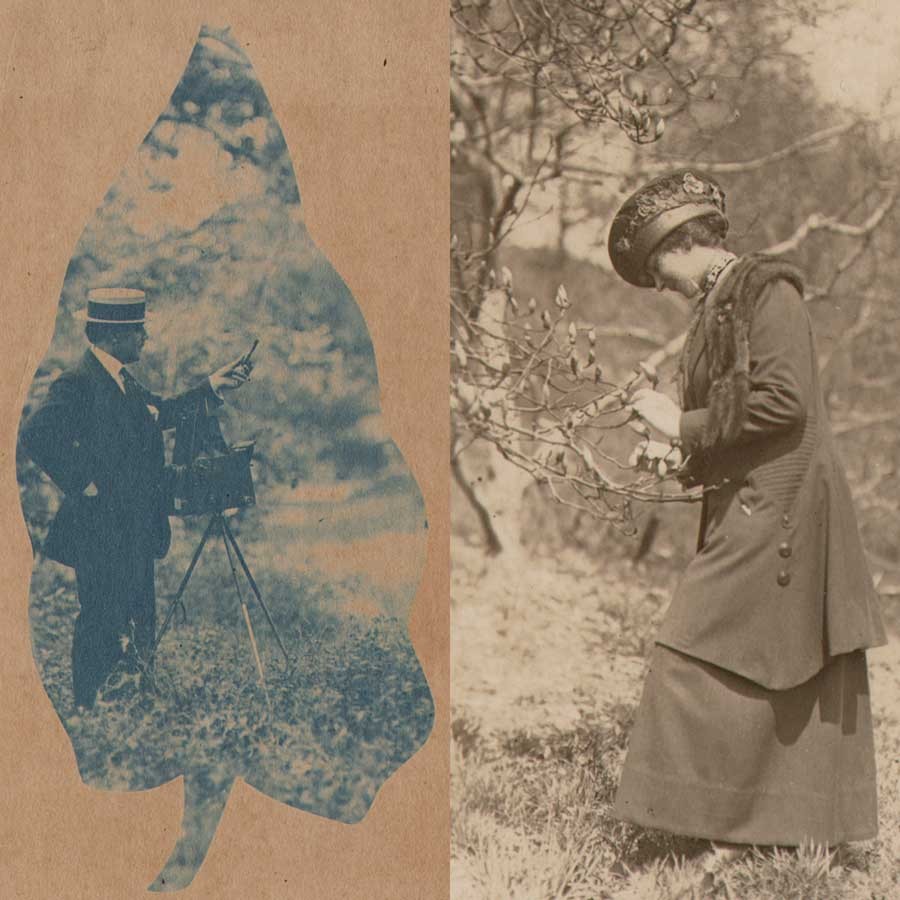 Husband & Wife? L: Detail: "Photographer in Boater Hat Behind Graflex Camera": ca. 1910-1920: Unknown Brooklyn photographer: cyanotype: 11.2 x 5.2 cm | 14.6 x 8.2 cm: image printed within leaf shape on thin cream-colored paper: R: Detail: "Woman Examining Magnolia Blossom": ca. 1910-1920: Unknown Brooklyn photographer: gelatin silver: 11.1 x 7.3 cm | 17.1 x 10.5 cm: both from: PhotoSeed Archive
Husband & Wife? L: Detail: "Photographer in Boater Hat Behind Graflex Camera": ca. 1910-1920: Unknown Brooklyn photographer: cyanotype: 11.2 x 5.2 cm | 14.6 x 8.2 cm: image printed within leaf shape on thin cream-colored paper: R: Detail: "Woman Examining Magnolia Blossom": ca. 1910-1920: Unknown Brooklyn photographer: gelatin silver: 11.1 x 7.3 cm | 17.1 x 10.5 cm: both from: PhotoSeed Archive
But exceptions, at least in my world, always exist. For these latest trunk photographs coming to light, my discovery a small portion documenting a place and event celebrating 100 year anniversaries in 2015 were primary motivators in showcasing them now with this post. These were the establishment of the Japanese Hill-and-Pond Garden in 1915 at the Brooklyn Botanic Garden, considered the first Japanese garden created in an American public garden, as well as a small cache of photographs taken the same year at the Panama-Pacific International Exposition in San Francisco, California.
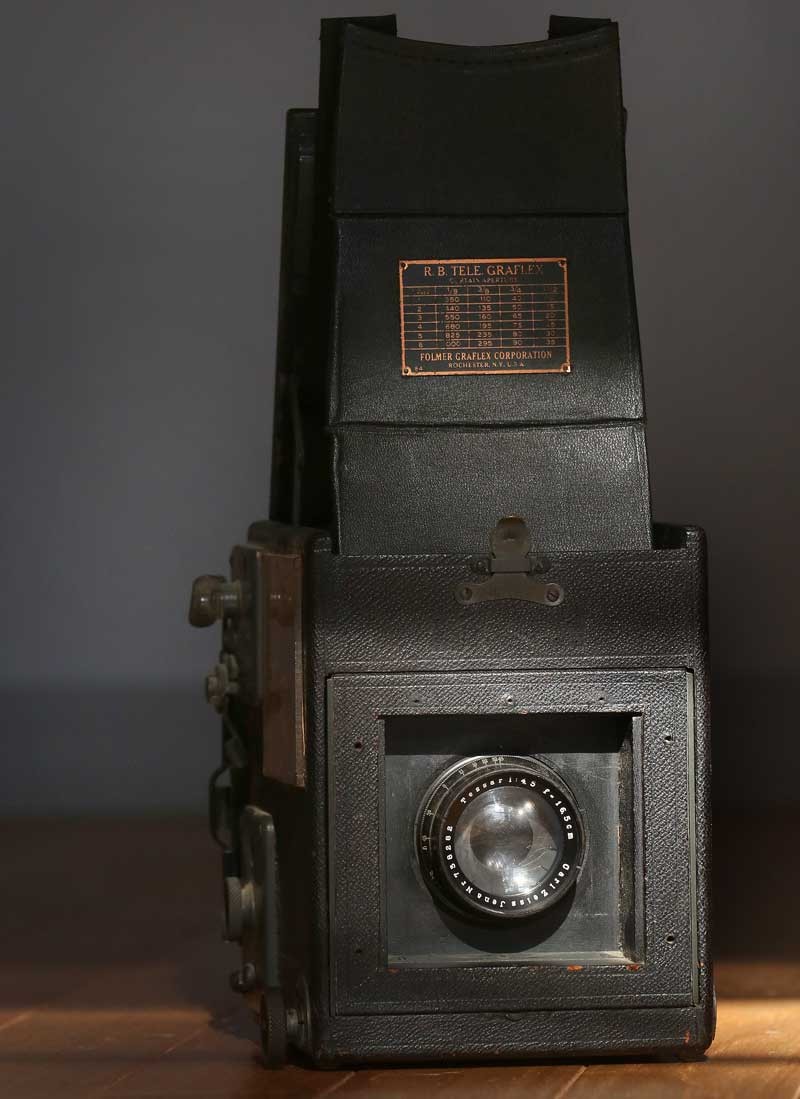 R.B.Tele-Graflex Camera outfitted with Carl Zeiss Tessar lens ca. 1913 (last patent is for June of this year on camera bottom) Manufactured by the Folmer Graflex Corporation, Rochester, New York. The Unknown Brooklyn photographer who took the images seen with this post used a similar Graflex model pictured in the above cyanotype. Lightweight so it could be carried in the field and used on a tripod or hand-held, it features a revolving back so the glass or cut film plates loaded into individual holders could be oriented on the camera back for a vertical or horizontal field of view. The photographer looked through the top of the camera (shown in open position here) and focused on the ground glass inside while bringing the subject into focus by manipulating the bellows (not extended in this photo) using the knob located at the far left of the lens board on lower side of camera. from: PhotoSeed Archive
R.B.Tele-Graflex Camera outfitted with Carl Zeiss Tessar lens ca. 1913 (last patent is for June of this year on camera bottom) Manufactured by the Folmer Graflex Corporation, Rochester, New York. The Unknown Brooklyn photographer who took the images seen with this post used a similar Graflex model pictured in the above cyanotype. Lightweight so it could be carried in the field and used on a tripod or hand-held, it features a revolving back so the glass or cut film plates loaded into individual holders could be oriented on the camera back for a vertical or horizontal field of view. The photographer looked through the top of the camera (shown in open position here) and focused on the ground glass inside while bringing the subject into focus by manipulating the bellows (not extended in this photo) using the knob located at the far left of the lens board on lower side of camera. from: PhotoSeed Archive
But there’s more as they say. Many of the photographs: gorgeous little jewels printed directly onto small impressed and ruled pieces of photographic paper which act as mounts-some toned in verdant hues of green for landscapes, blues for seascapes and others beautifully hand-colored, are known to have been taken in the mother of the Brooklyn Botanic Garden itself, the expansive 585-acre Prospect Park designed by Frederick Law Olmsted and Calvert Vaux- Brooklyn’s version of New York City’s Central Park which is celebrating its’ 150th anniversary in 2016.
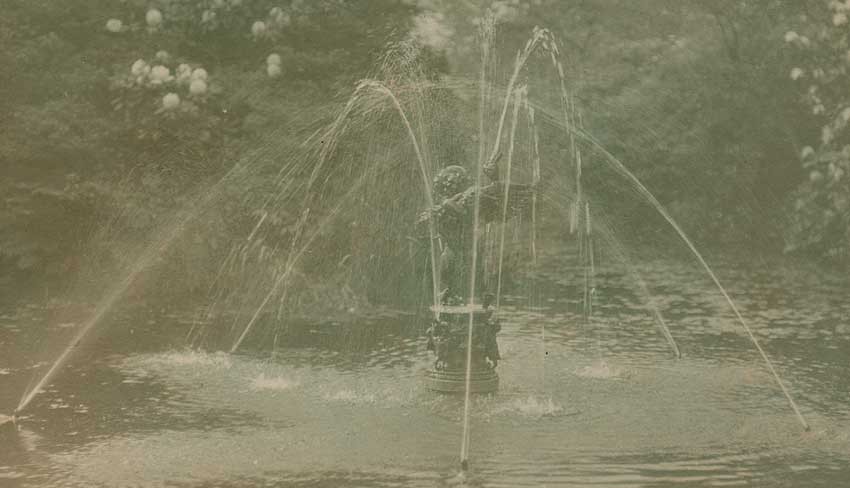 Detail: "Boy and Duck Fountain in Vale of Cashmere", sculpture by Frederick William MacMonnies, American: 1863-1937 (at Brooklyn Botanic Garden): ca. 1910-20: Unknown Brooklyn photographer: green toned gelatin silver: 8.8 x 11.6 cm|12.4 x 16.9 cm: from: PhotoSeed Archive
Detail: "Boy and Duck Fountain in Vale of Cashmere", sculpture by Frederick William MacMonnies, American: 1863-1937 (at Brooklyn Botanic Garden): ca. 1910-20: Unknown Brooklyn photographer: green toned gelatin silver: 8.8 x 11.6 cm|12.4 x 16.9 cm: from: PhotoSeed Archive
Frustratingly, the photographer’s identity responsible for these fruits is presently unknown, other than a cyanotype image included with the collection showing a dapper gentleman believed to be this person standing behind a tripod-mounted Graflex model camera. Photographically printed within the outlines of a leaf while standing in a park-like setting, he wears a straw boater hat while dressed in a suit and raises his hand clenching a pipe towards the scene before him as if to say, “now that’s a scene worthy of my camera”, or something to that effect.
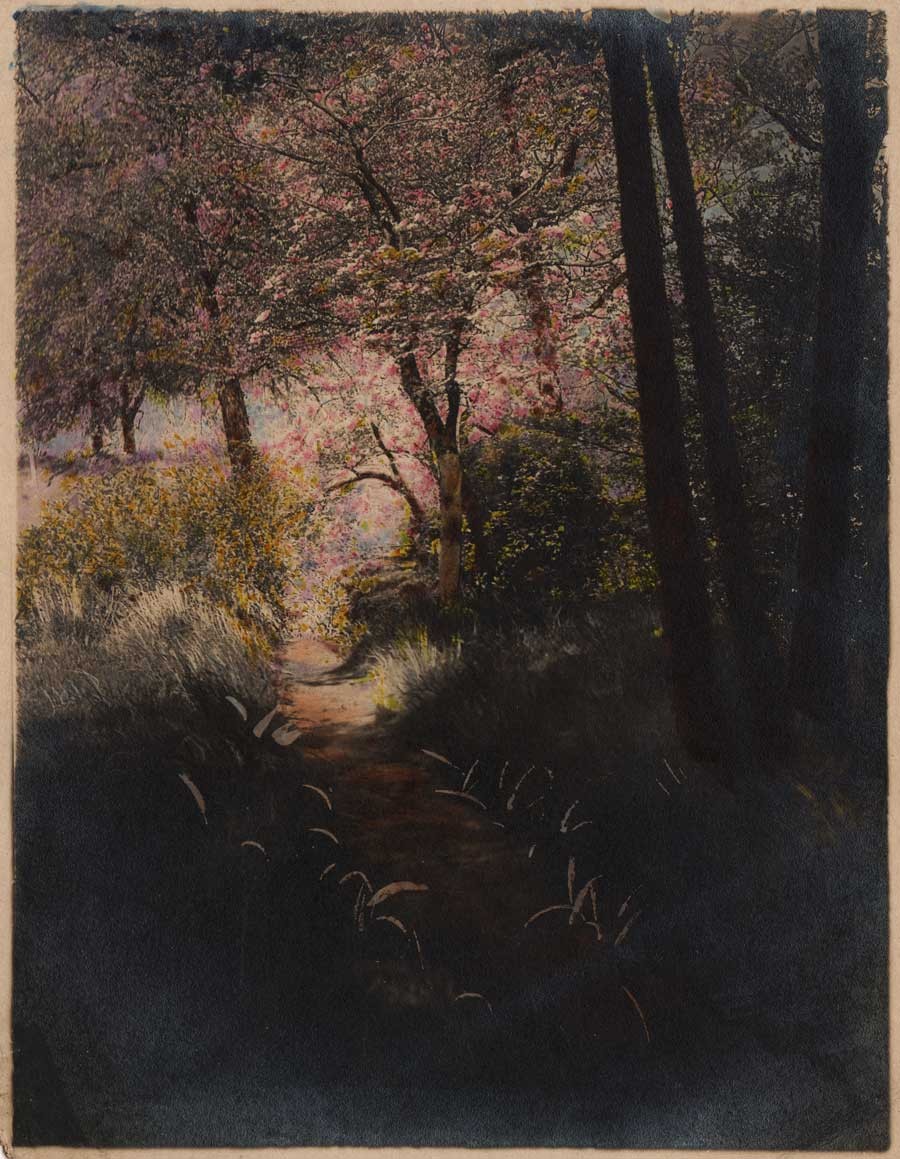 "Spring at Prospect Park"(Brooklyn, New York): ca. 1910-20: Unknown Brooklyn photographer: hand-colored gelatin silver: 11.8 x 9.0 cm | 13.2 x 9.9 cm: from: PhotoSeed Archive
"Spring at Prospect Park"(Brooklyn, New York): ca. 1910-20: Unknown Brooklyn photographer: hand-colored gelatin silver: 11.8 x 9.0 cm | 13.2 x 9.9 cm: from: PhotoSeed Archive
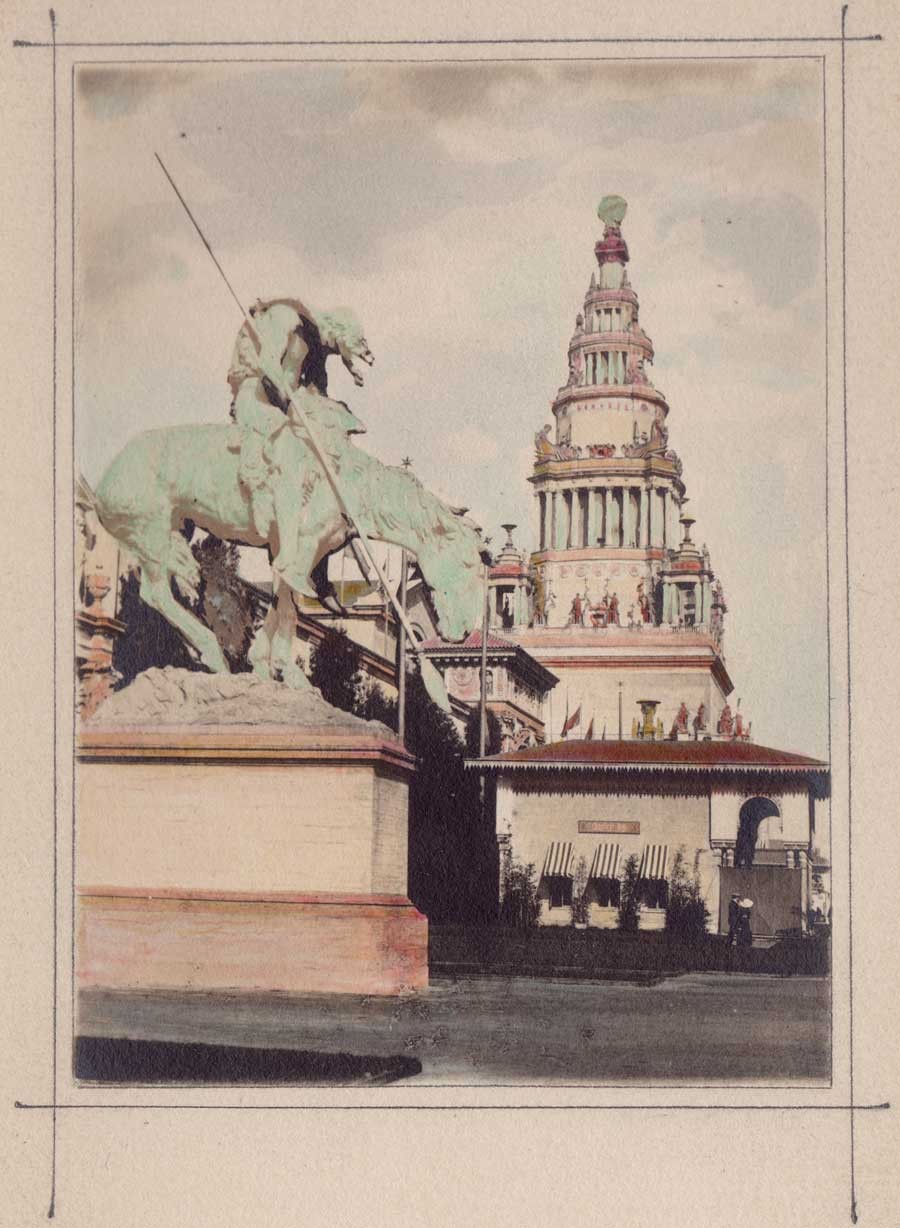 "The End of the Trail": sculpture by James Earle Fraser (American: 1876-1953) at Panama-Pacific International Exposition, San Francisco, California (Tower of Jewels in background) : 1915: Unknown Brooklyn photographer: hand-ruled & colored gelatin silver: 11.0 x 8.0 cm | 17.1 x 11.5 cm: from: PhotoSeed Archive
"The End of the Trail": sculpture by James Earle Fraser (American: 1876-1953) at Panama-Pacific International Exposition, San Francisco, California (Tower of Jewels in background) : 1915: Unknown Brooklyn photographer: hand-ruled & colored gelatin silver: 11.0 x 8.0 cm | 17.1 x 11.5 cm: from: PhotoSeed Archive
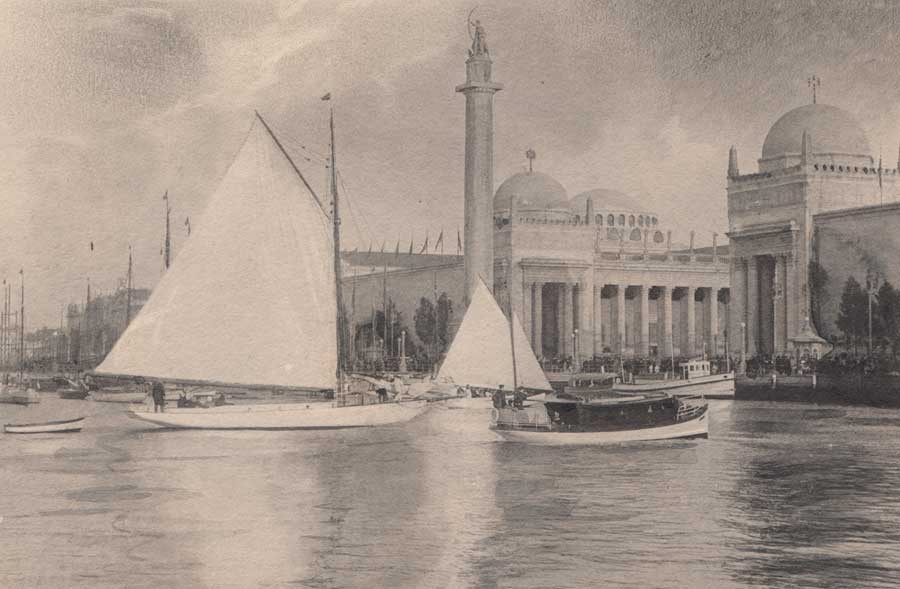 Detail: "Yacht Harbor at Panama-Pacific International Exposition" (Palaces of Agriculture & Transportation in background): 1915: Unknown Brooklyn photographer: gelatin silver with ink wash & photographic border: 7.4 x 11.5 cm | 11.4 x 17.8 cm: from: PhotoSeed Archive
Detail: "Yacht Harbor at Panama-Pacific International Exposition" (Palaces of Agriculture & Transportation in background): 1915: Unknown Brooklyn photographer: gelatin silver with ink wash & photographic border: 7.4 x 11.5 cm | 11.4 x 17.8 cm: from: PhotoSeed Archive
Several other photographs showing an unknown woman, most likely the photographer’s wife, or perhaps the artist herself, (can’t be ruled out) were also included in the trunk photographs. In one, a full-length profile view, she examines a Magnolia blossom in a park setting. (shown here) In another, her gaze is directed towards the camera while wearing an Asian influenced floral dress posing in front of blooming Wisteria vines. The dealer who had initially acquired the photographs, according to the seller I purchased them from, stated they had been acquired from the estate of a woman, (most likely depicted in the photographs) who had (presumably) attended or graduated from Wesleyan Female College, (now Wesleyan College) in Macon, Georgia at the turn of the 20th Century.
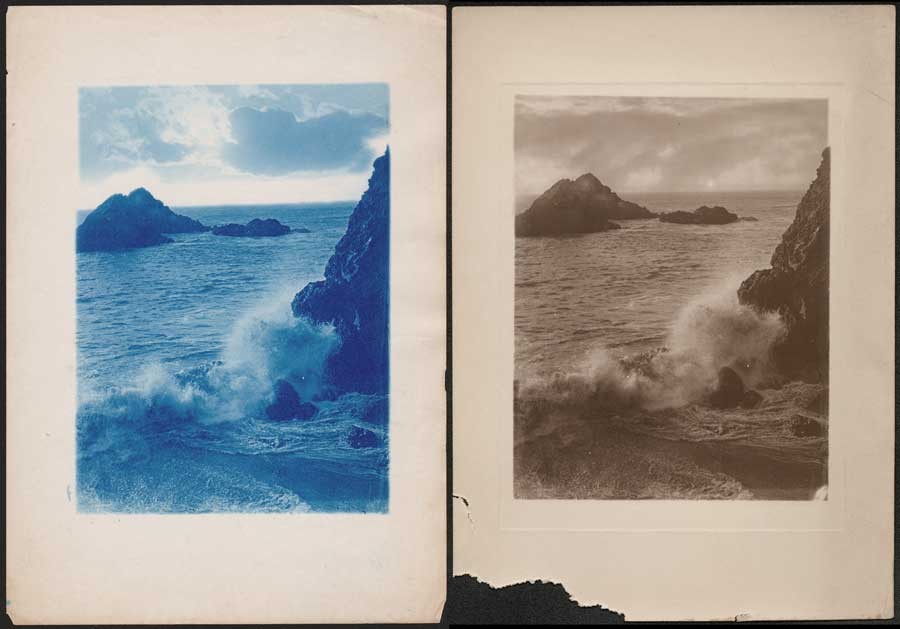 L: "Coastline with Rocks & Wave Action" (possibly California ) :12.3 x 9.0 cm | 17.7 x 12.6 cm: ca. 1910-1920: Unknown Brooklyn photographer: cyanotype with addition of clouds from alternate source photo: R: variant: "Coastline with Rocks & Wave Action" (possibly California) : 11.5 x 9.0 cm | 17.6 x 12.7 cm: ca. 1910-1920: Unknown Brooklyn photographer: gelatin silver: (mouse damage to lower margin): both from: PhotoSeed Archive
L: "Coastline with Rocks & Wave Action" (possibly California ) :12.3 x 9.0 cm | 17.7 x 12.6 cm: ca. 1910-1920: Unknown Brooklyn photographer: cyanotype with addition of clouds from alternate source photo: R: variant: "Coastline with Rocks & Wave Action" (possibly California) : 11.5 x 9.0 cm | 17.6 x 12.7 cm: ca. 1910-1920: Unknown Brooklyn photographer: gelatin silver: (mouse damage to lower margin): both from: PhotoSeed Archive
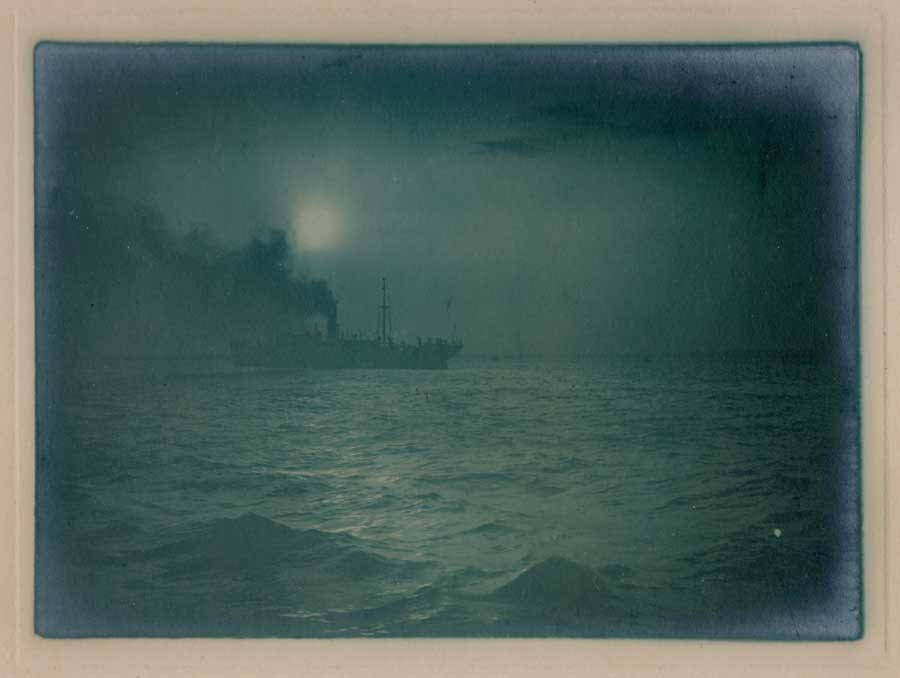 "Steamer in New York Harbor": ca. 1910-20: Unknown Brooklyn photographer: green toned gelatin silver: 8.4 x 11.6 cm | 12.3 x 17.9 cm: from: PhotoSeed Archive
"Steamer in New York Harbor": ca. 1910-20: Unknown Brooklyn photographer: green toned gelatin silver: 8.4 x 11.6 cm | 12.3 x 17.9 cm: from: PhotoSeed Archive
And even though the photographs ended their life residing in a mystery trunk in the American South, I’ll label them for now as being the work of Unknown Brooklyn, in order to keep their attribution consistent for those searching this archive going forward.
